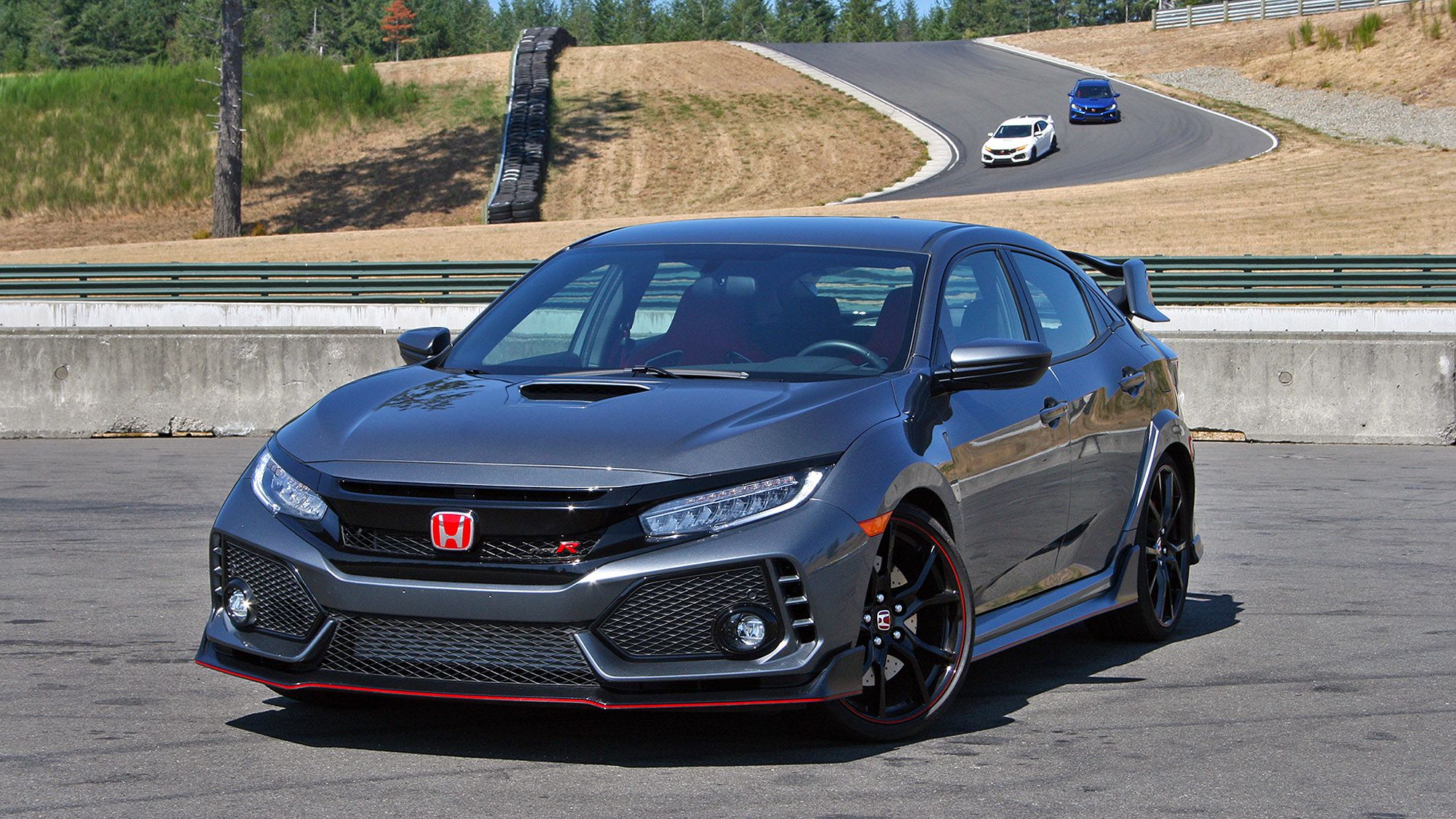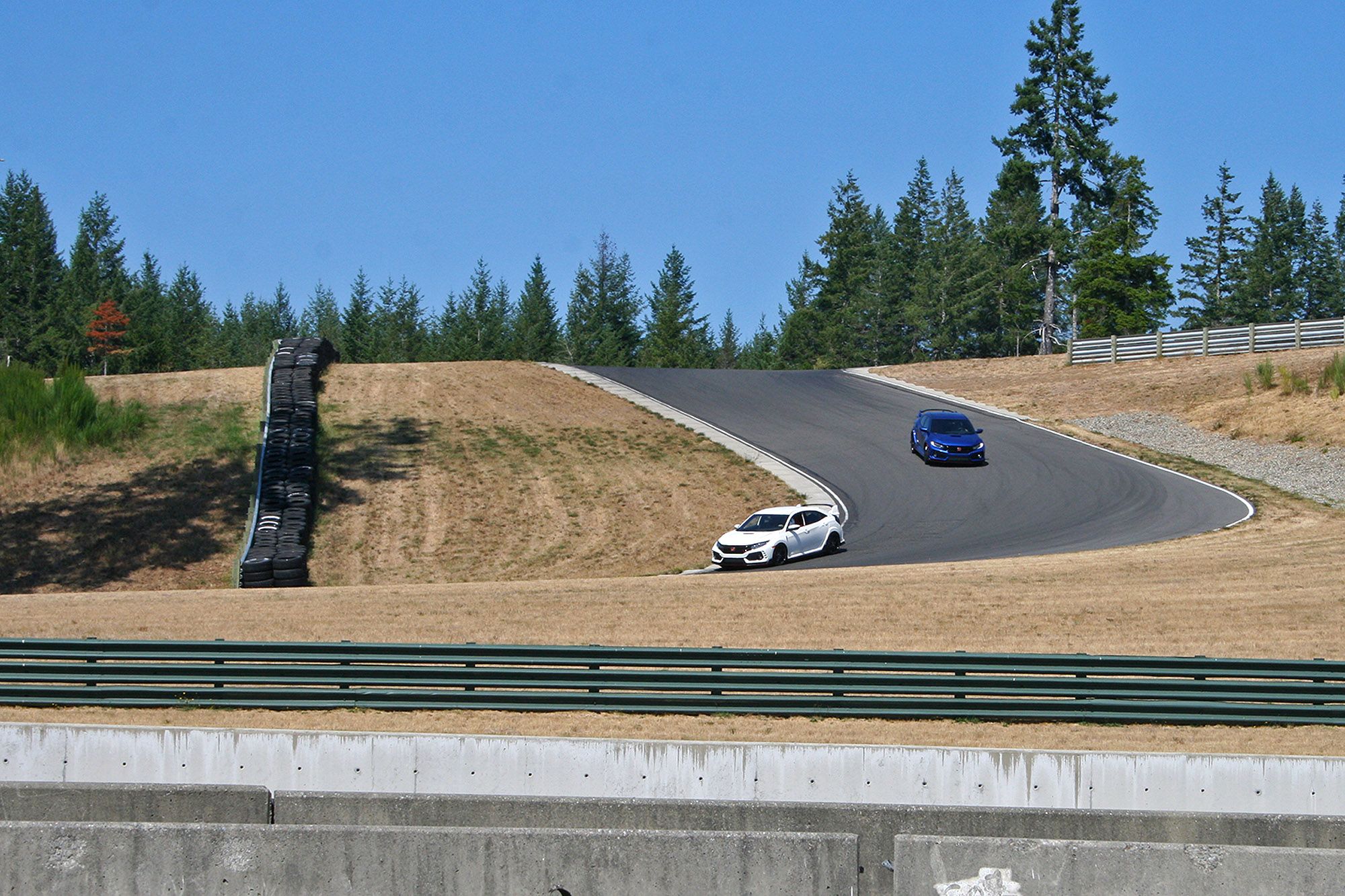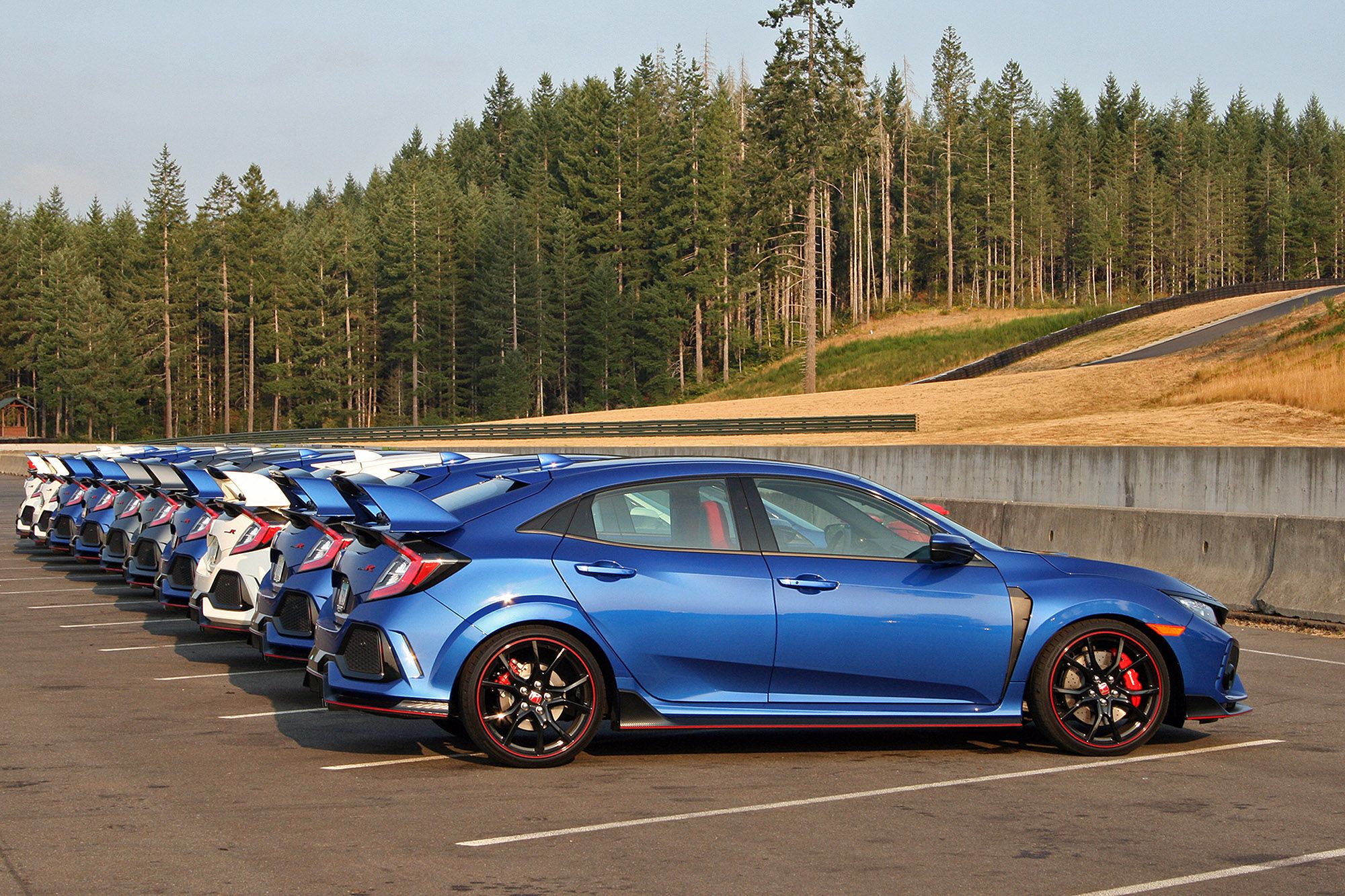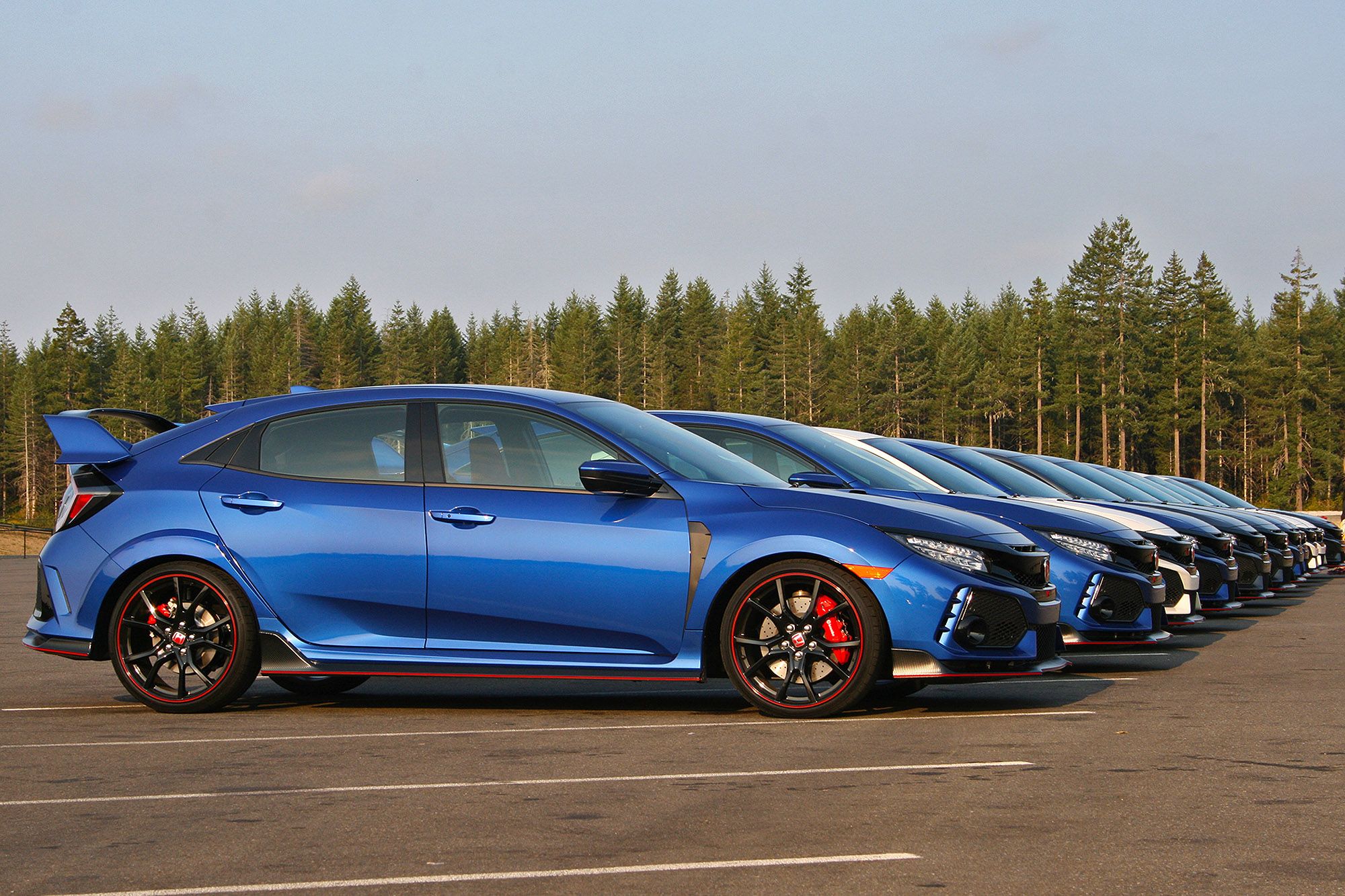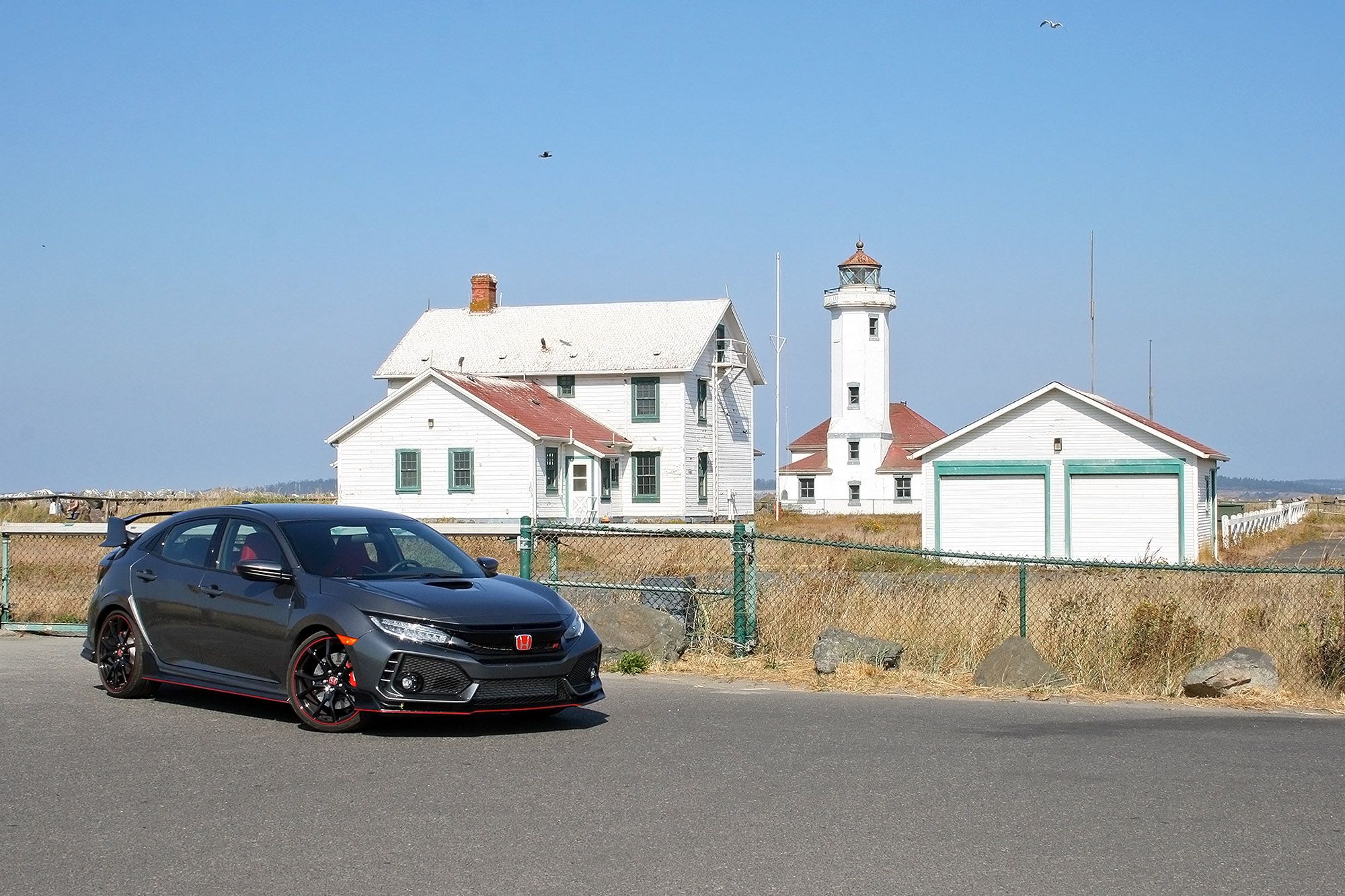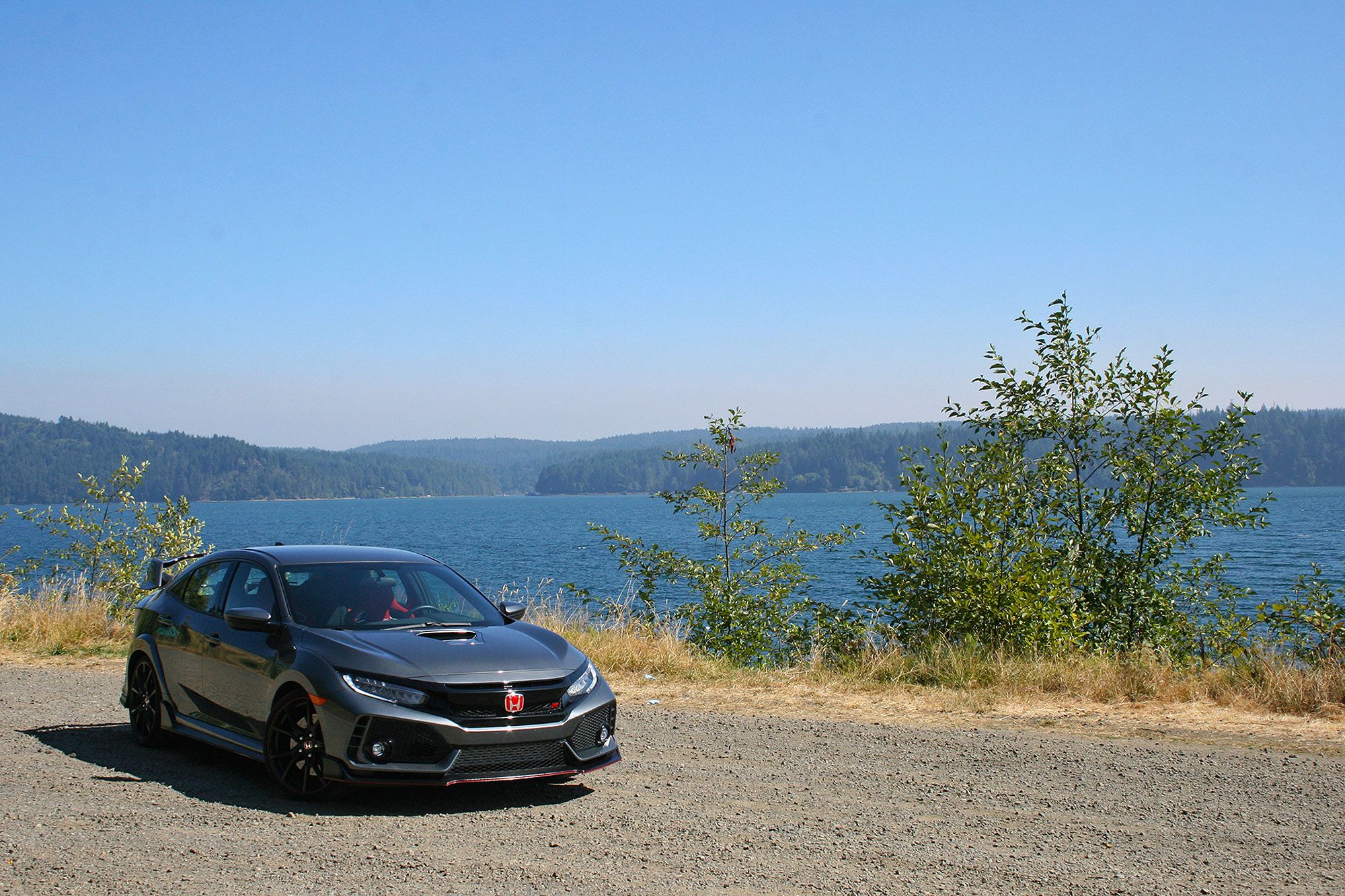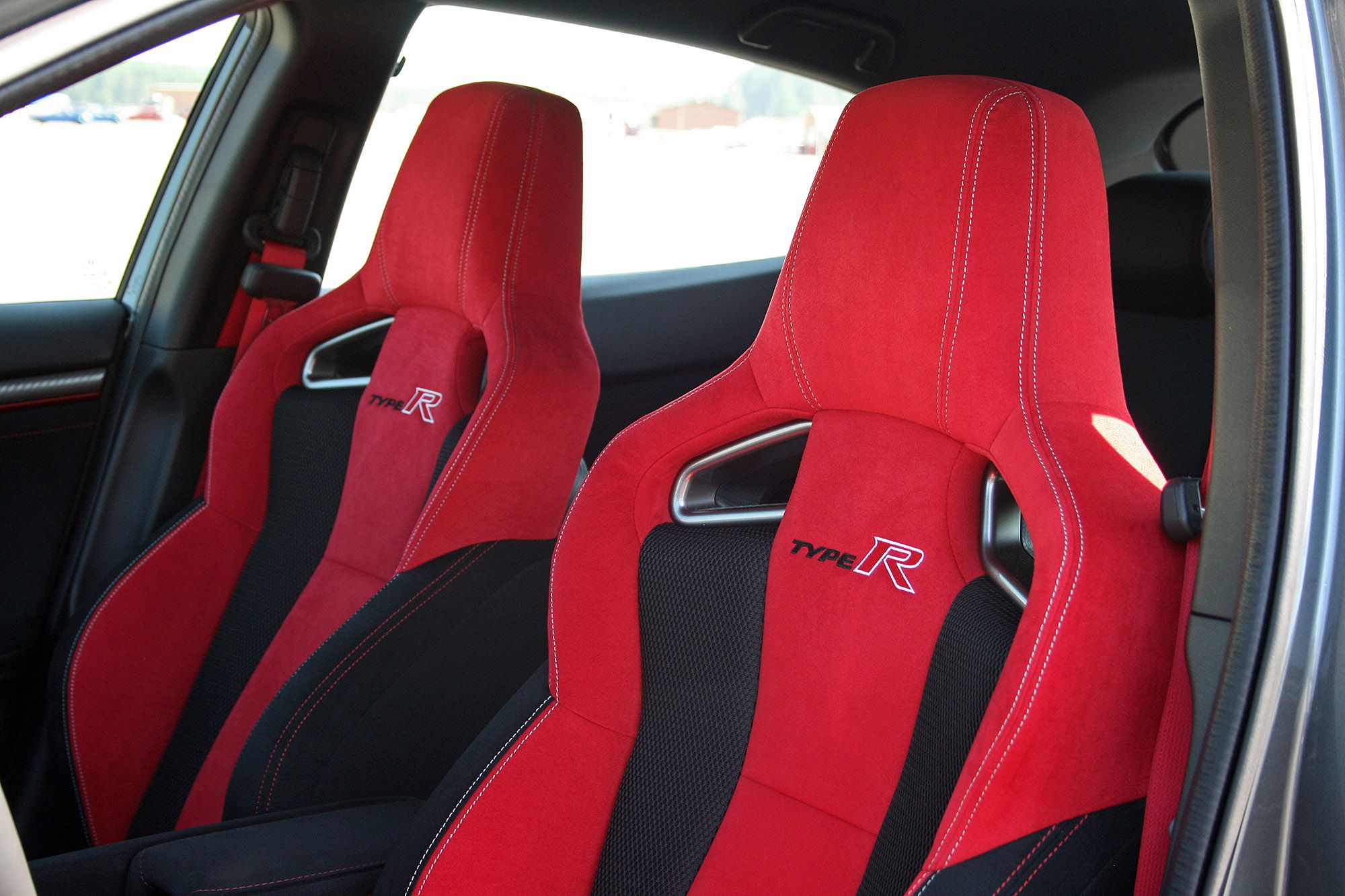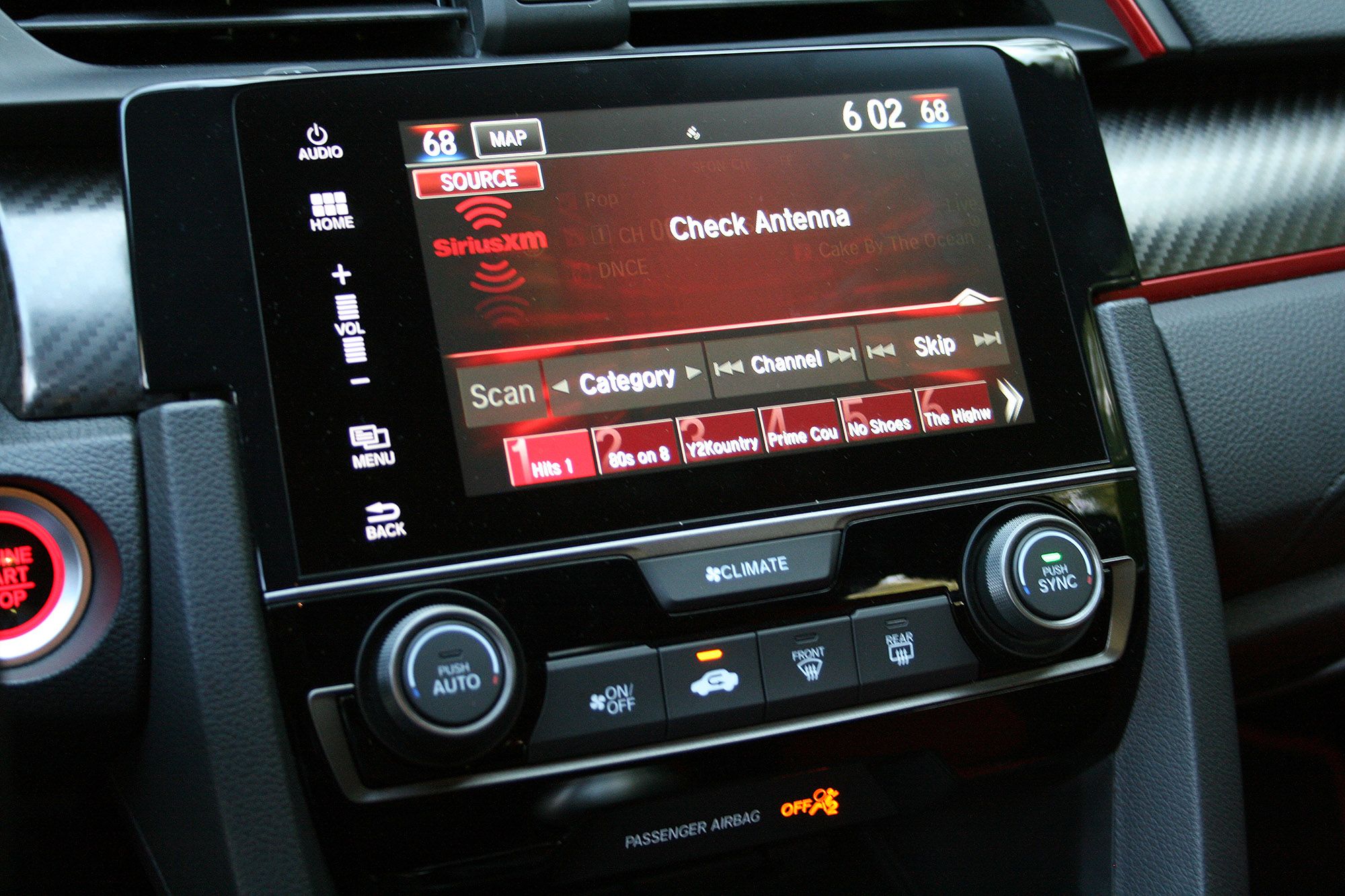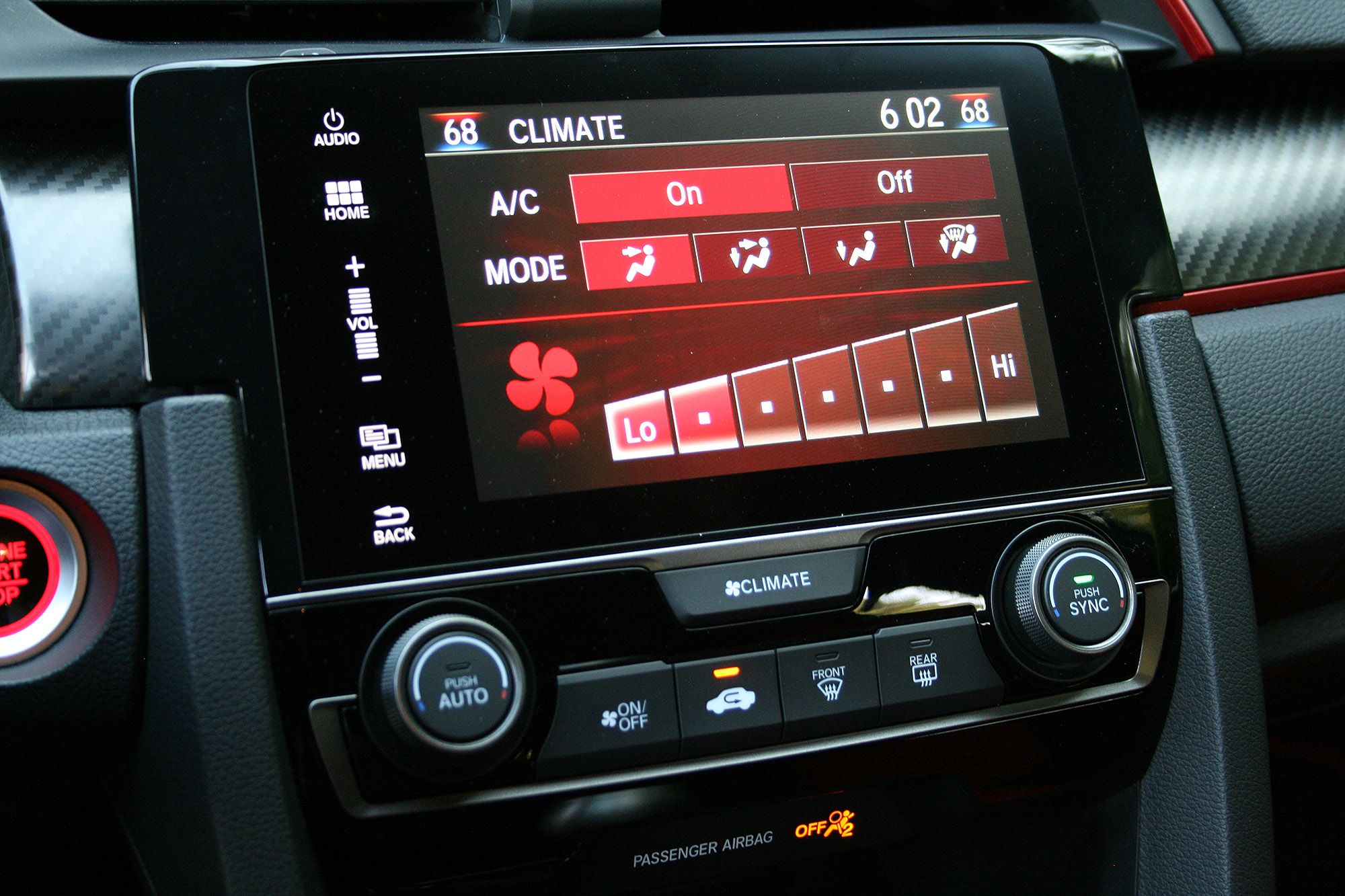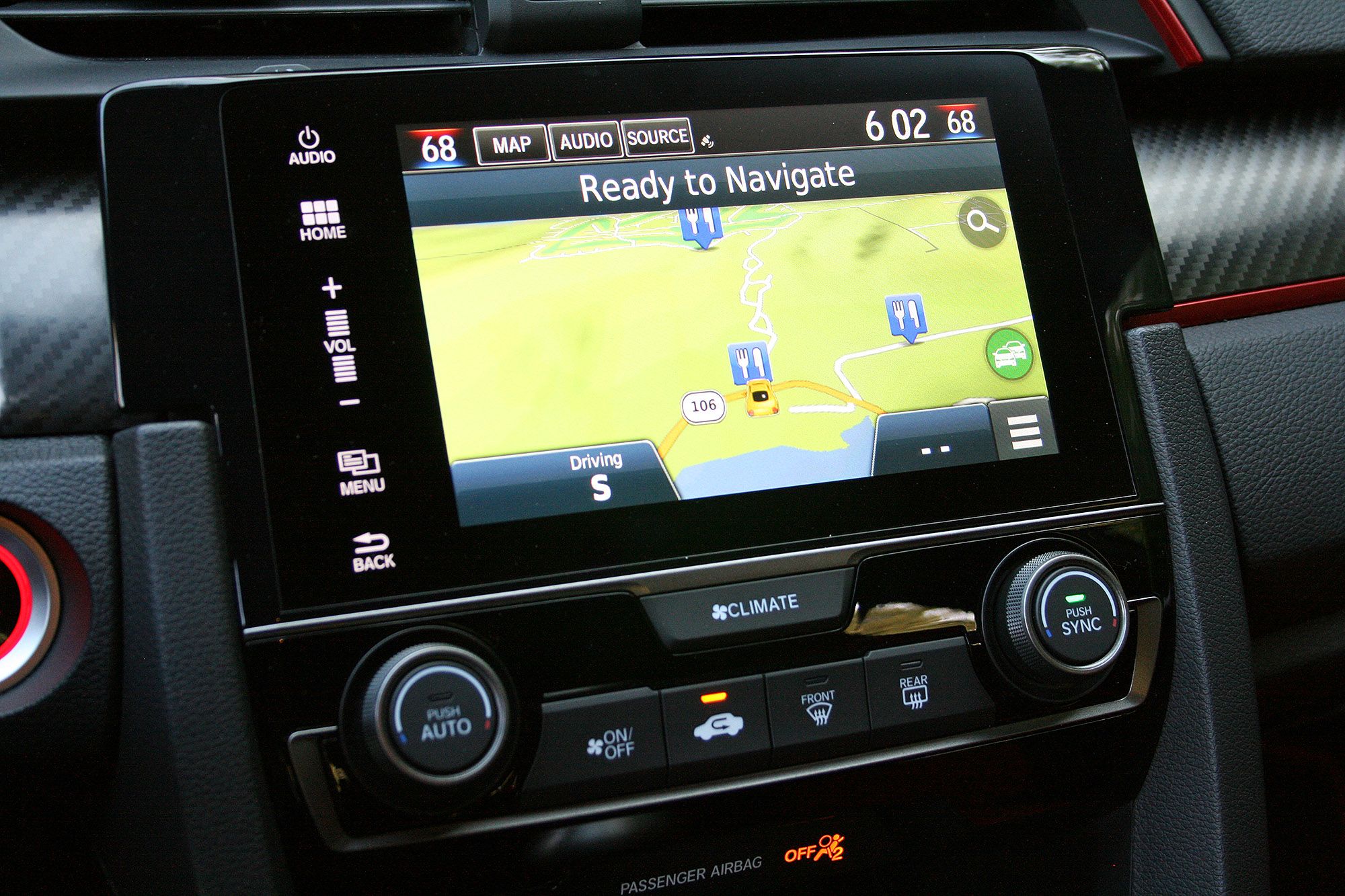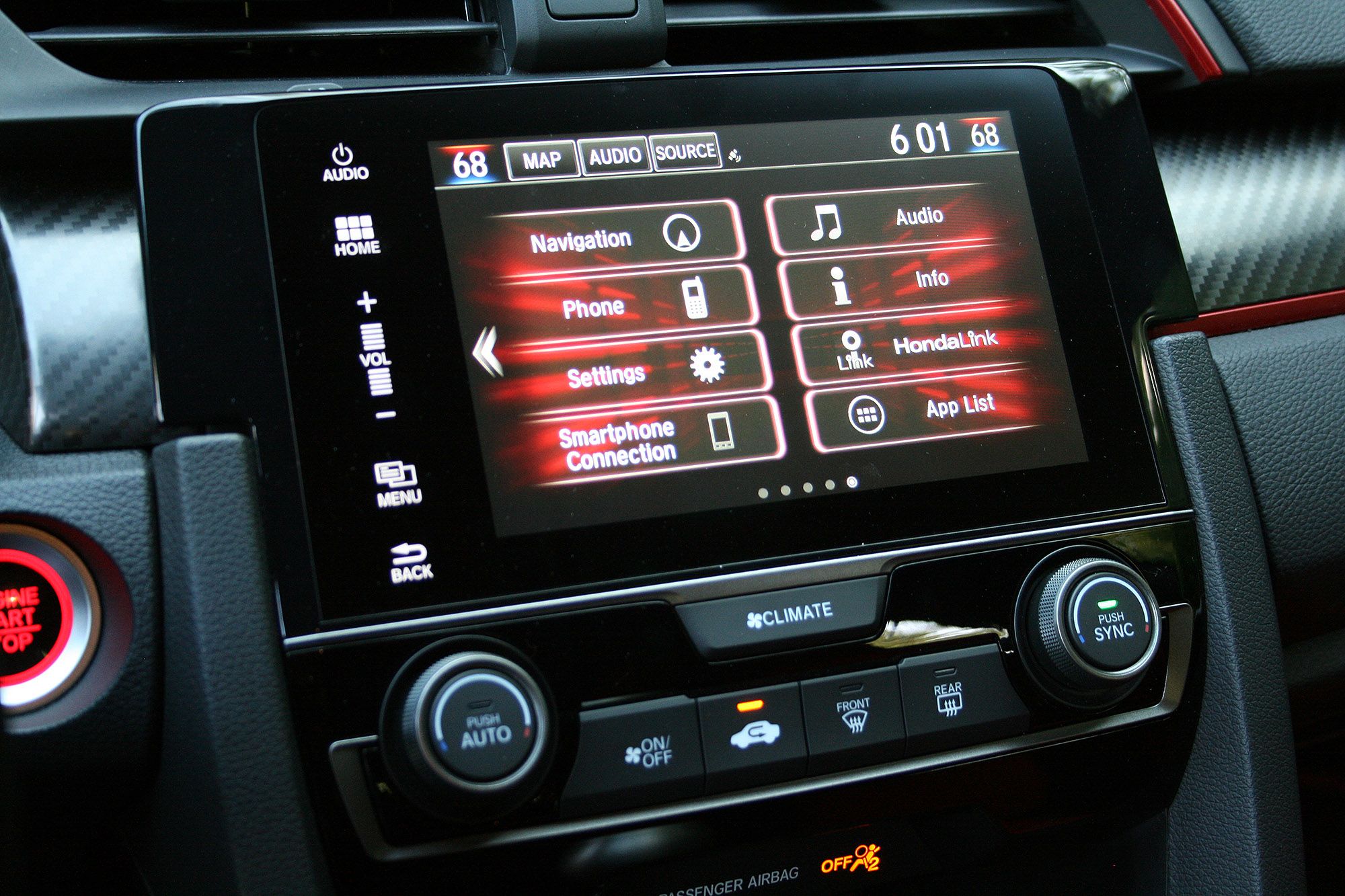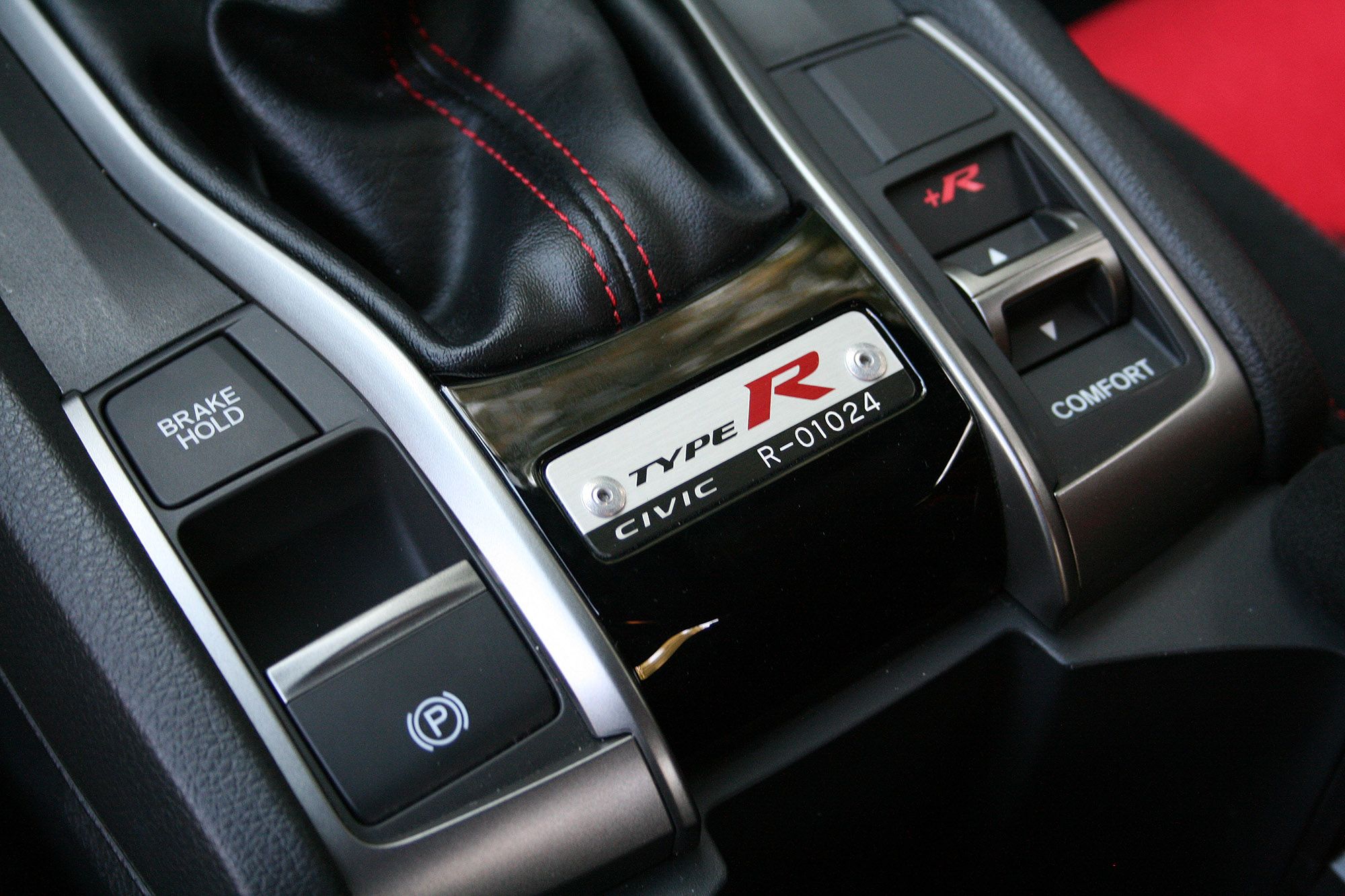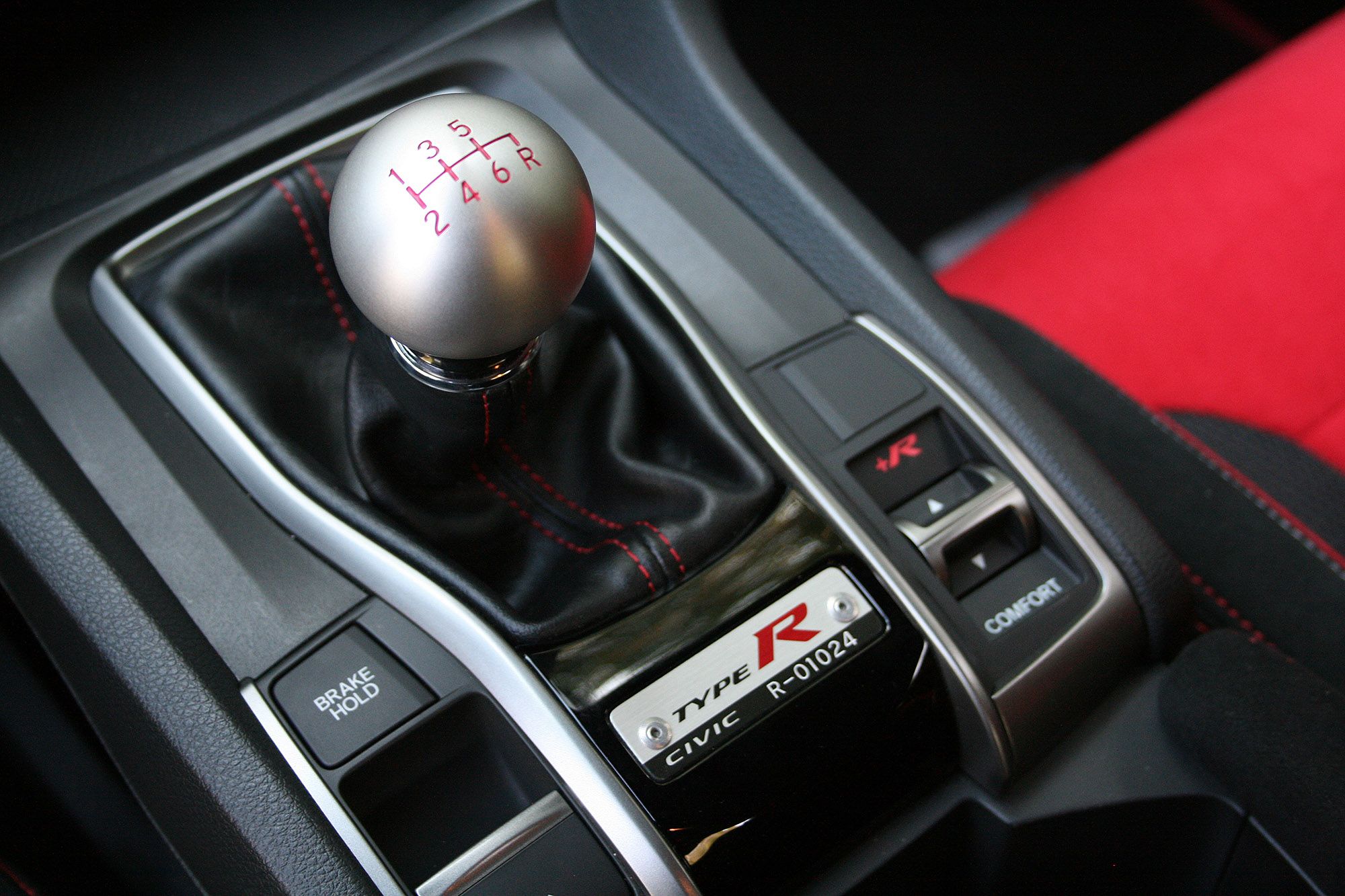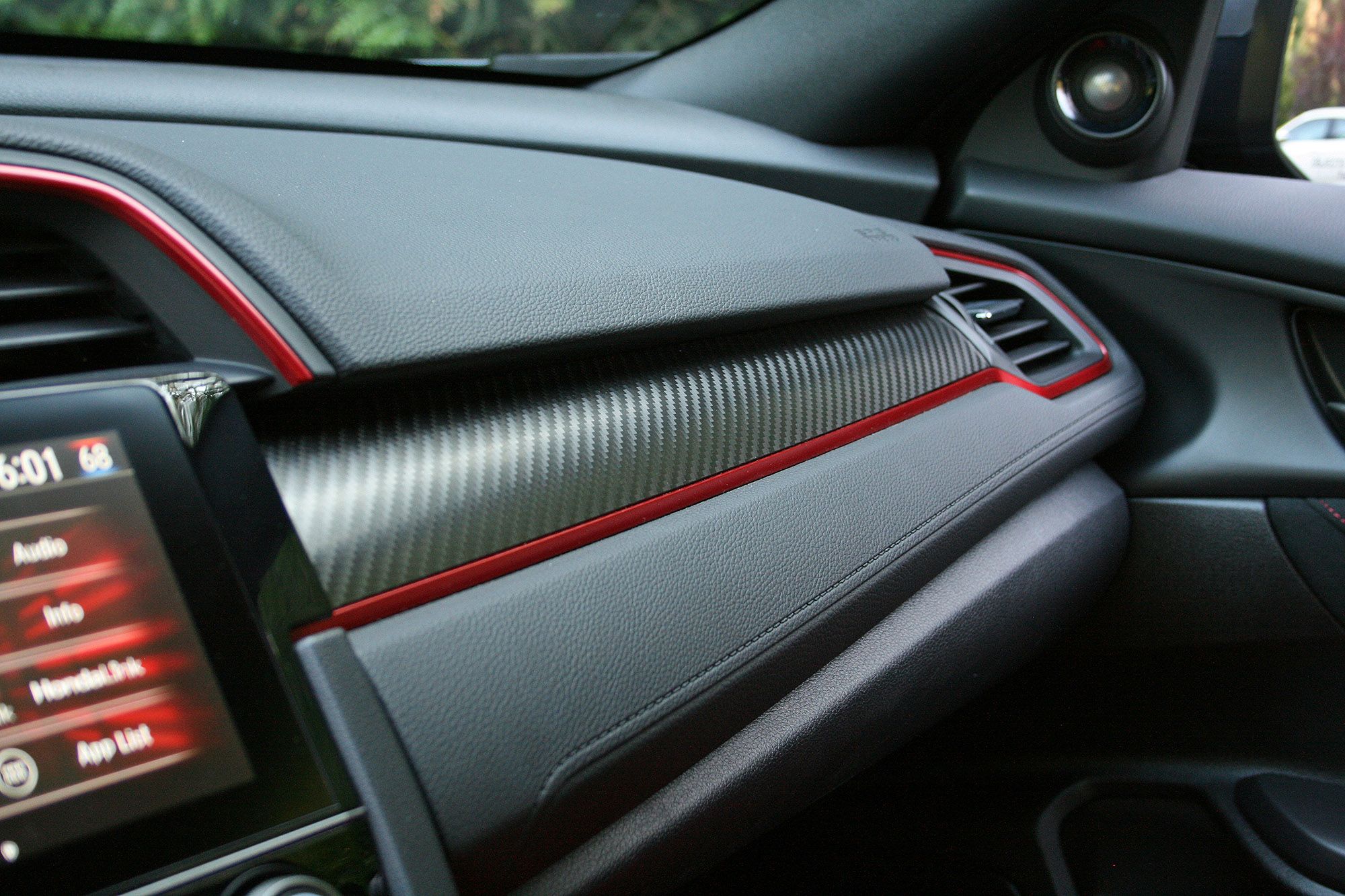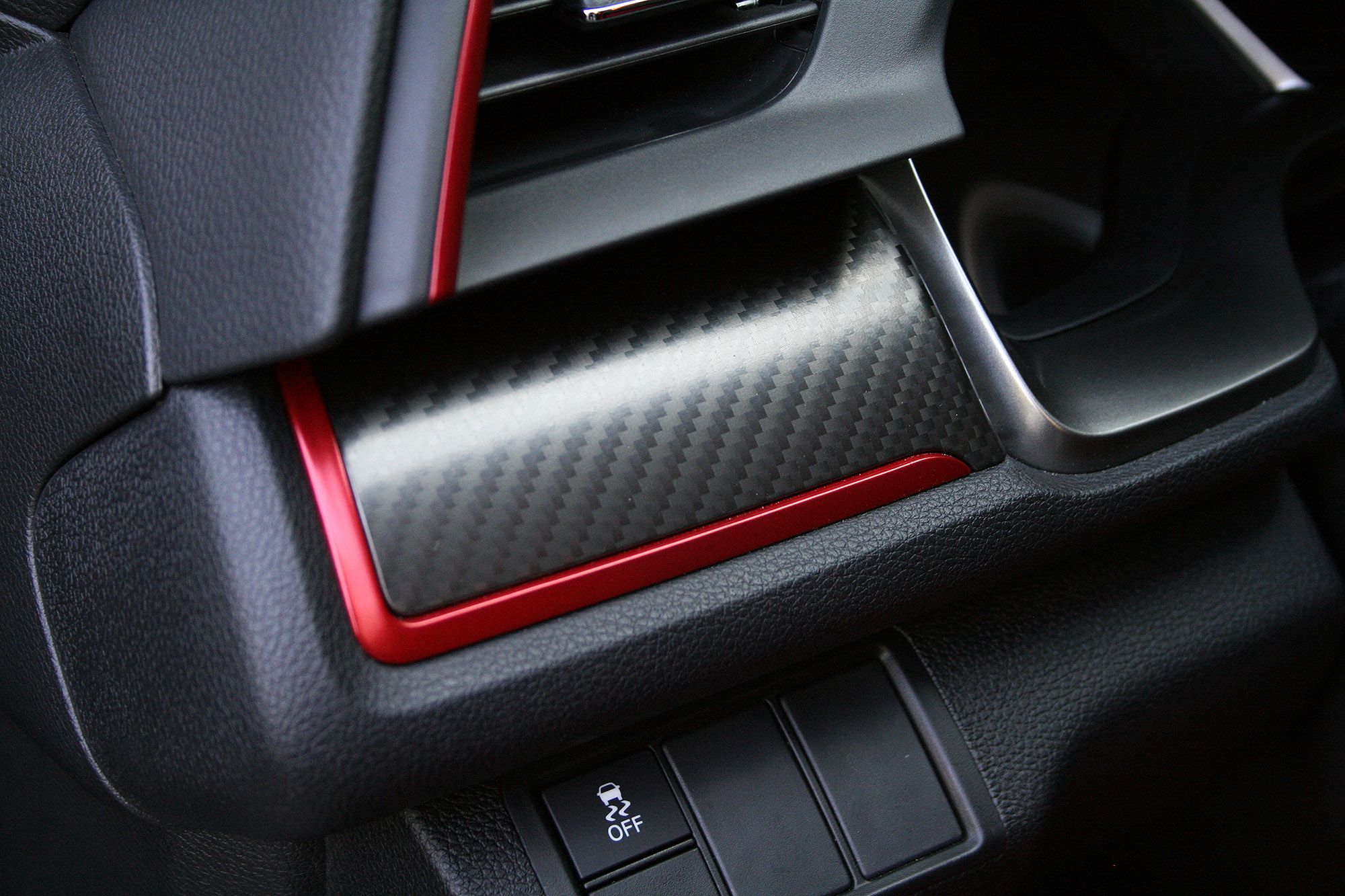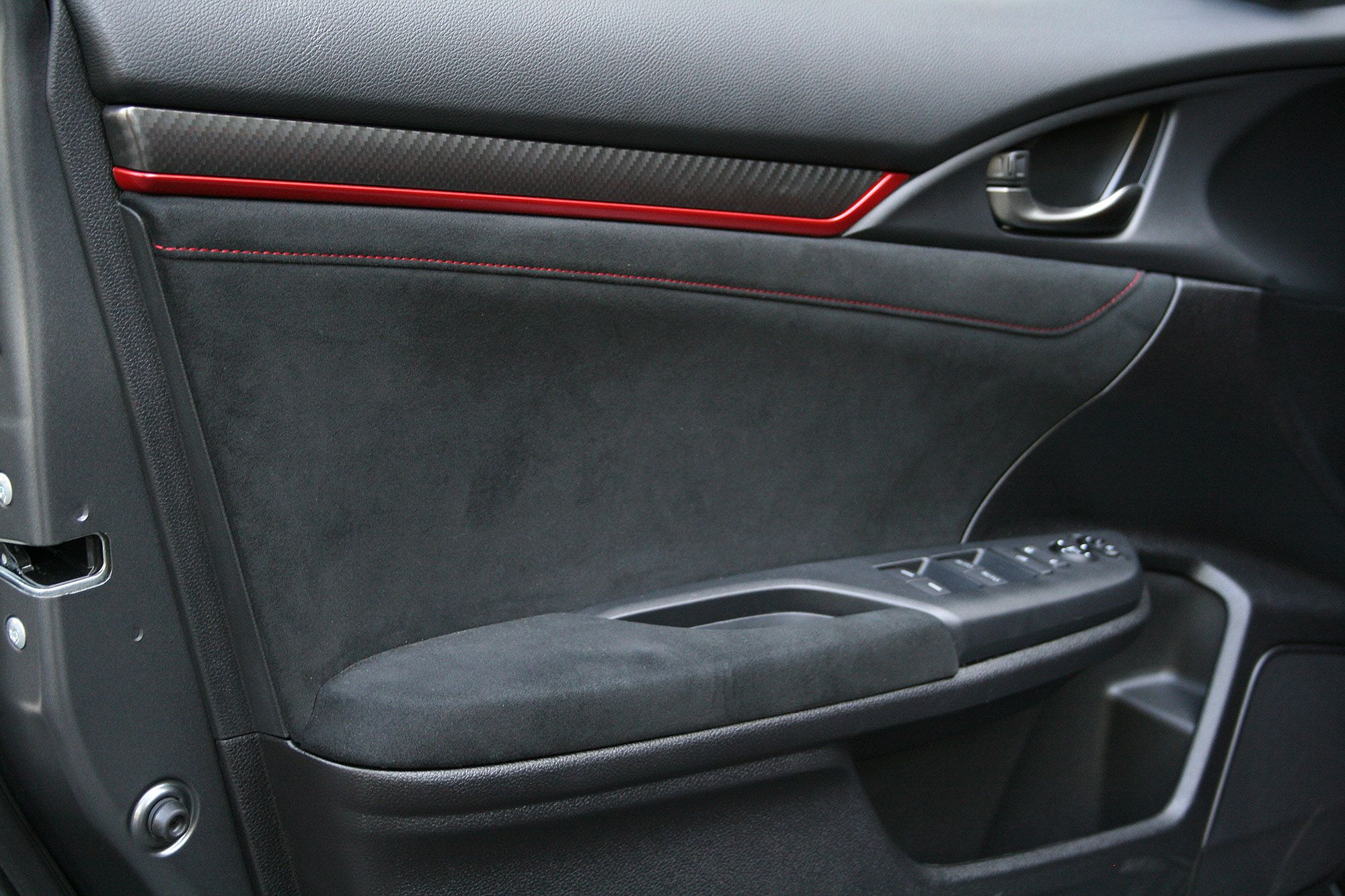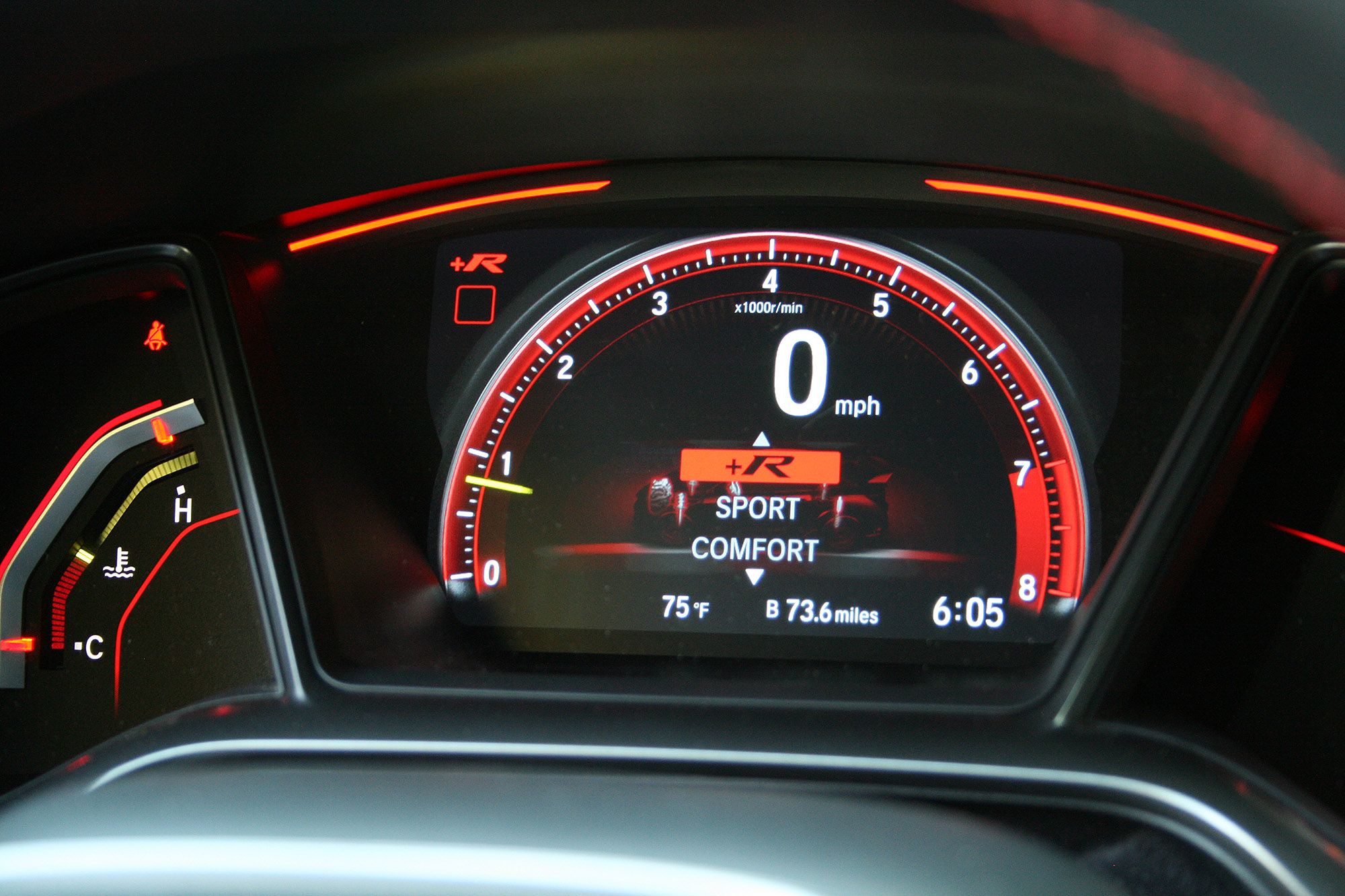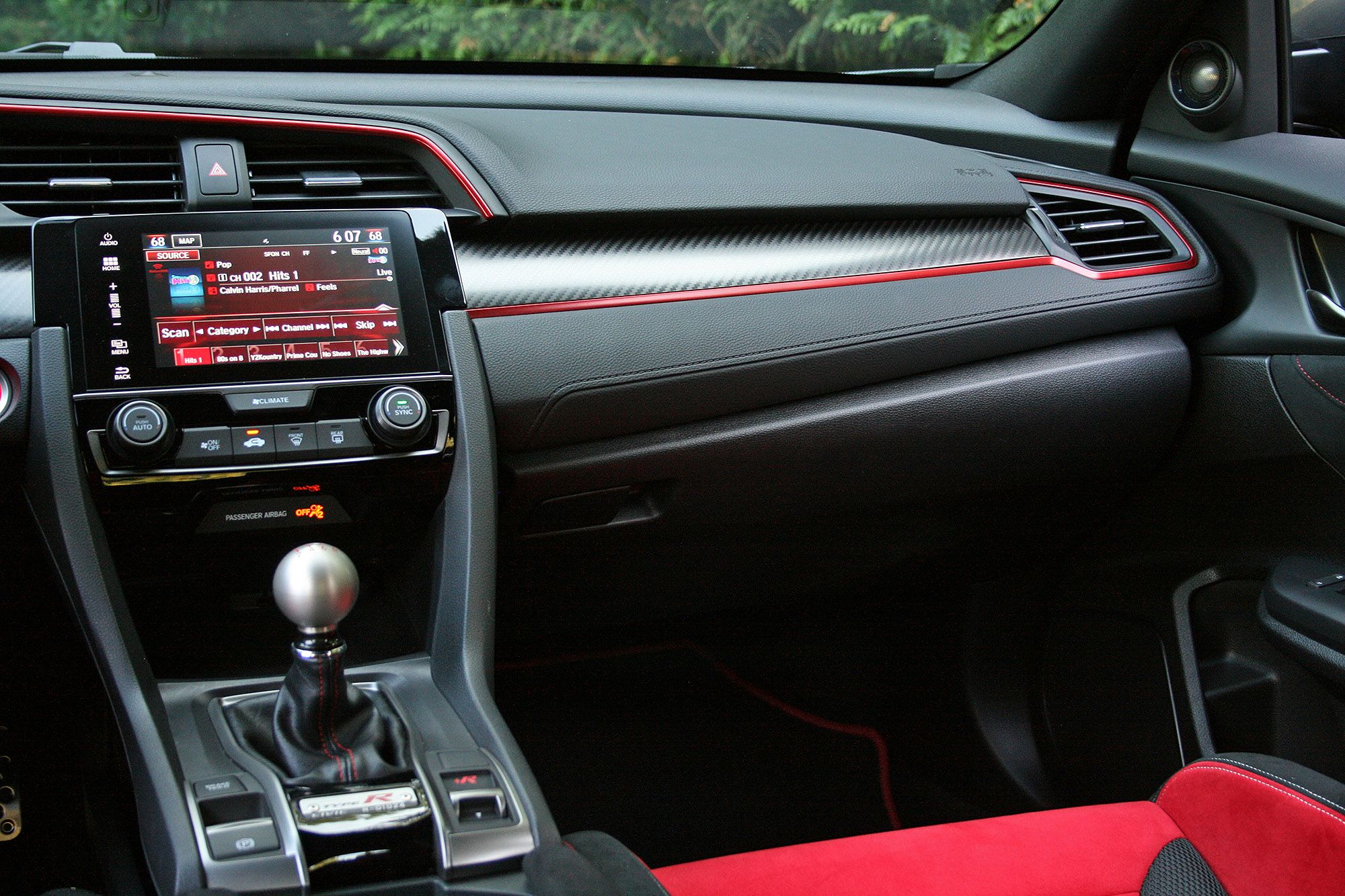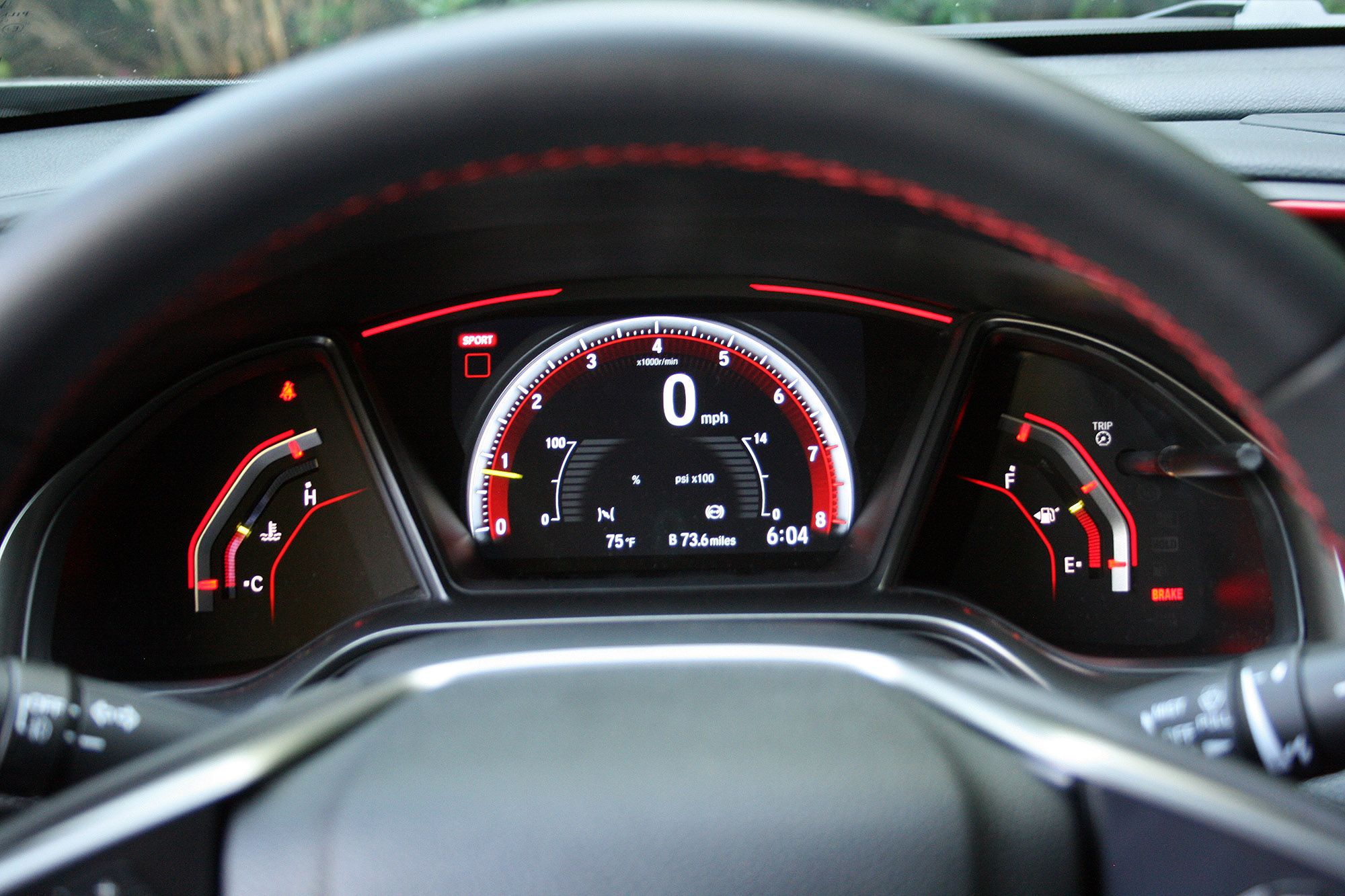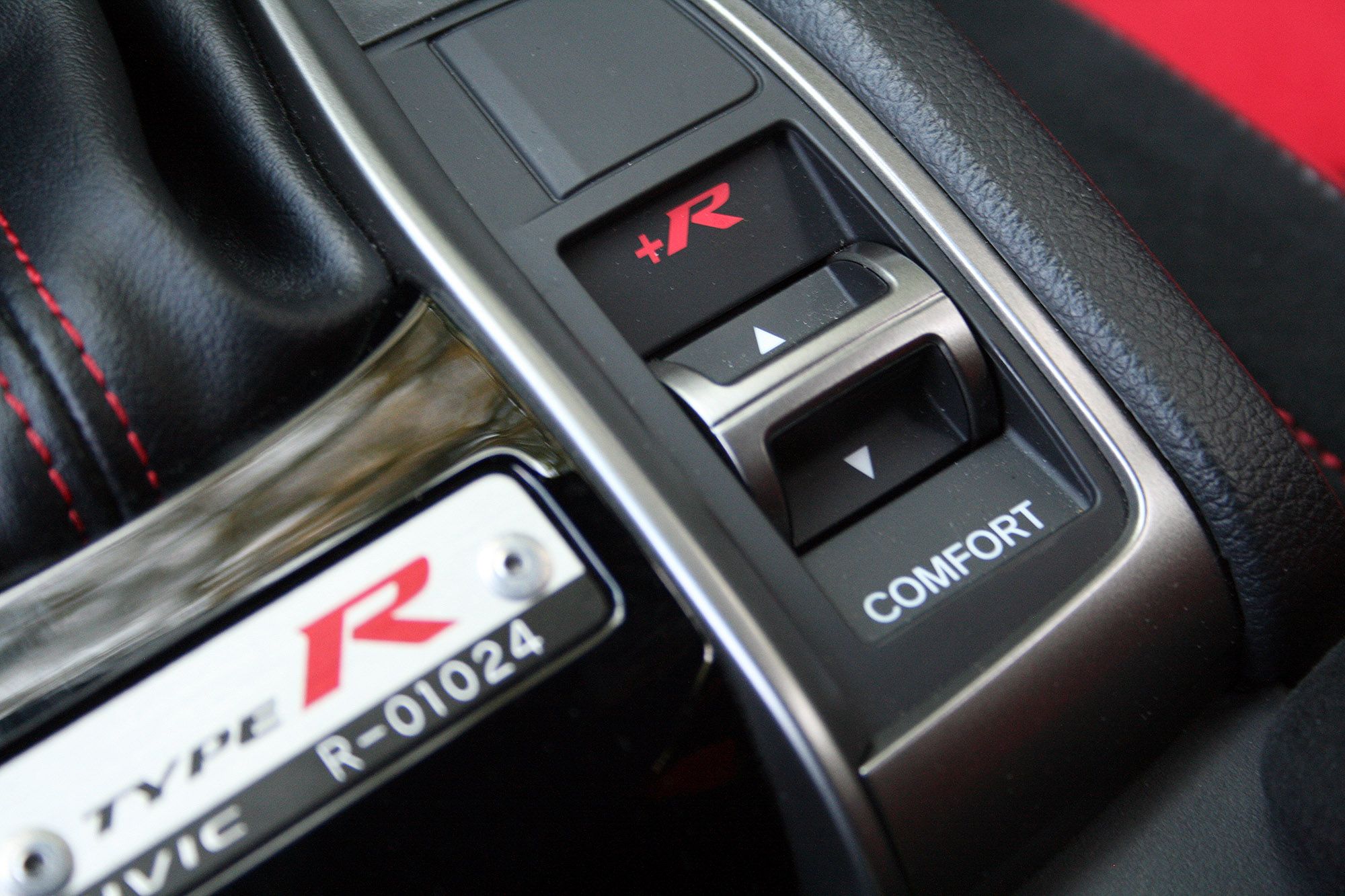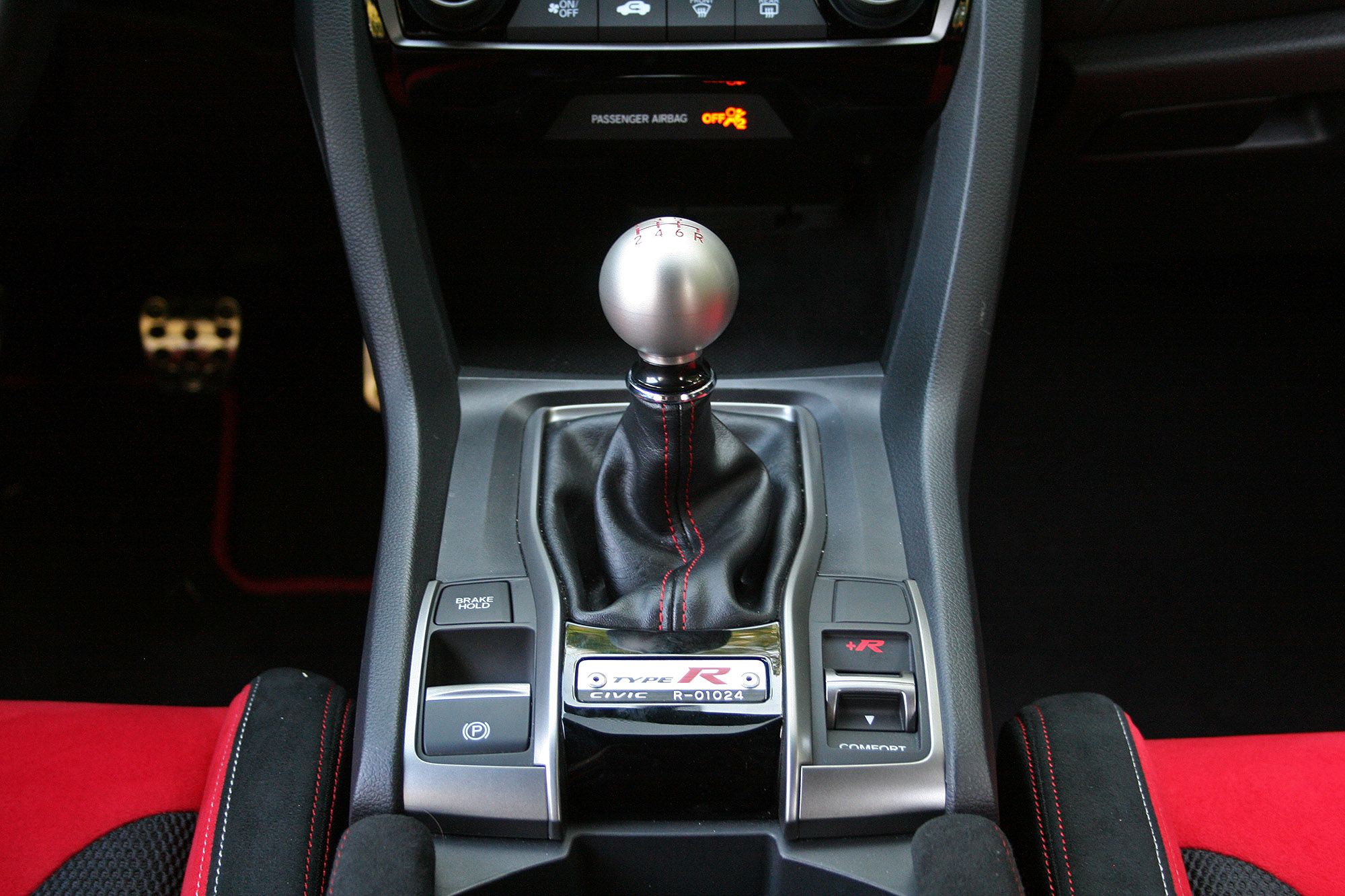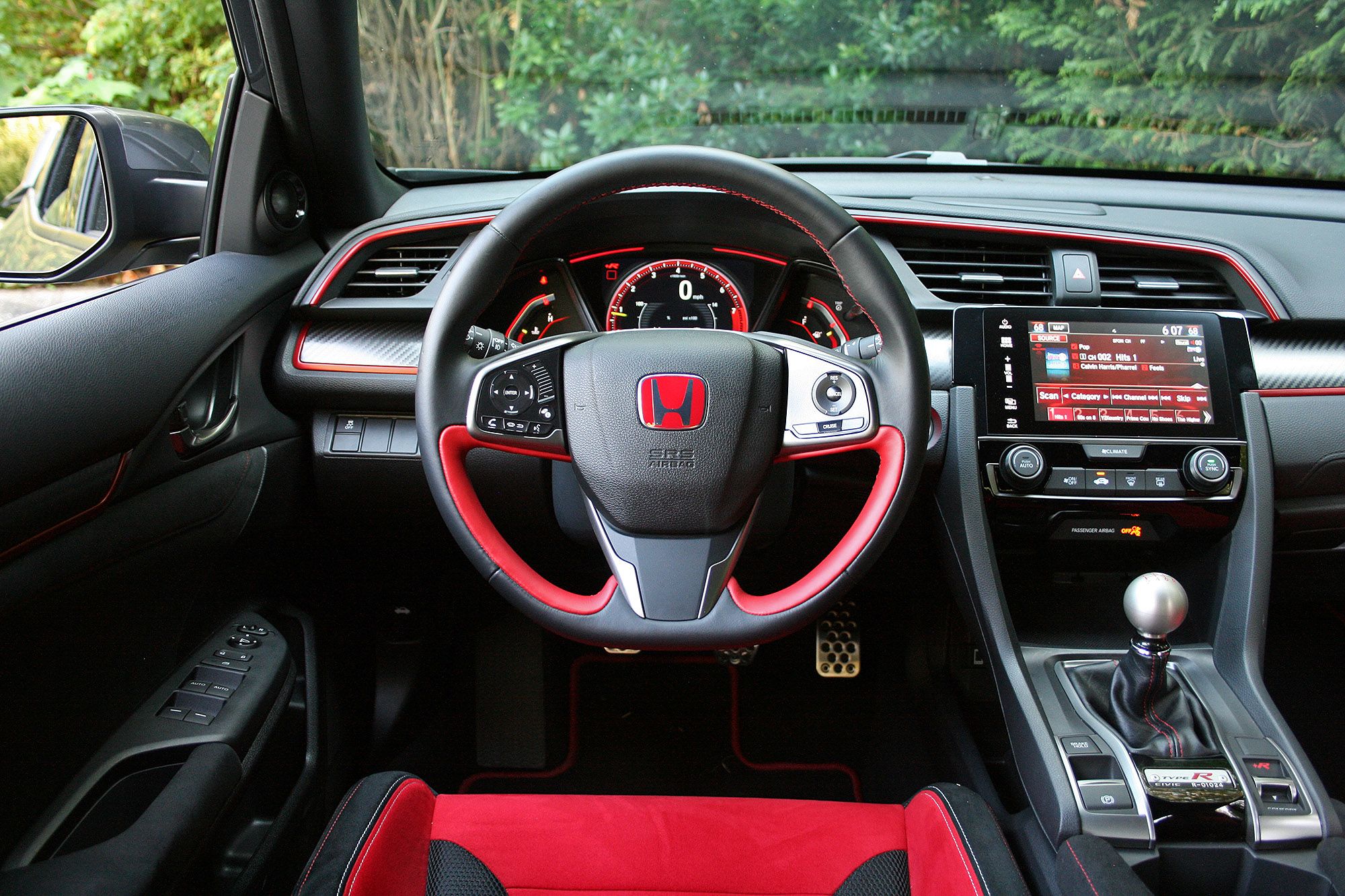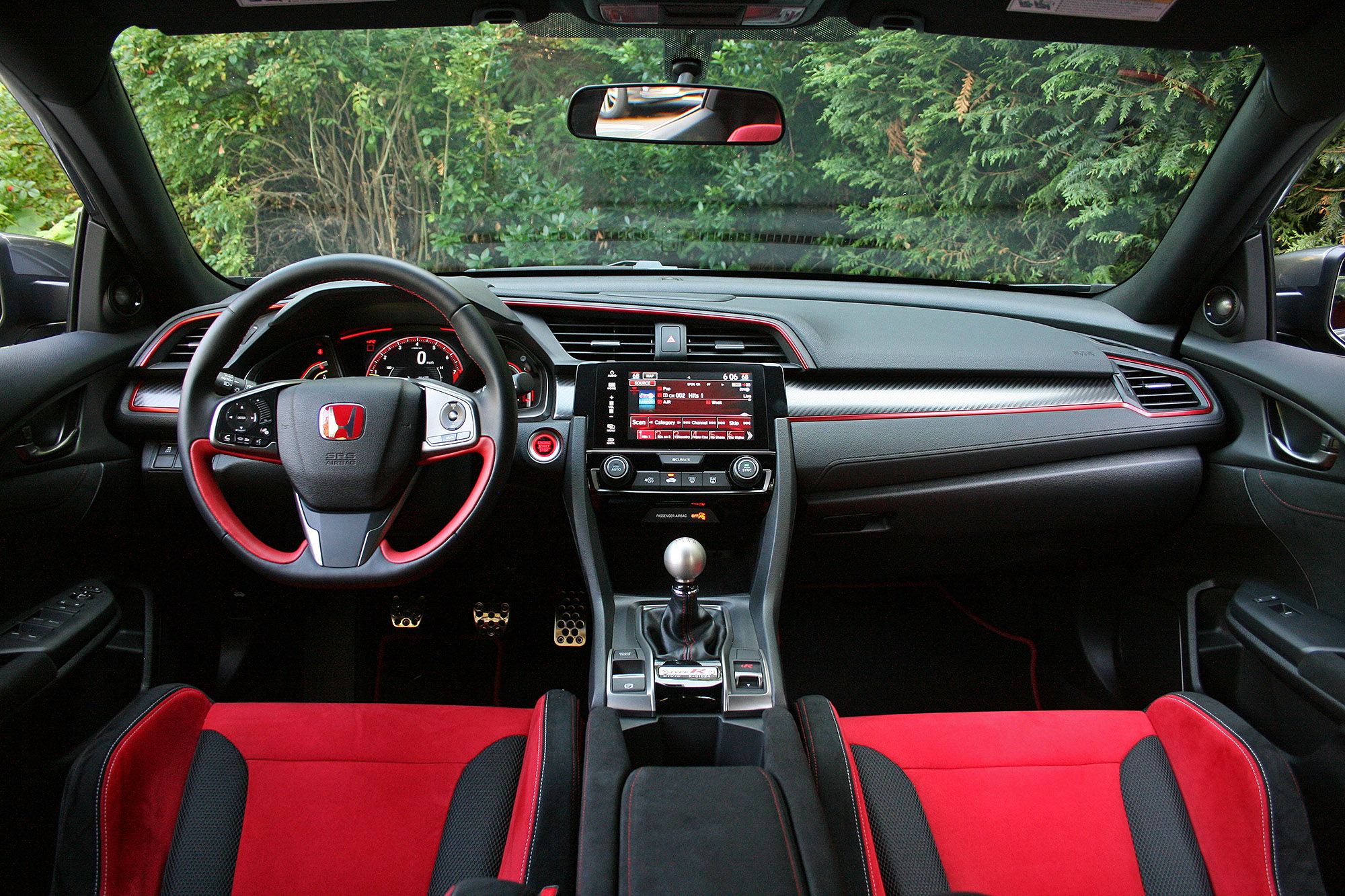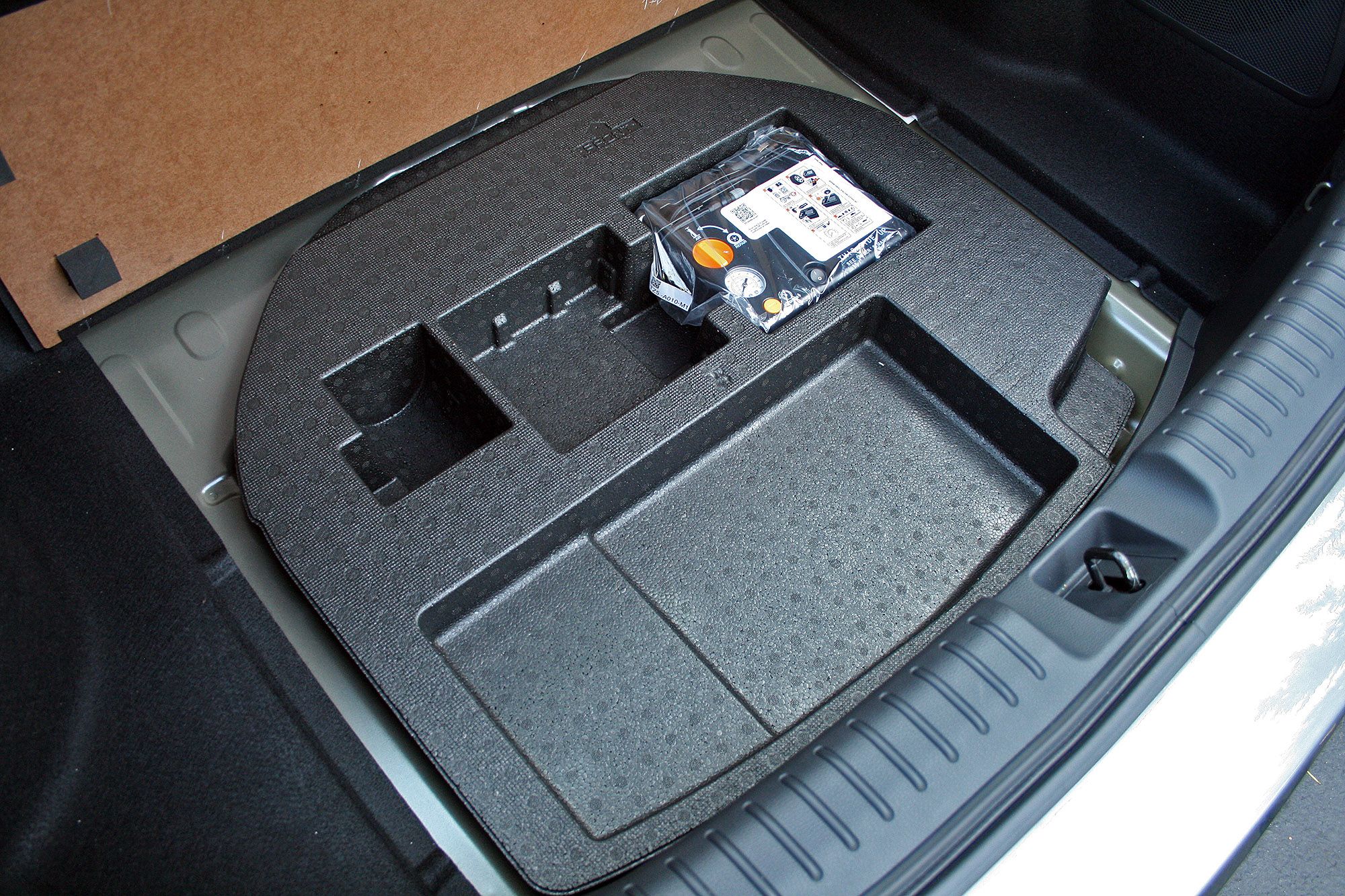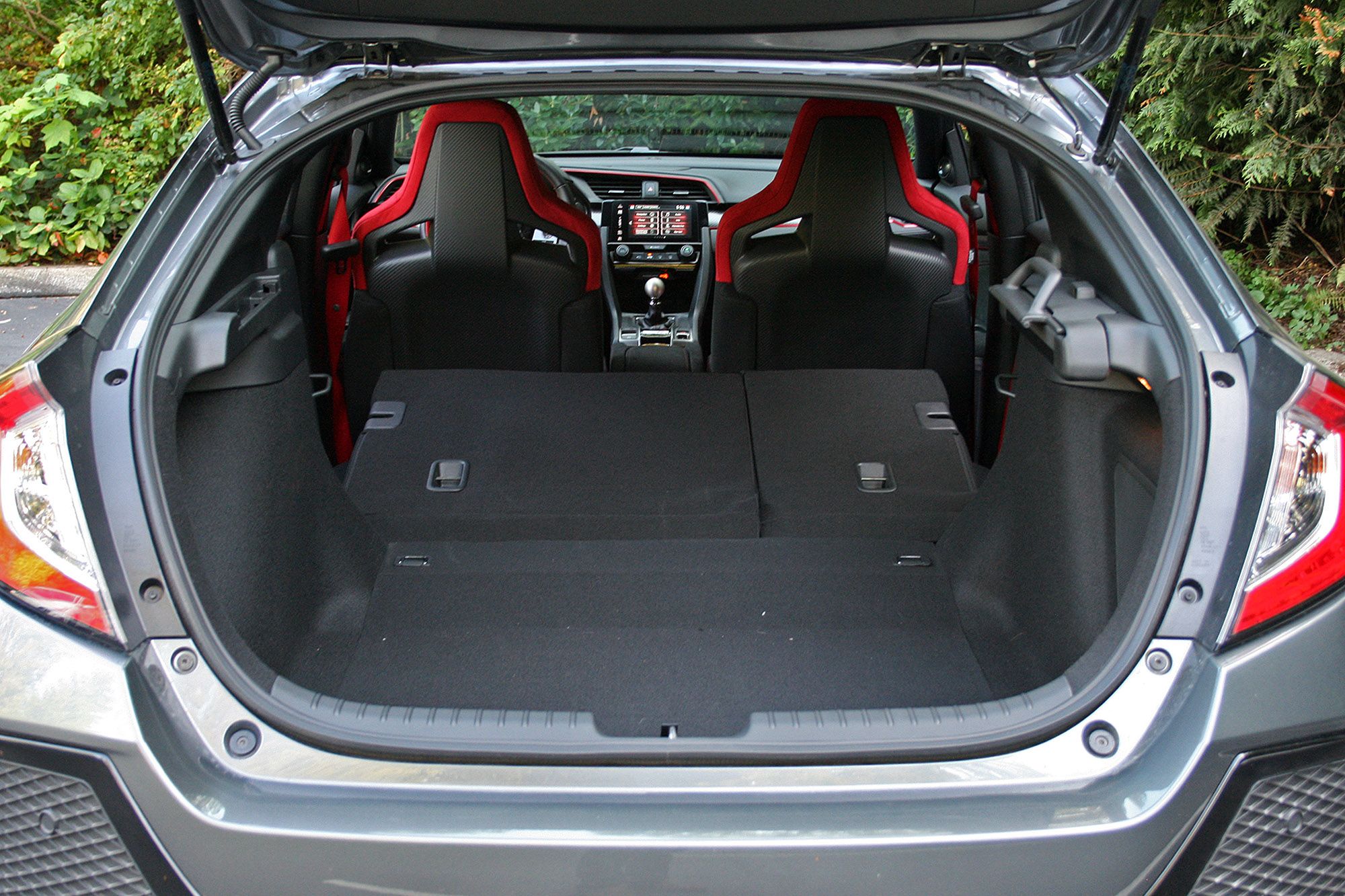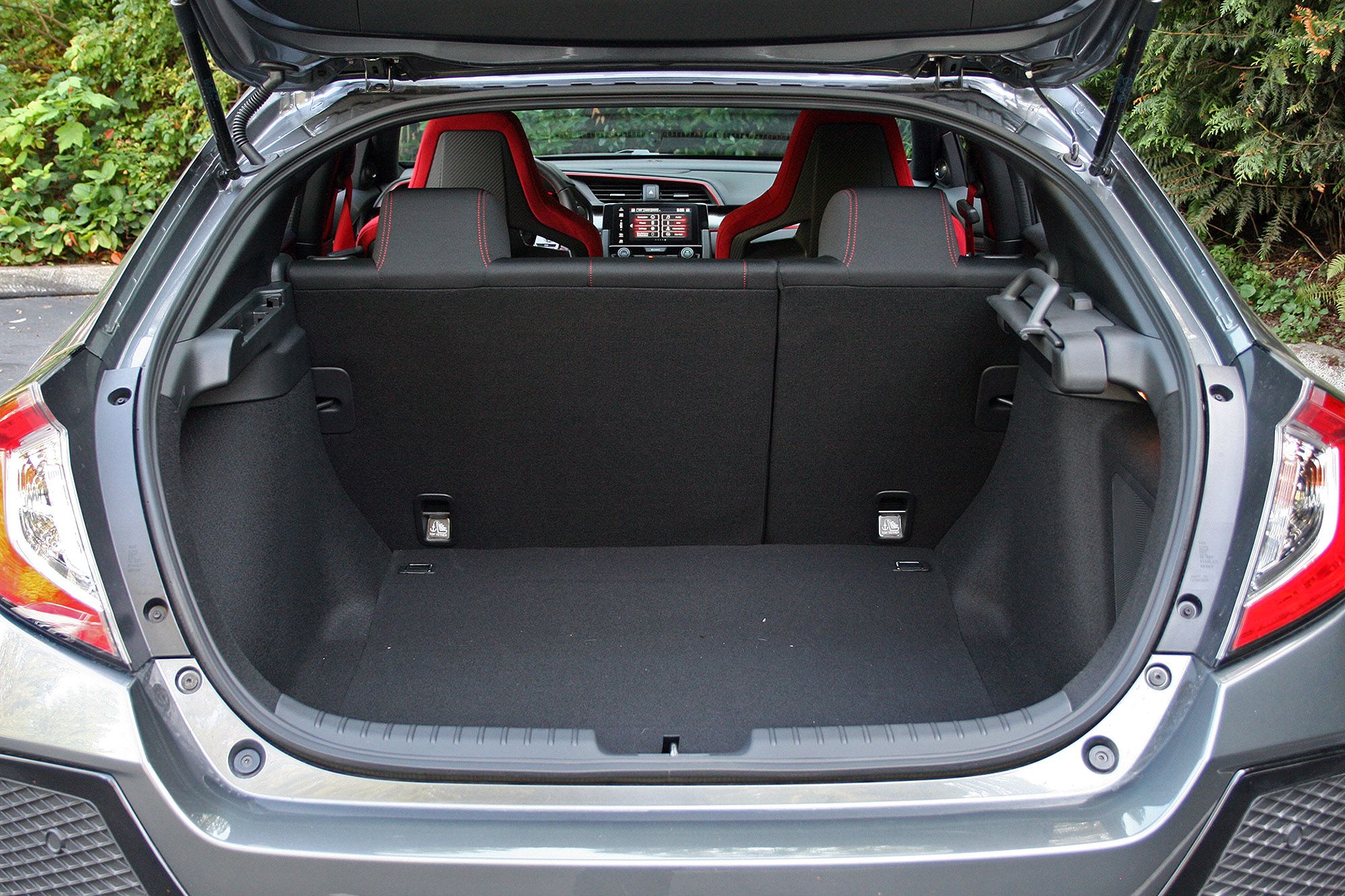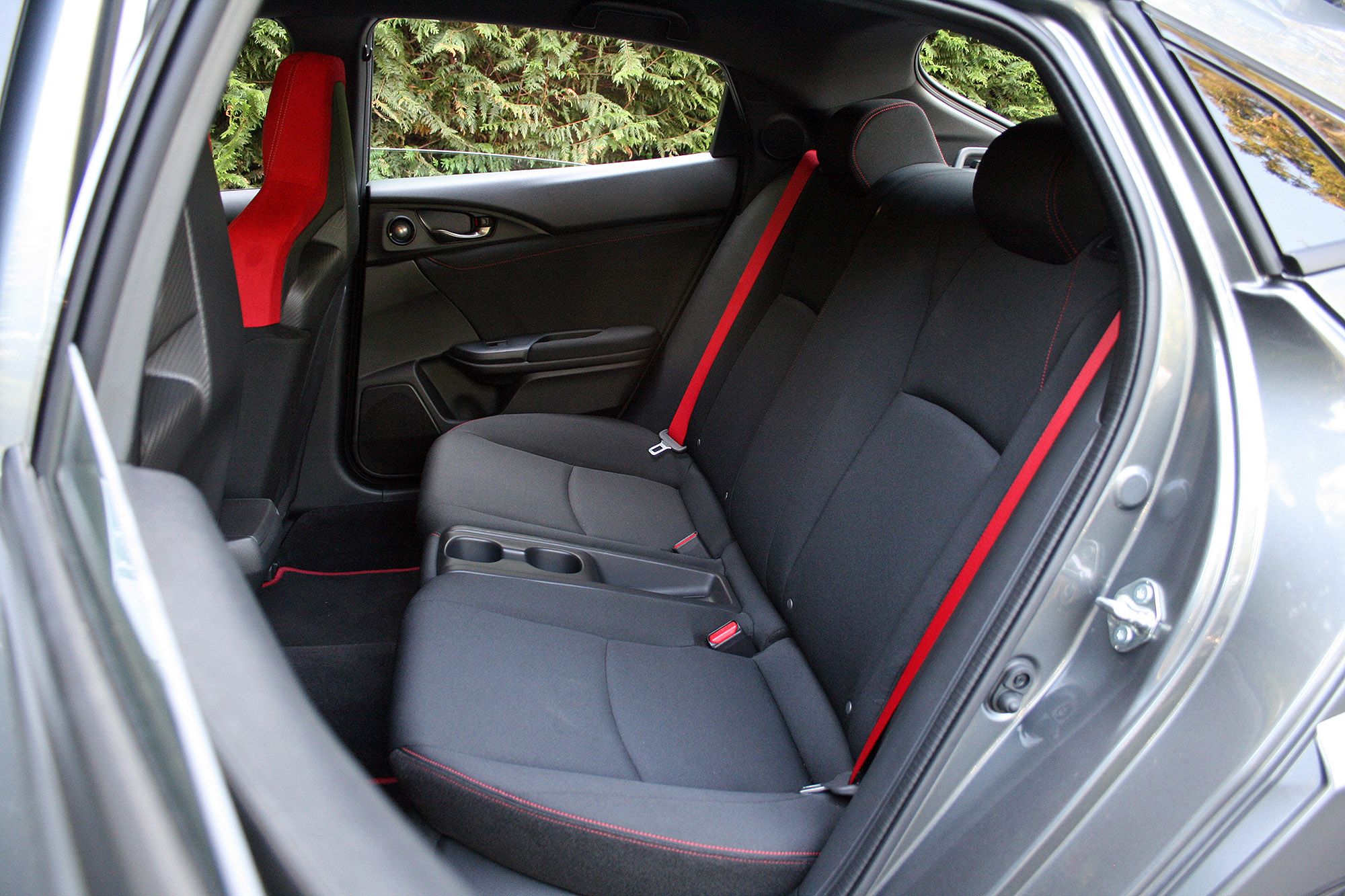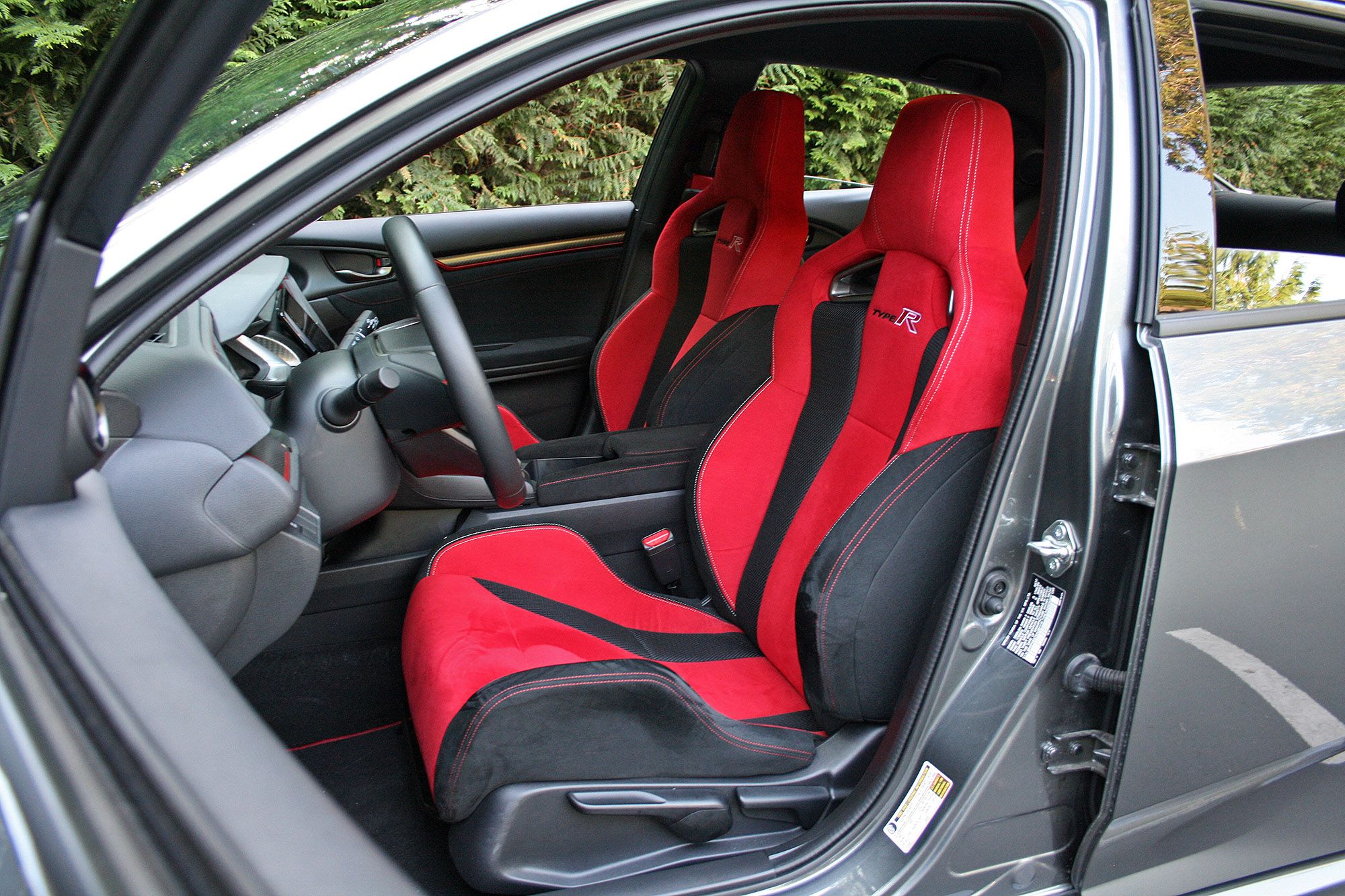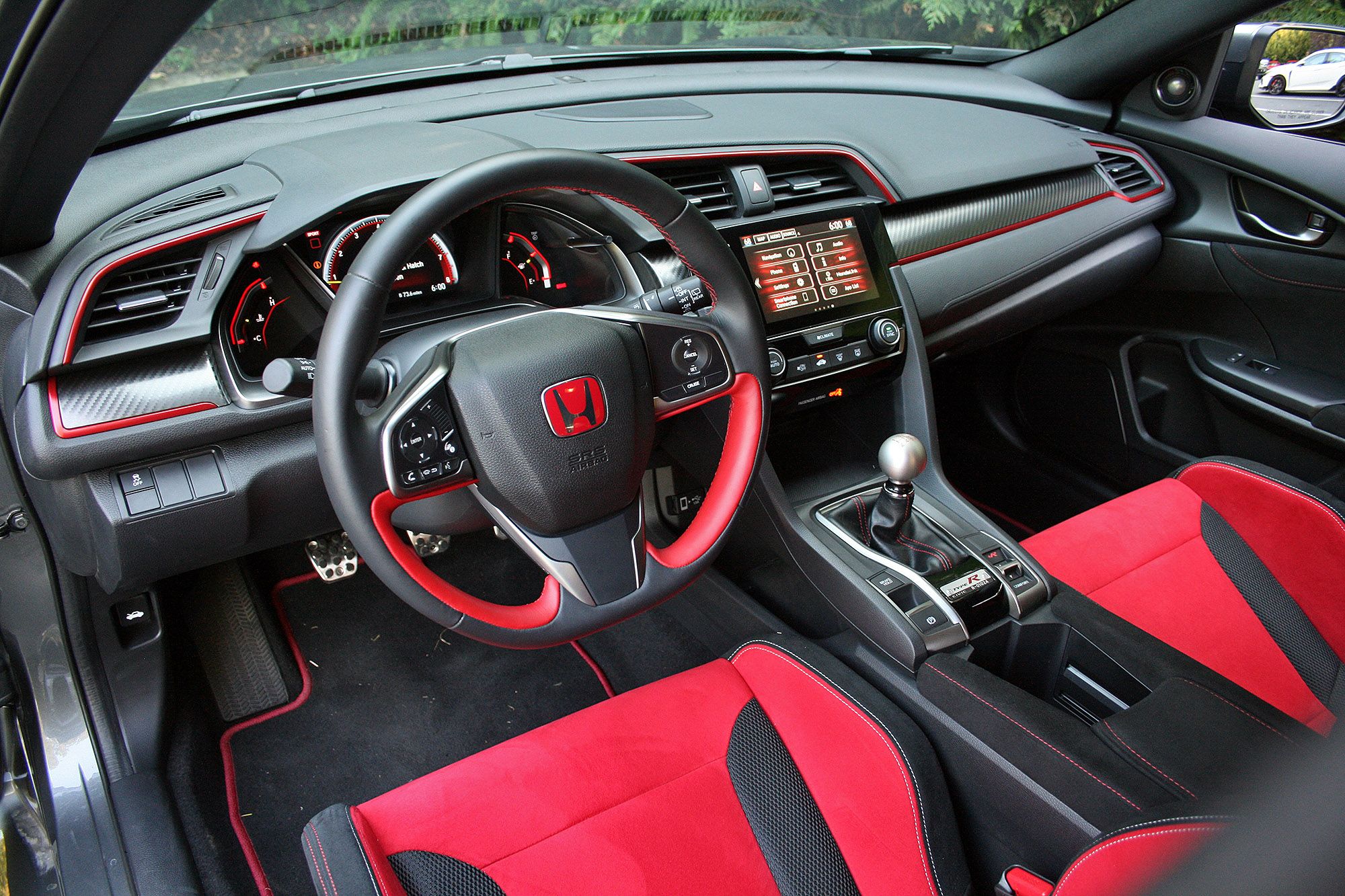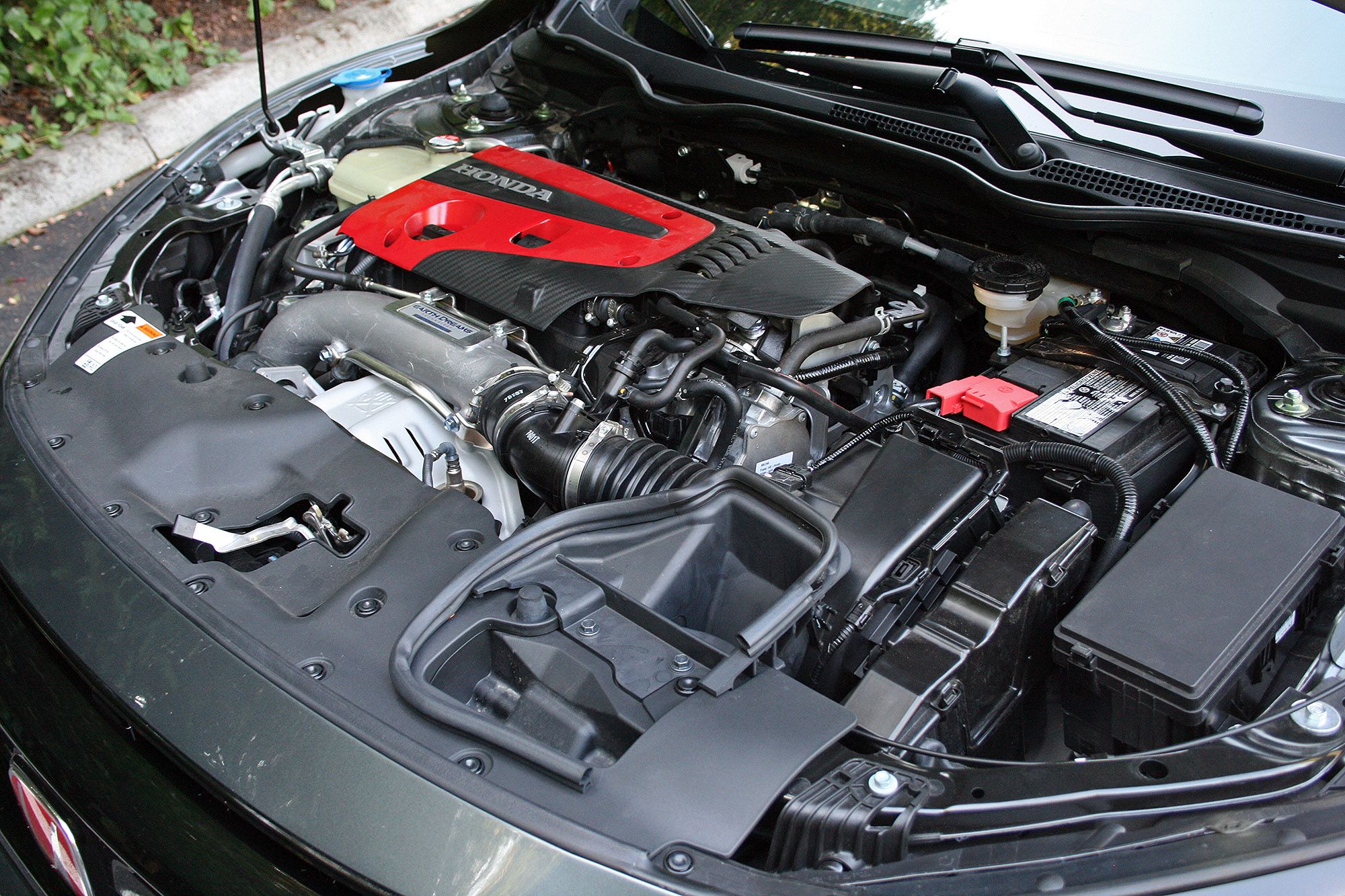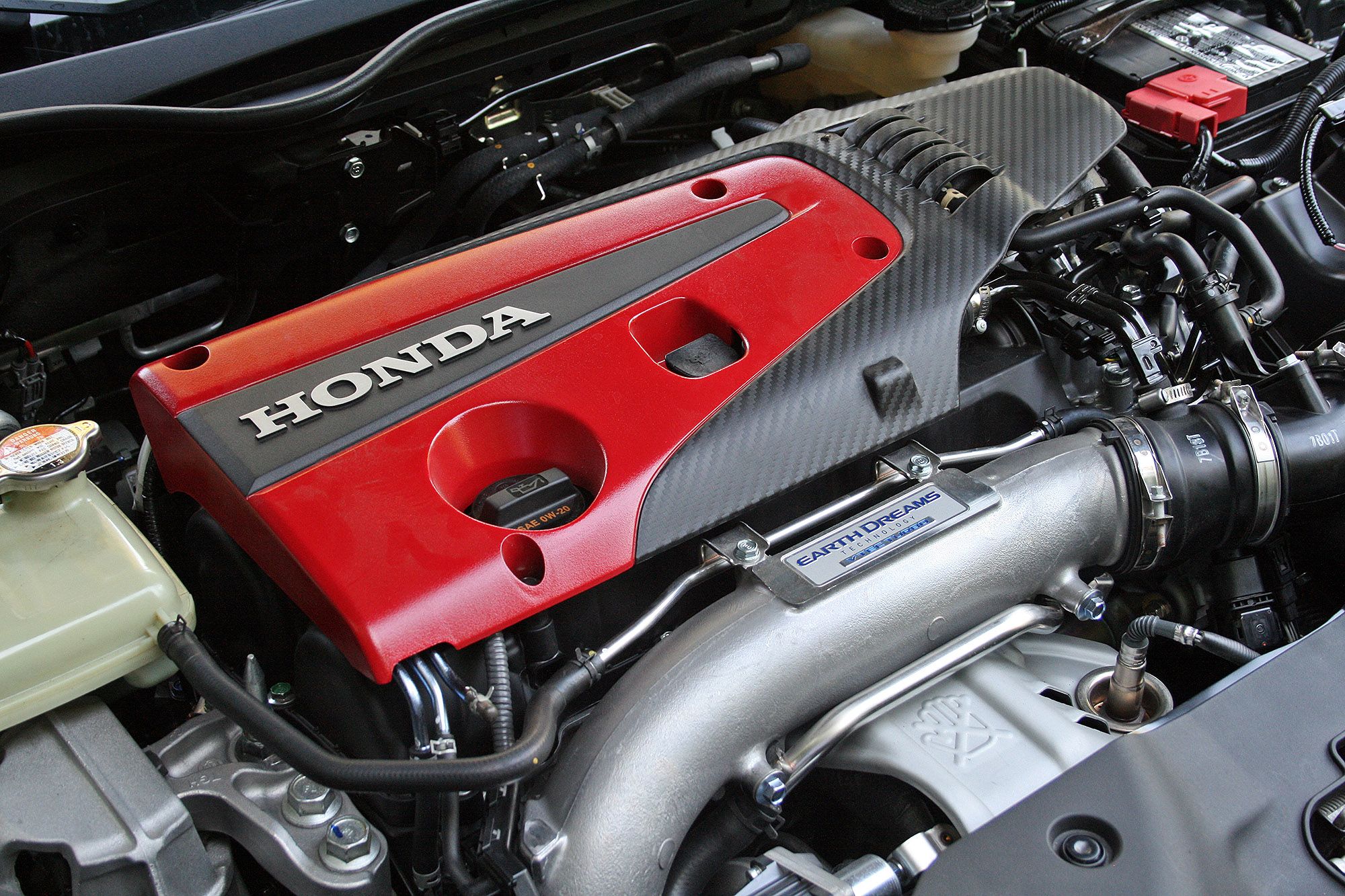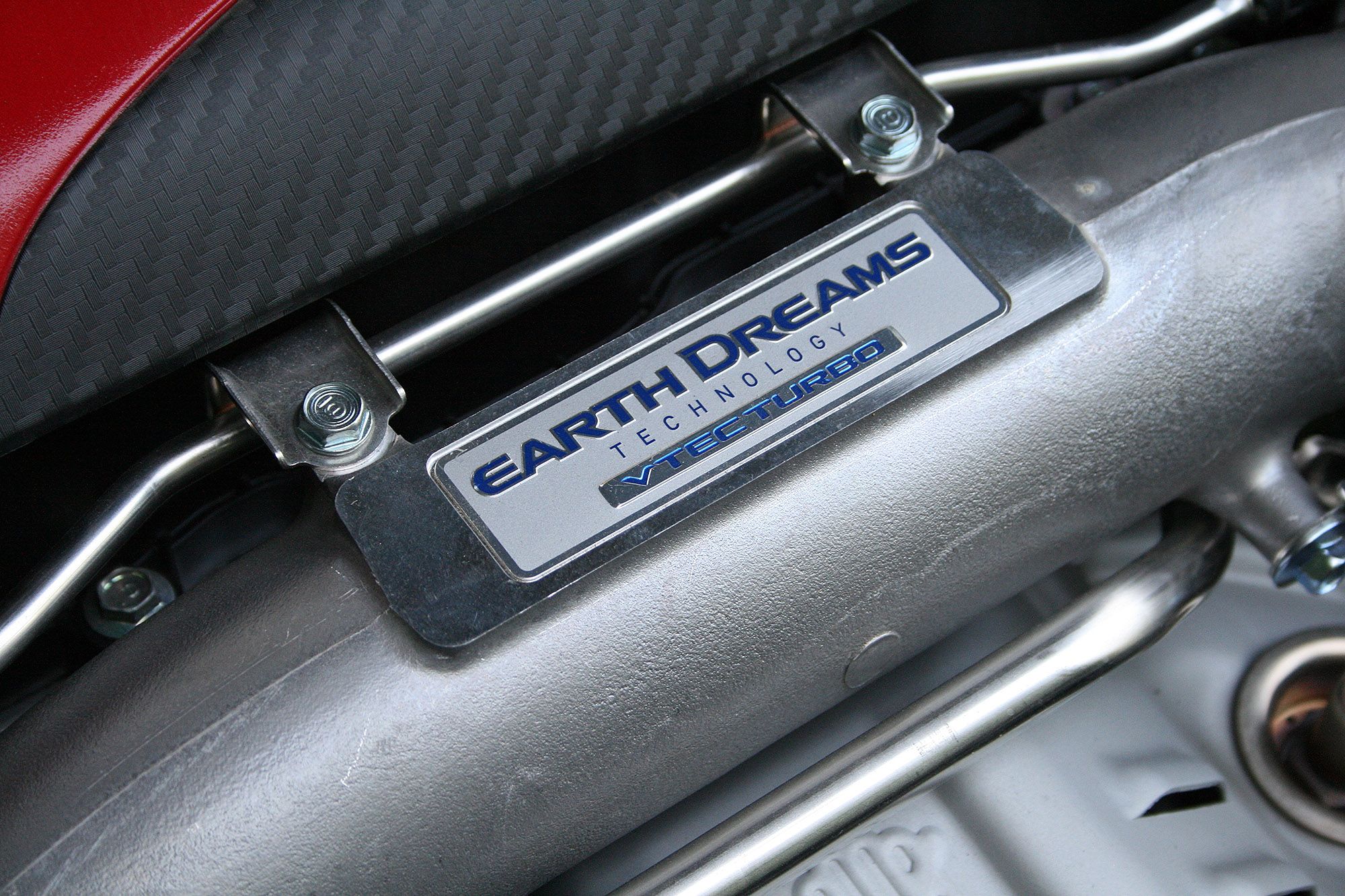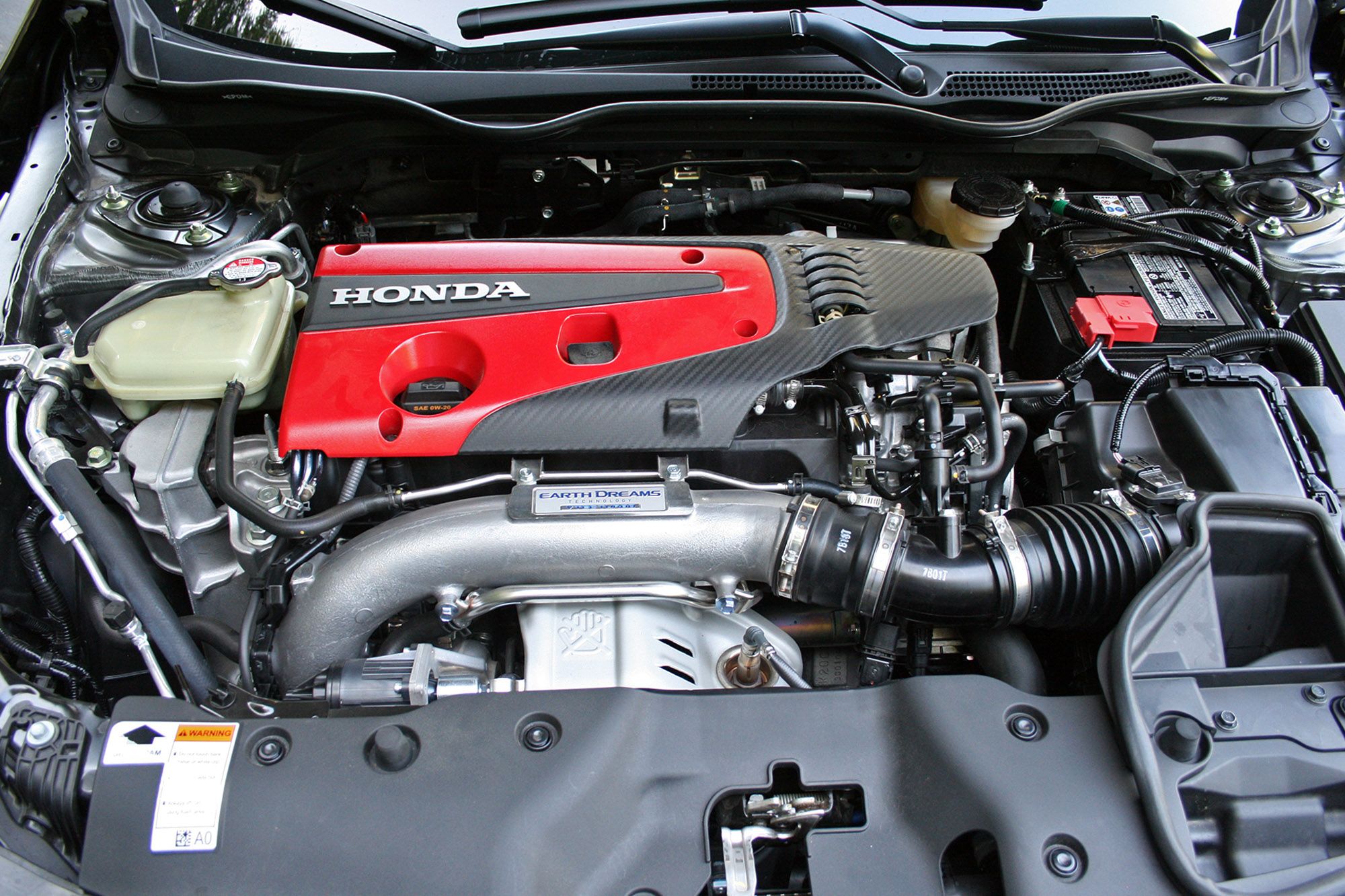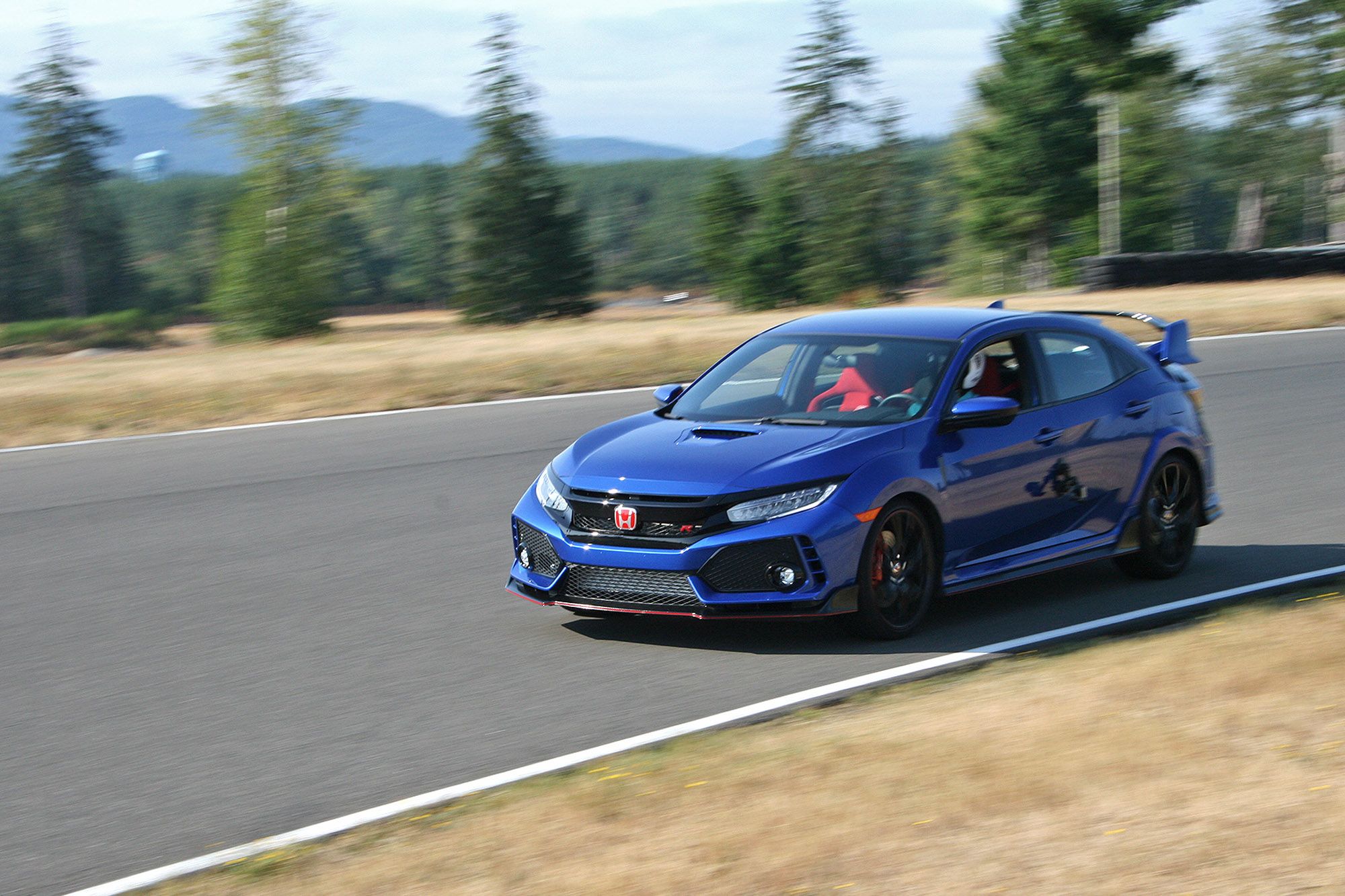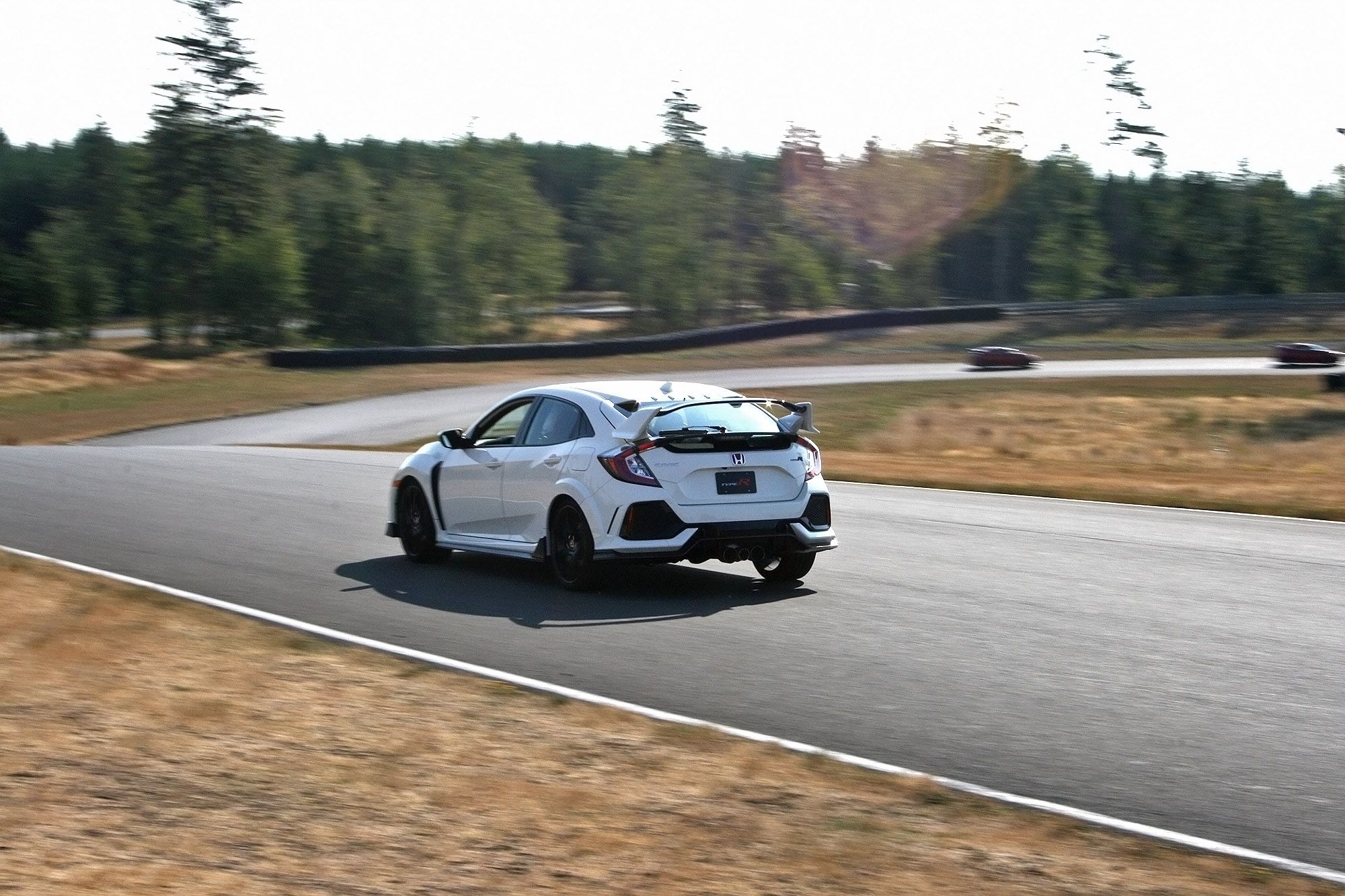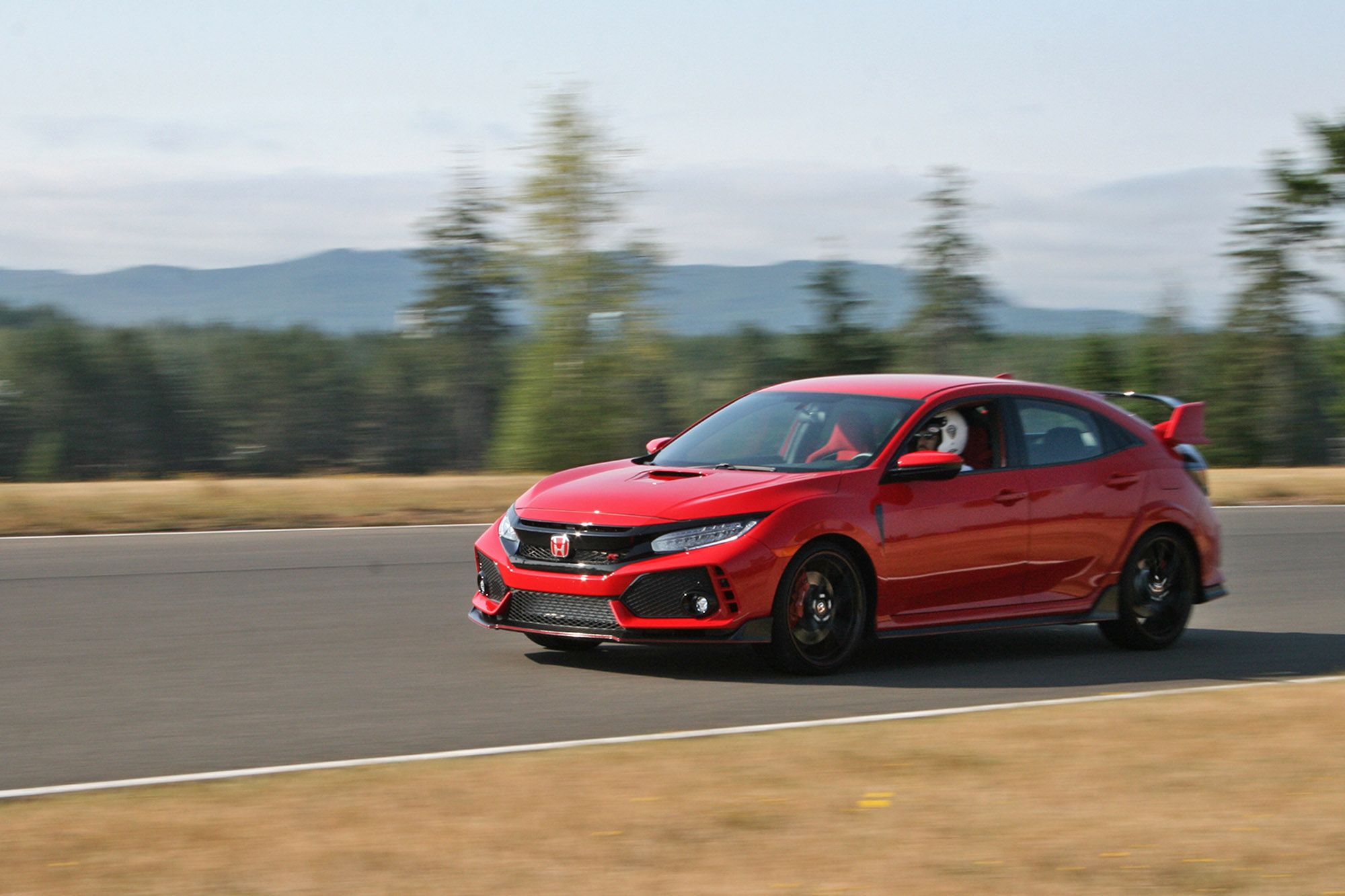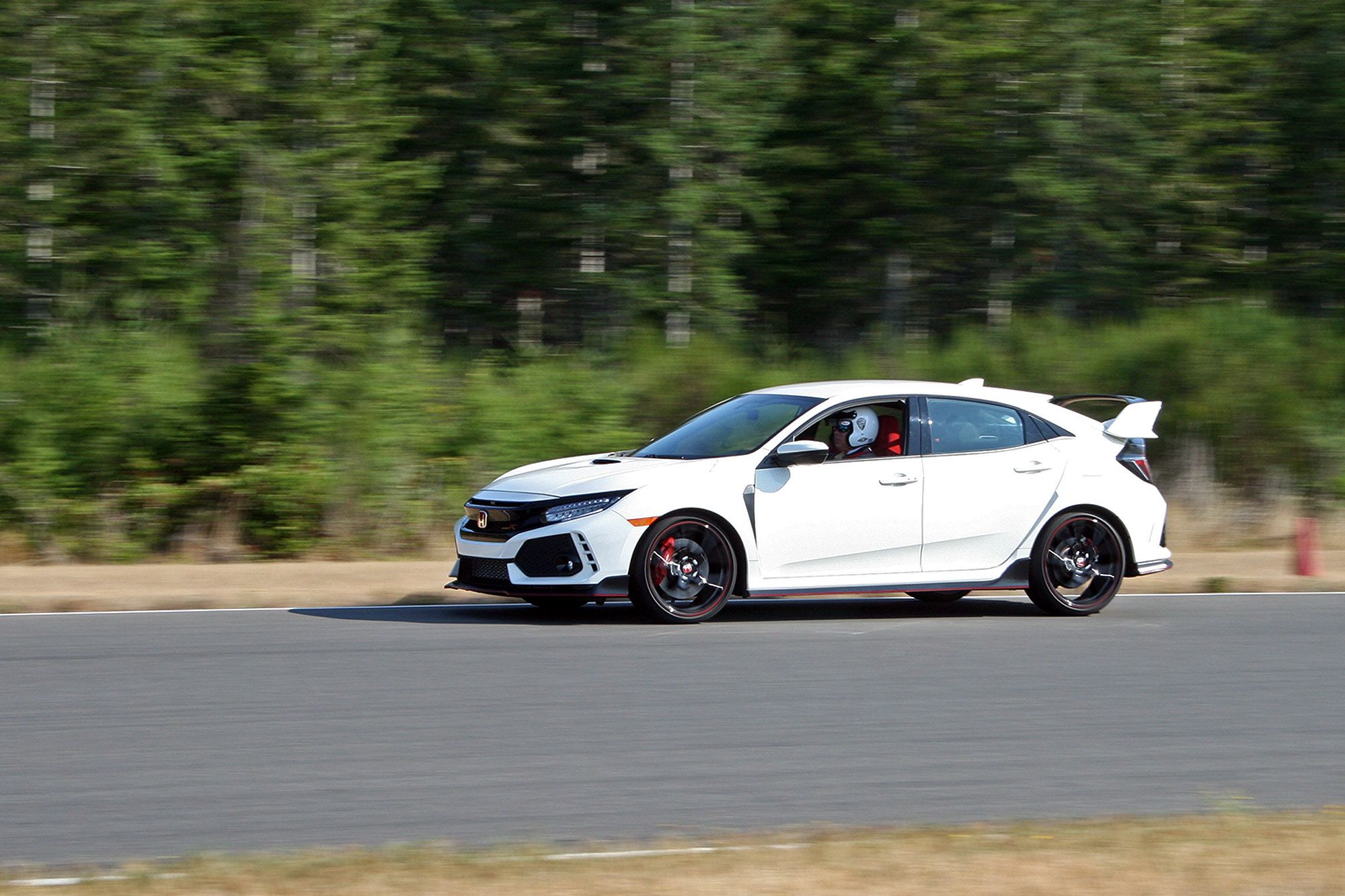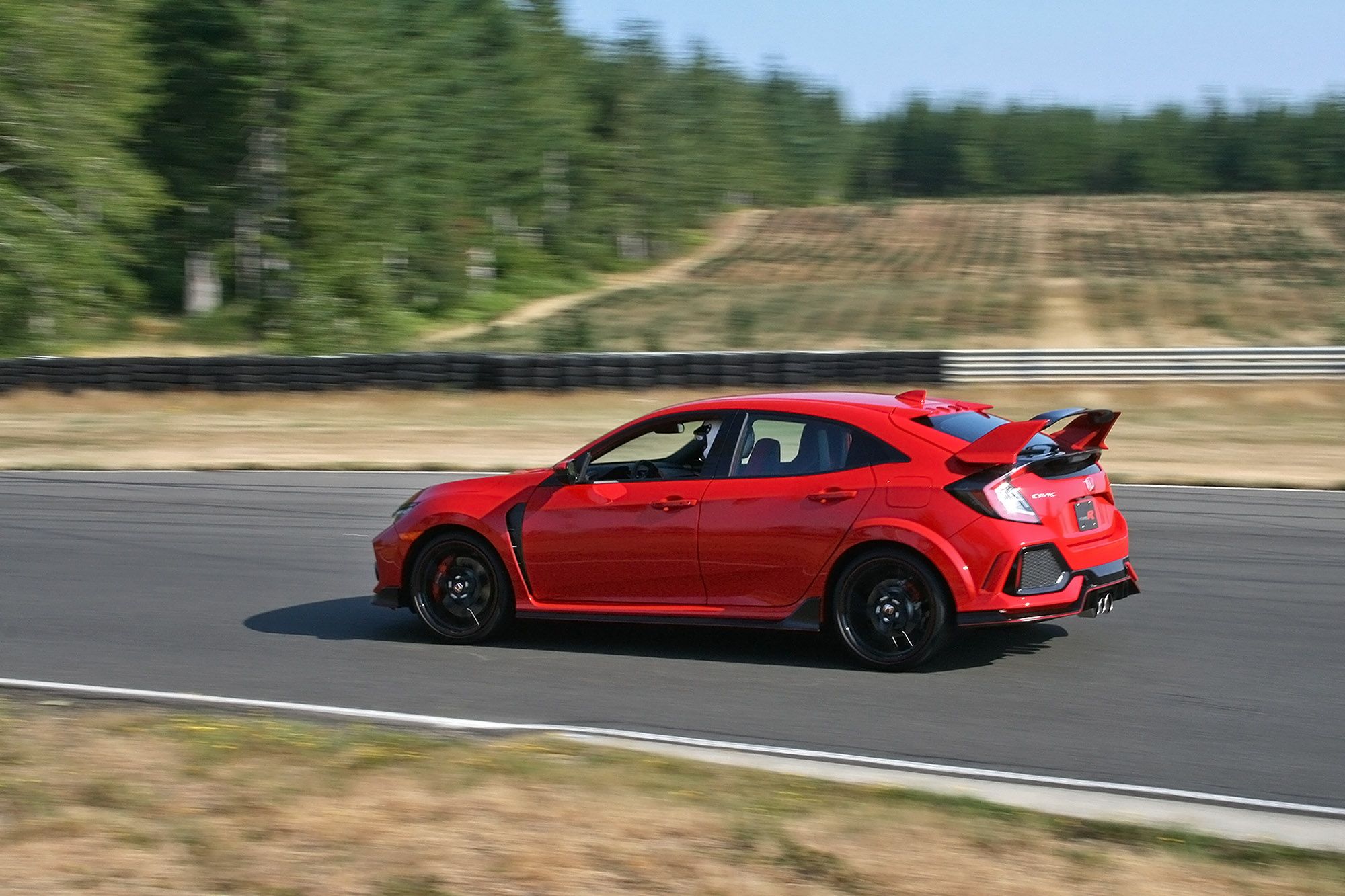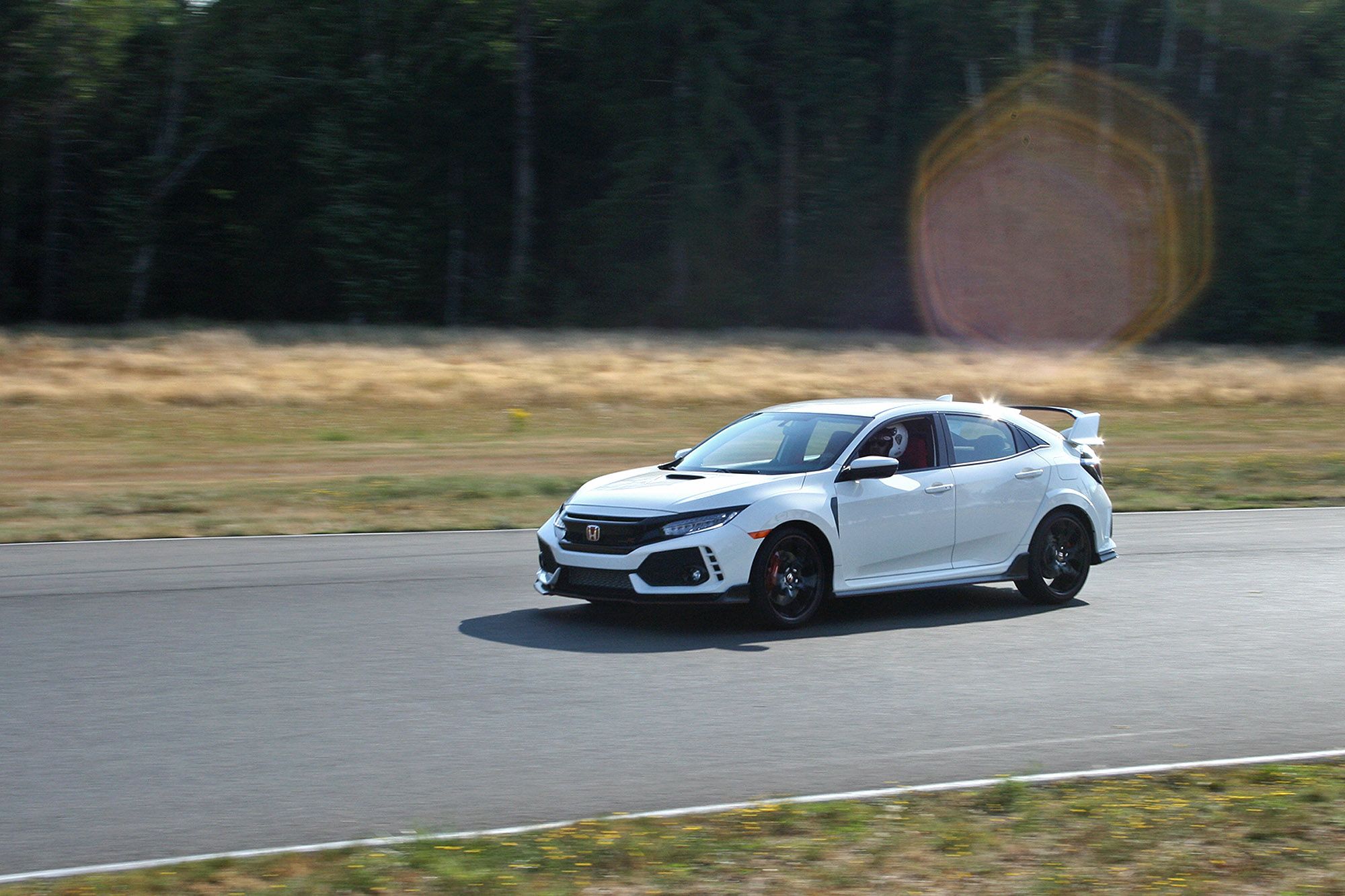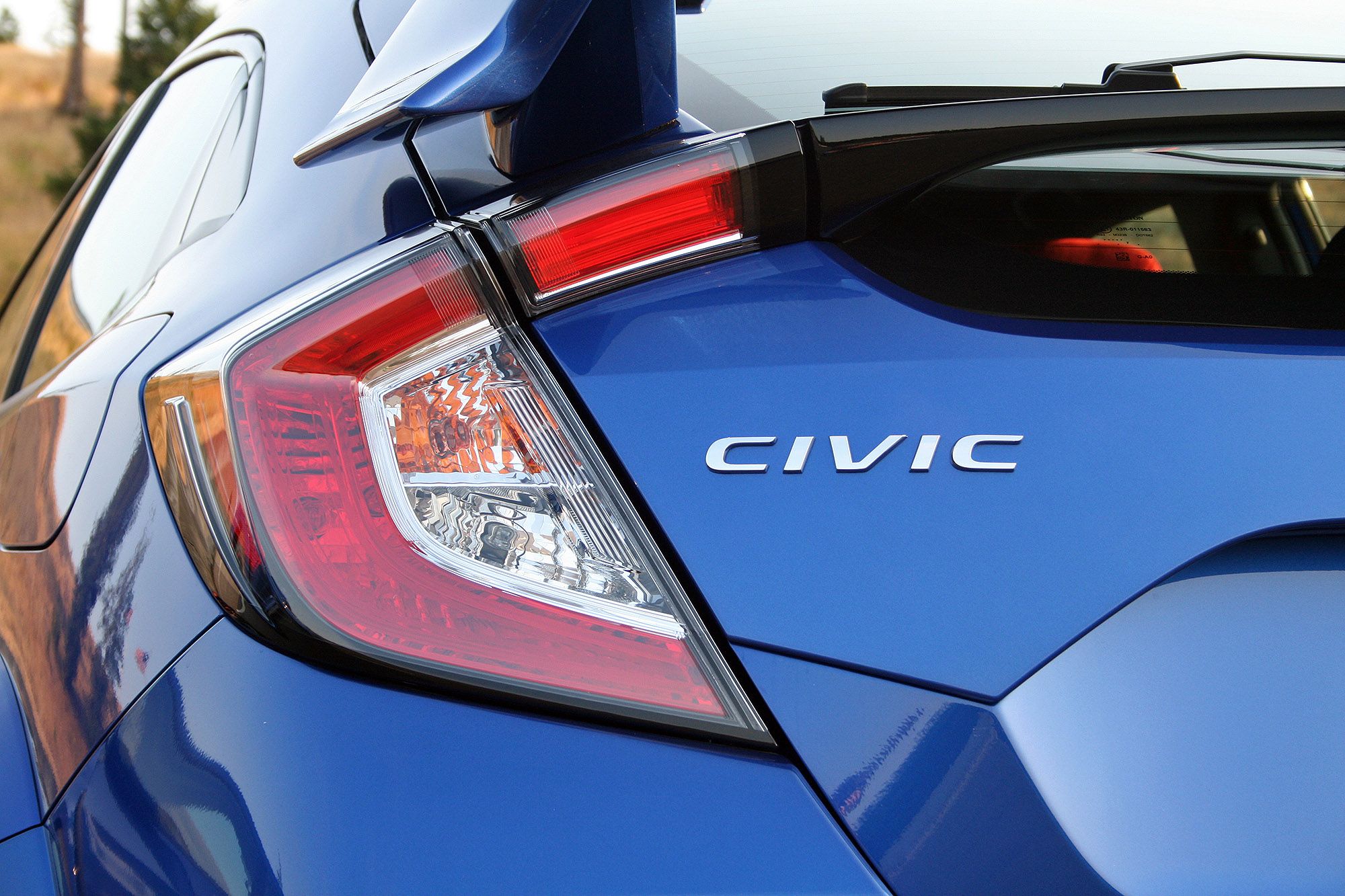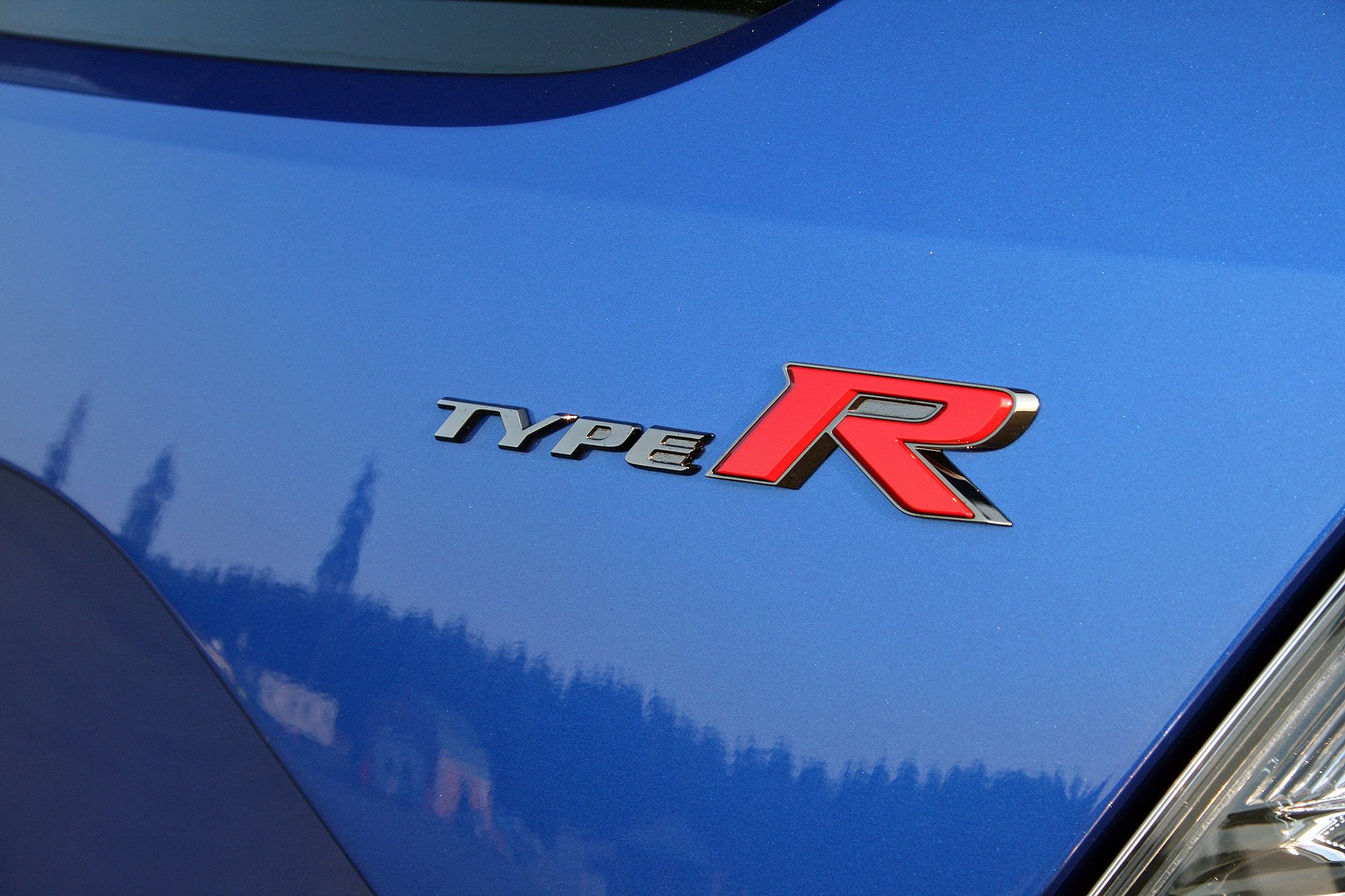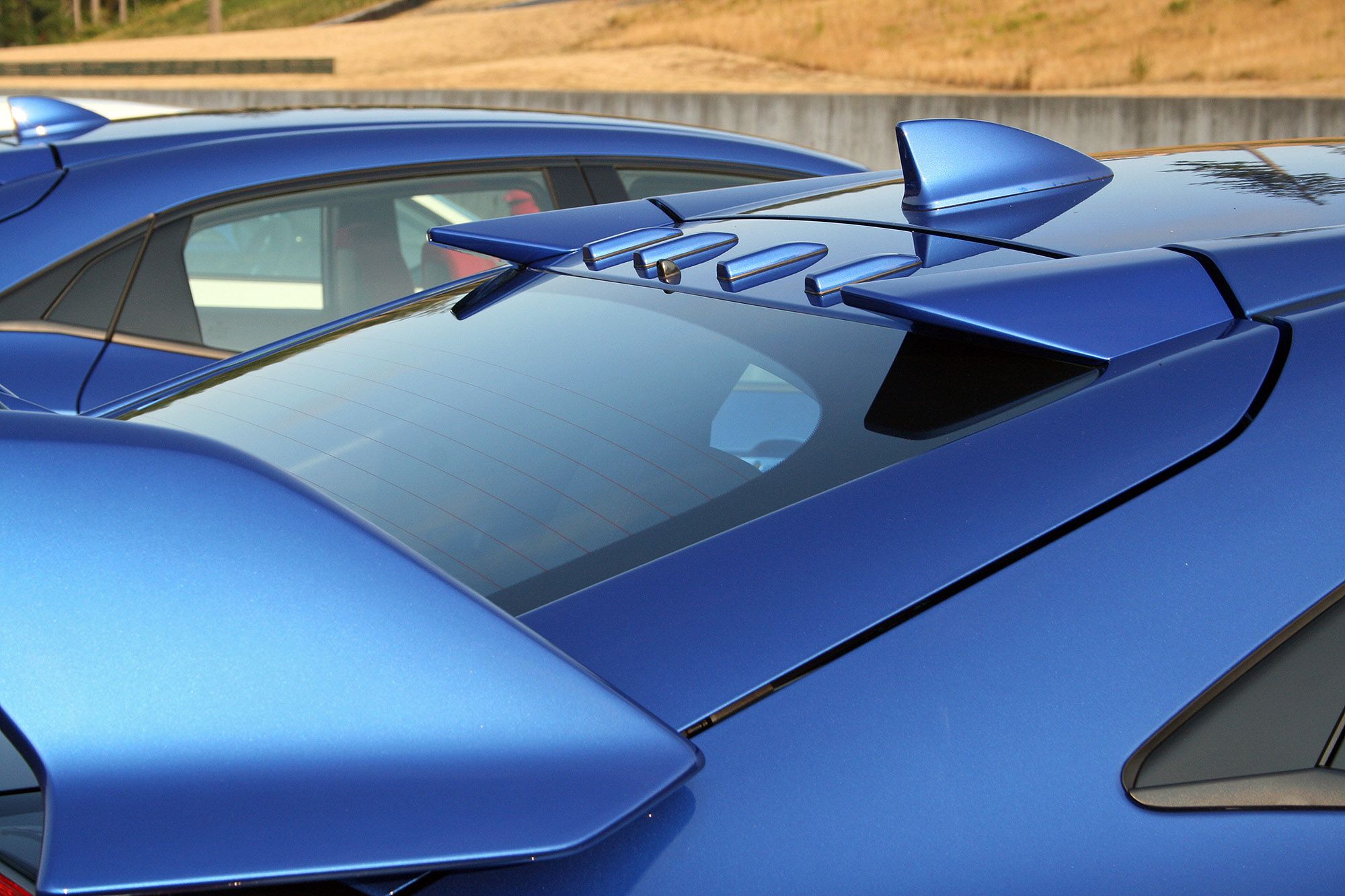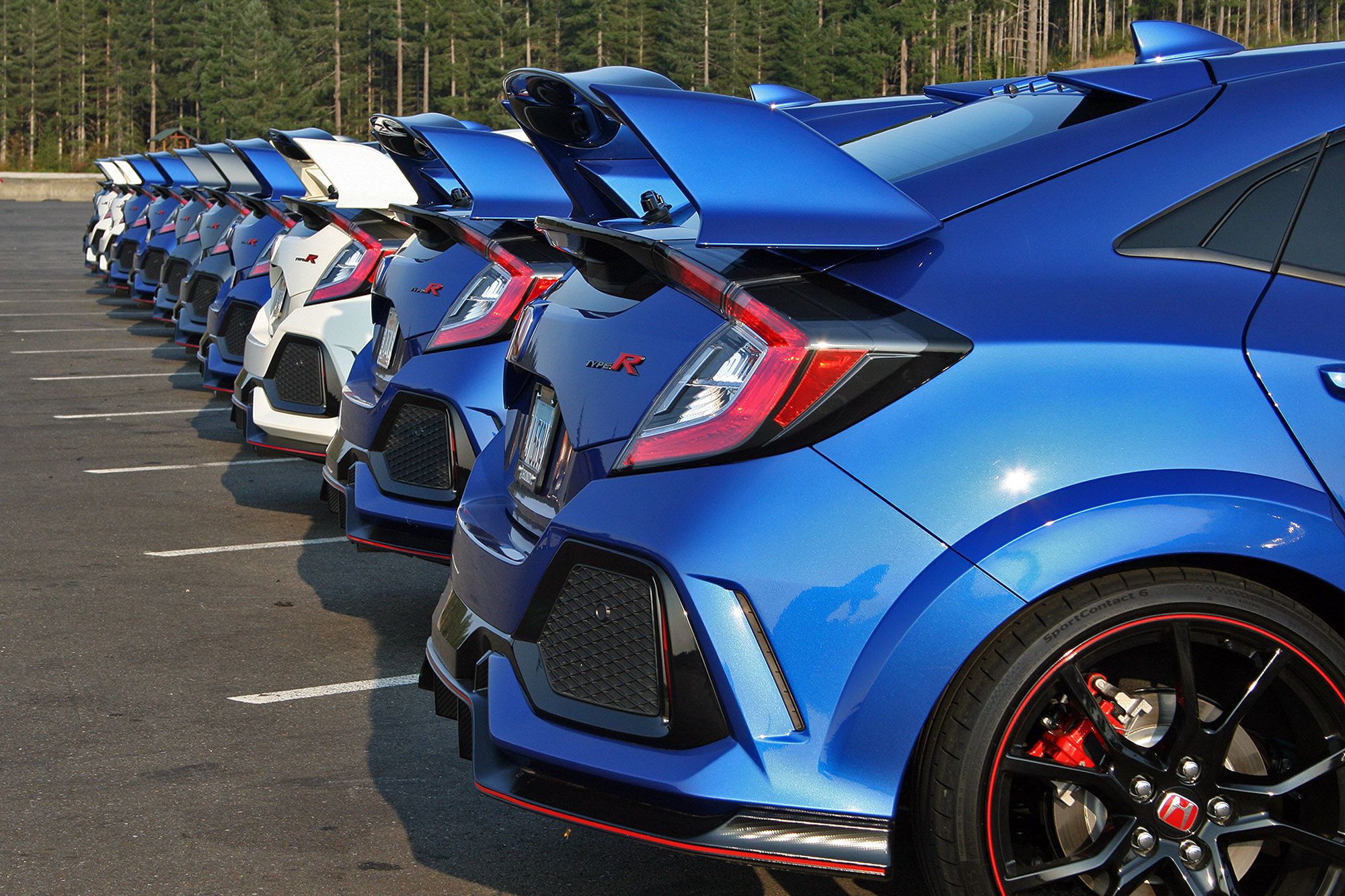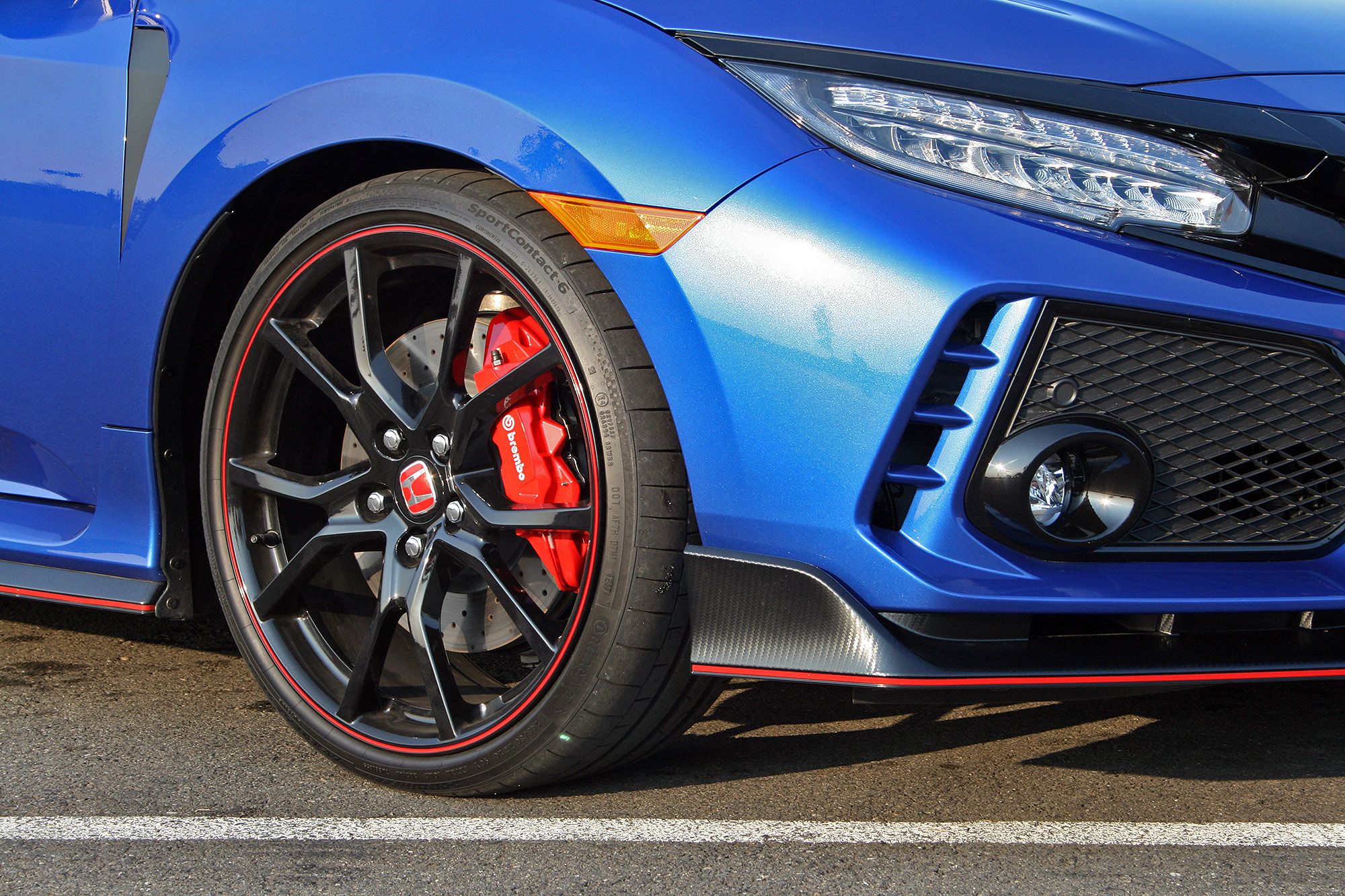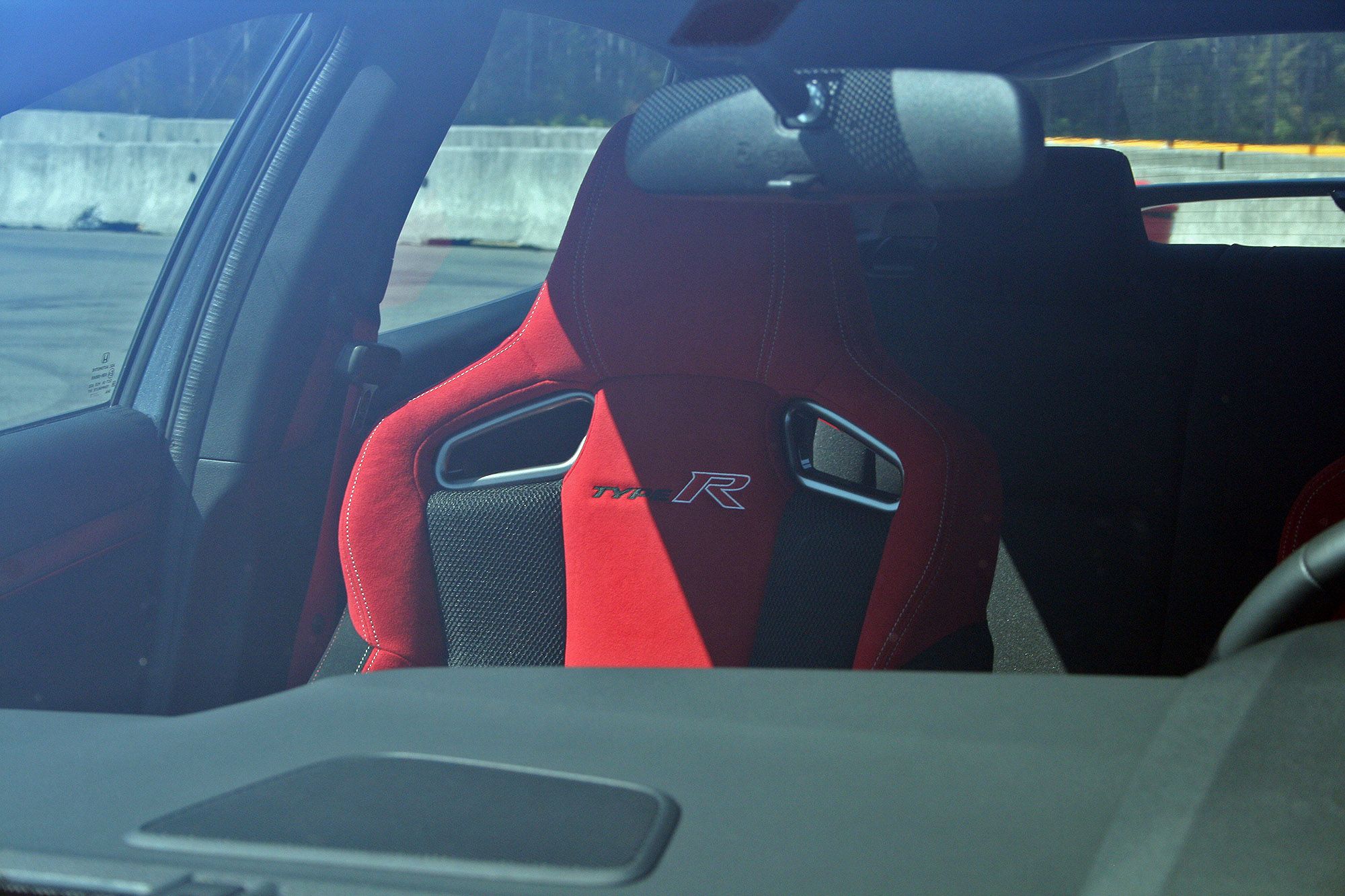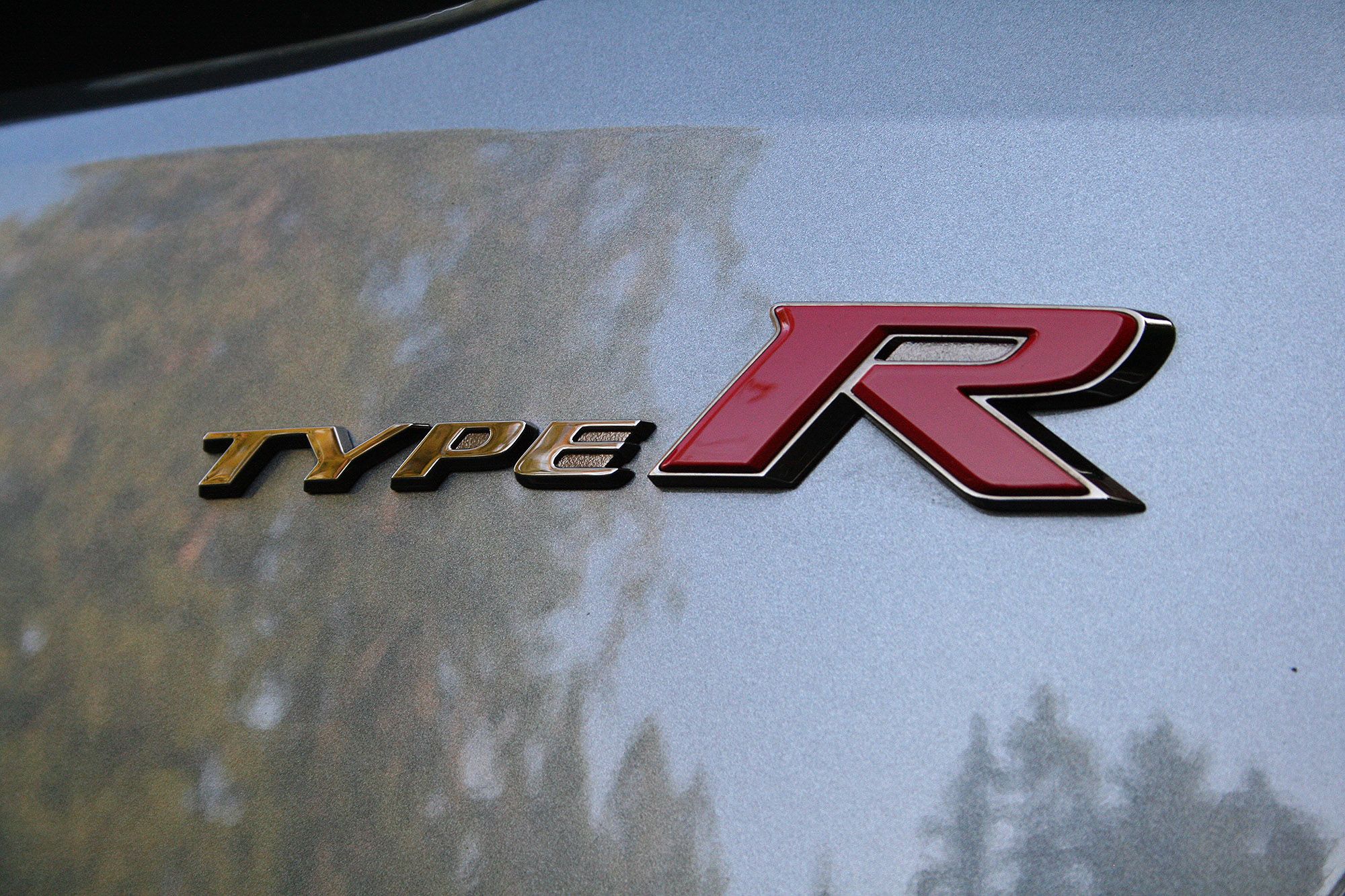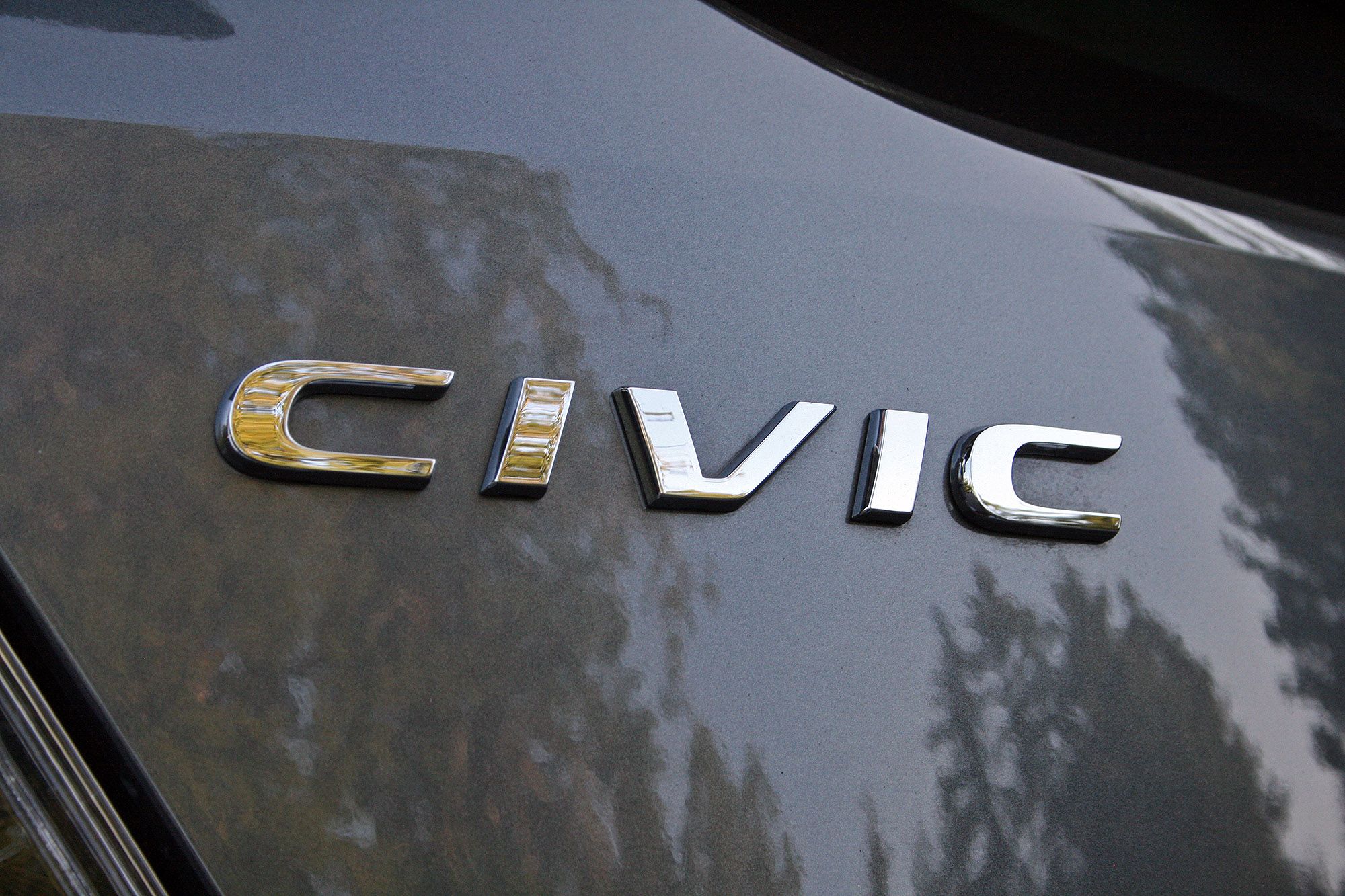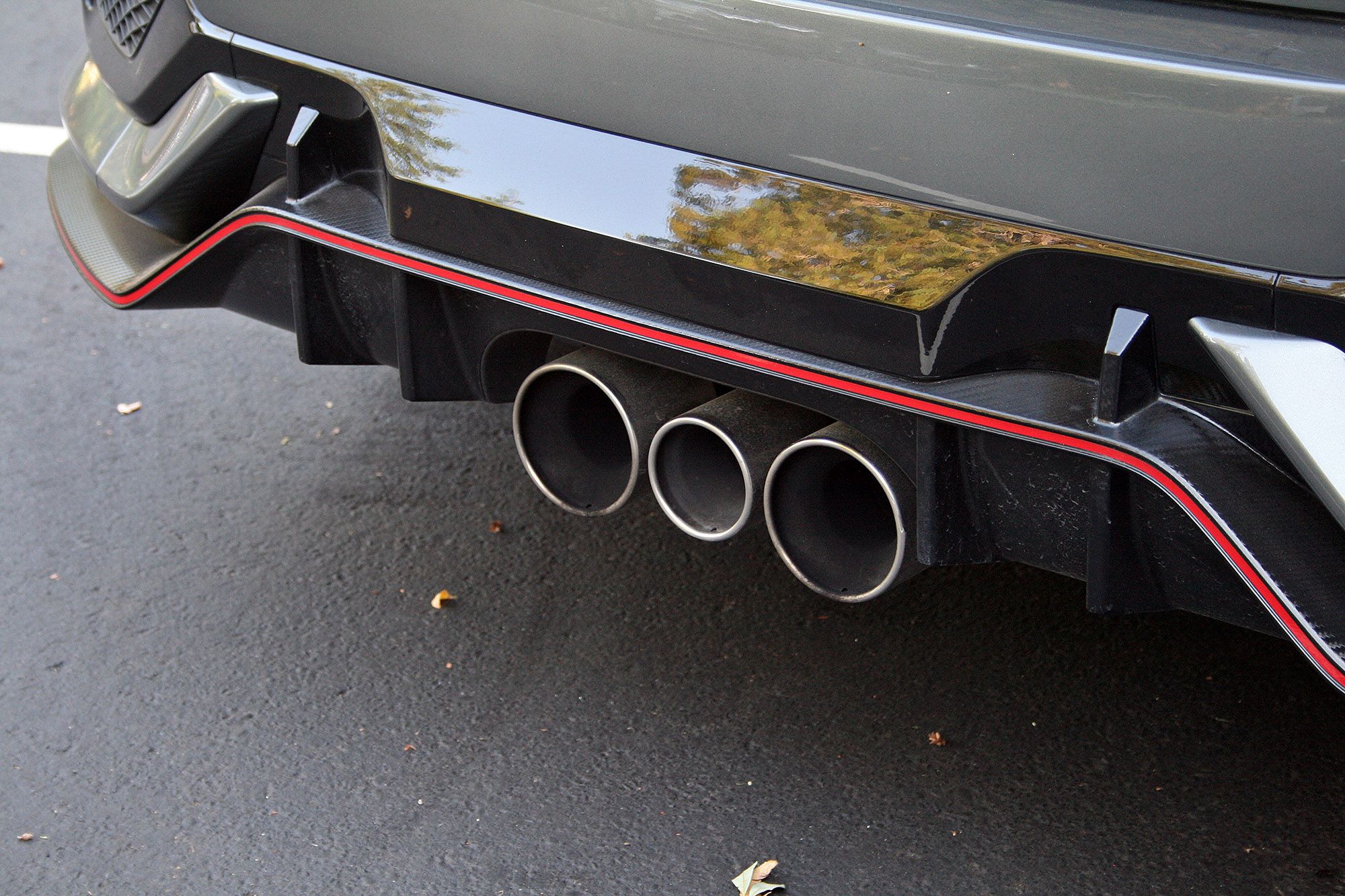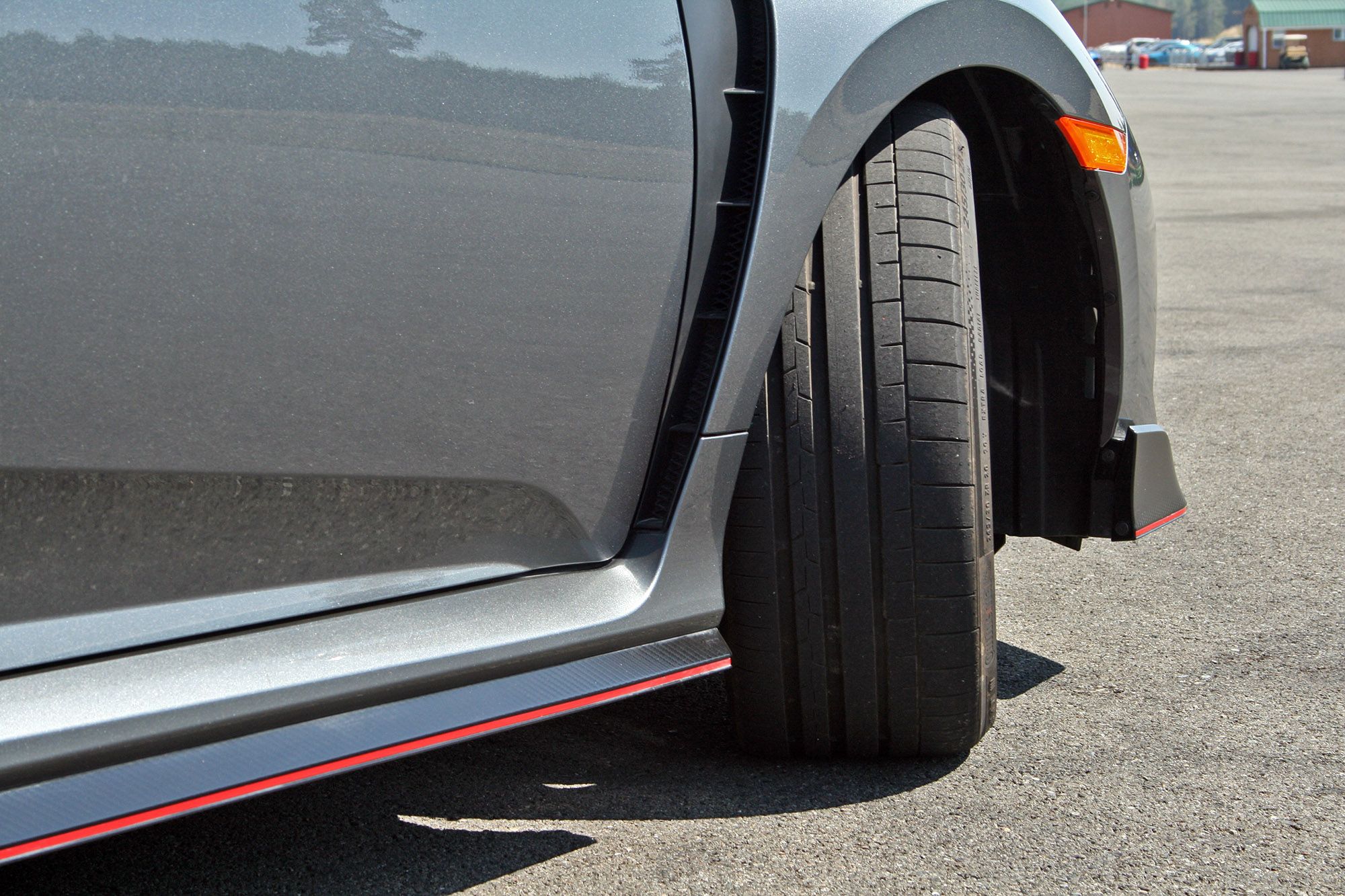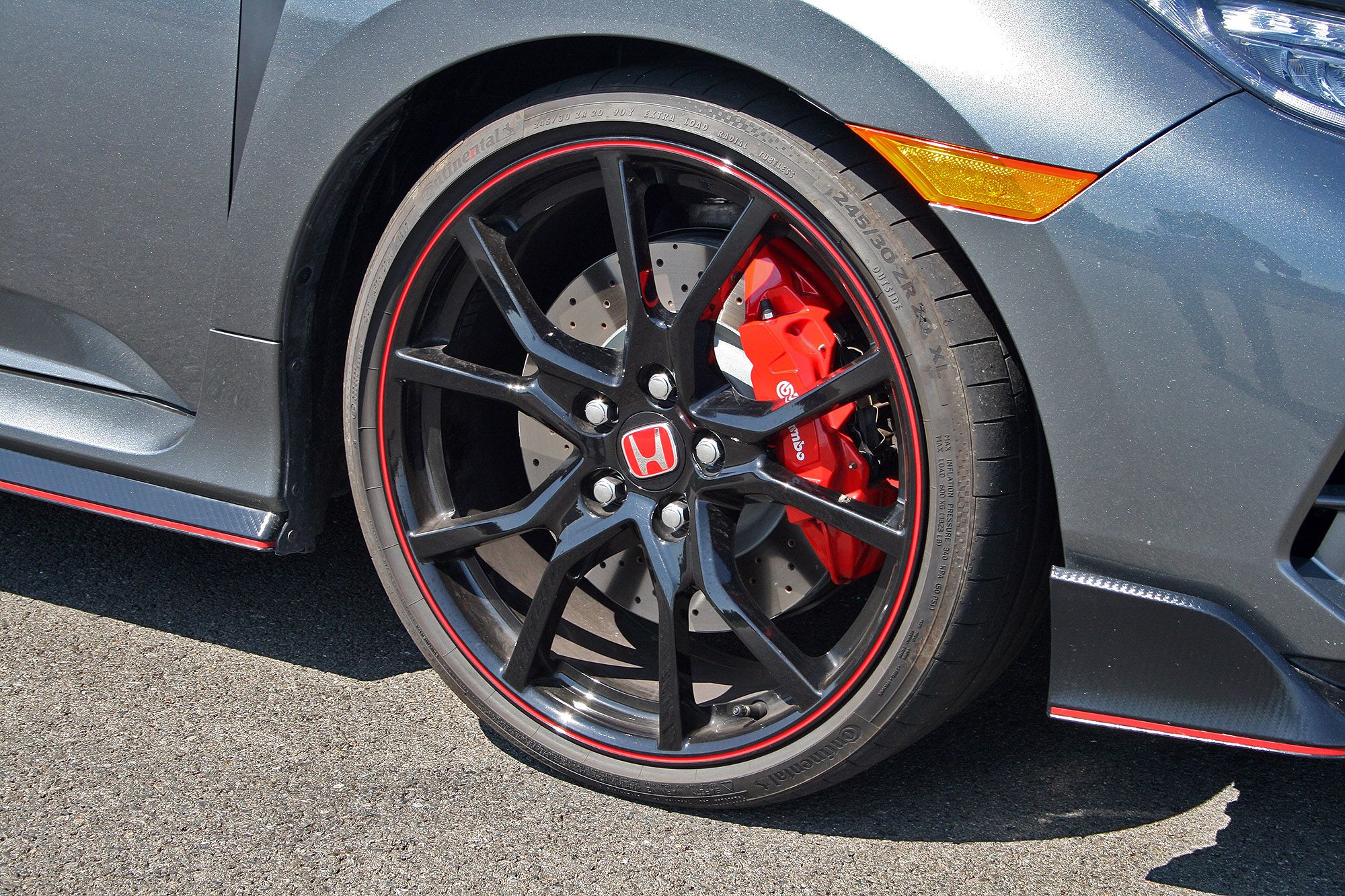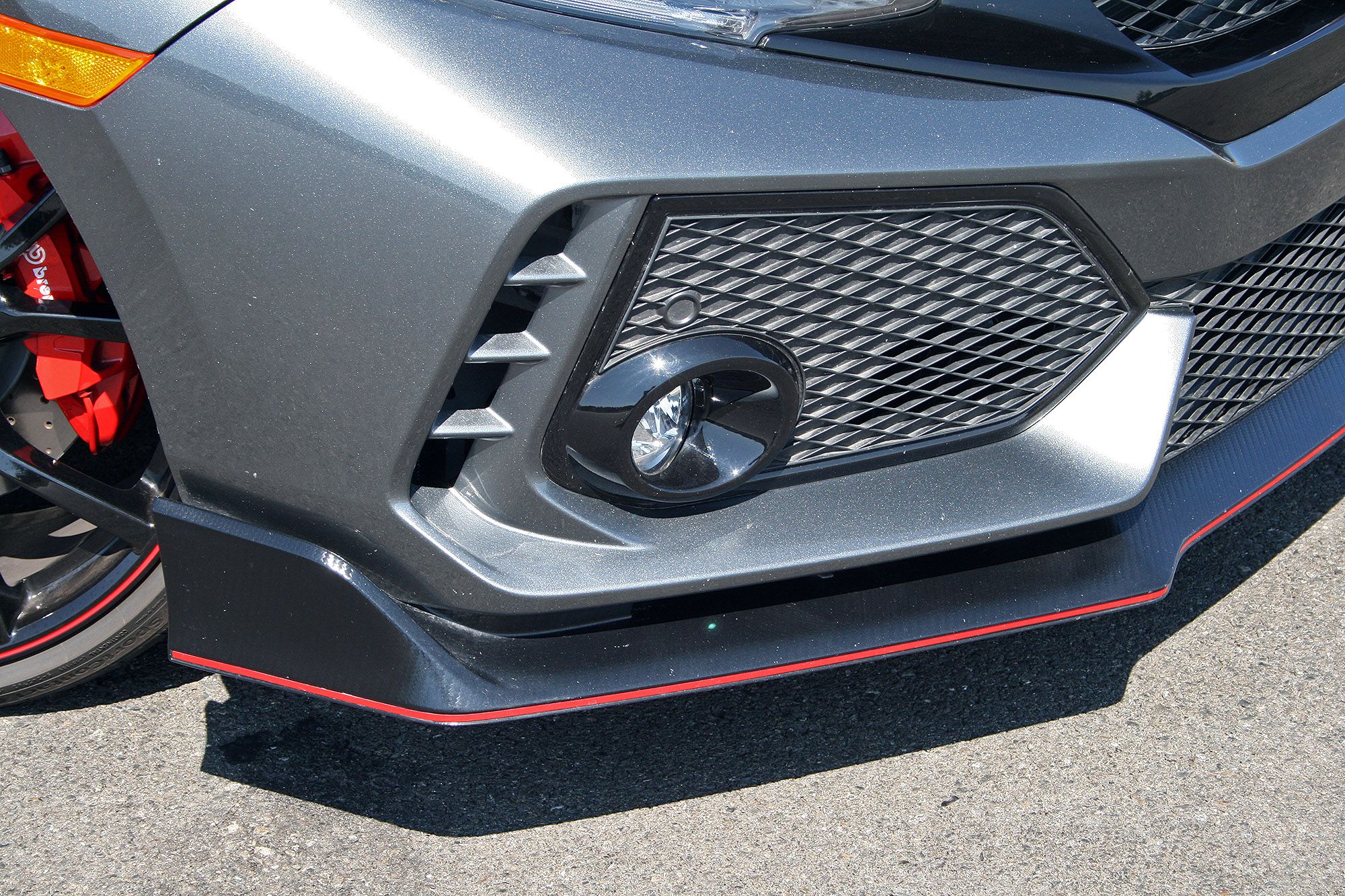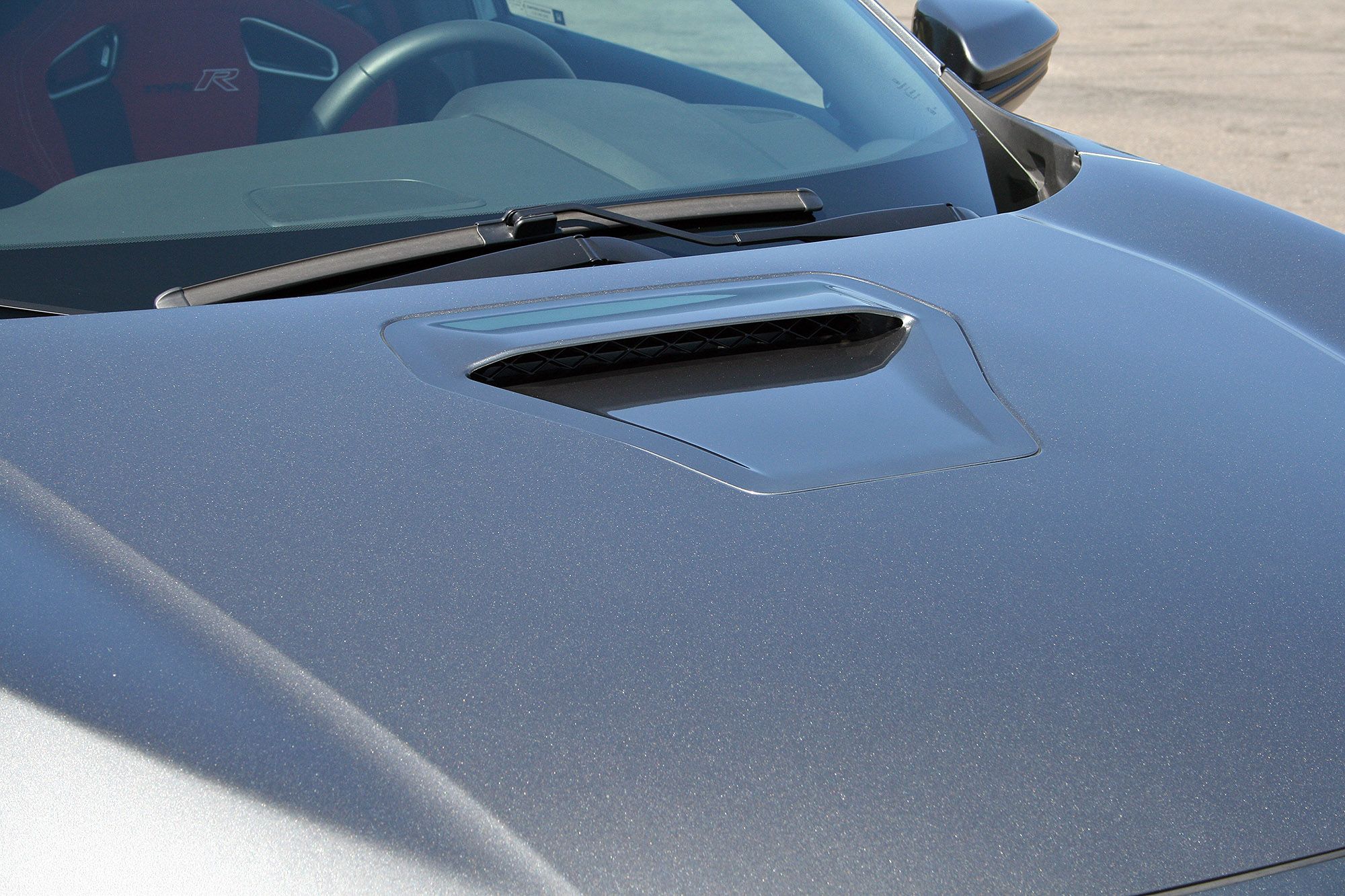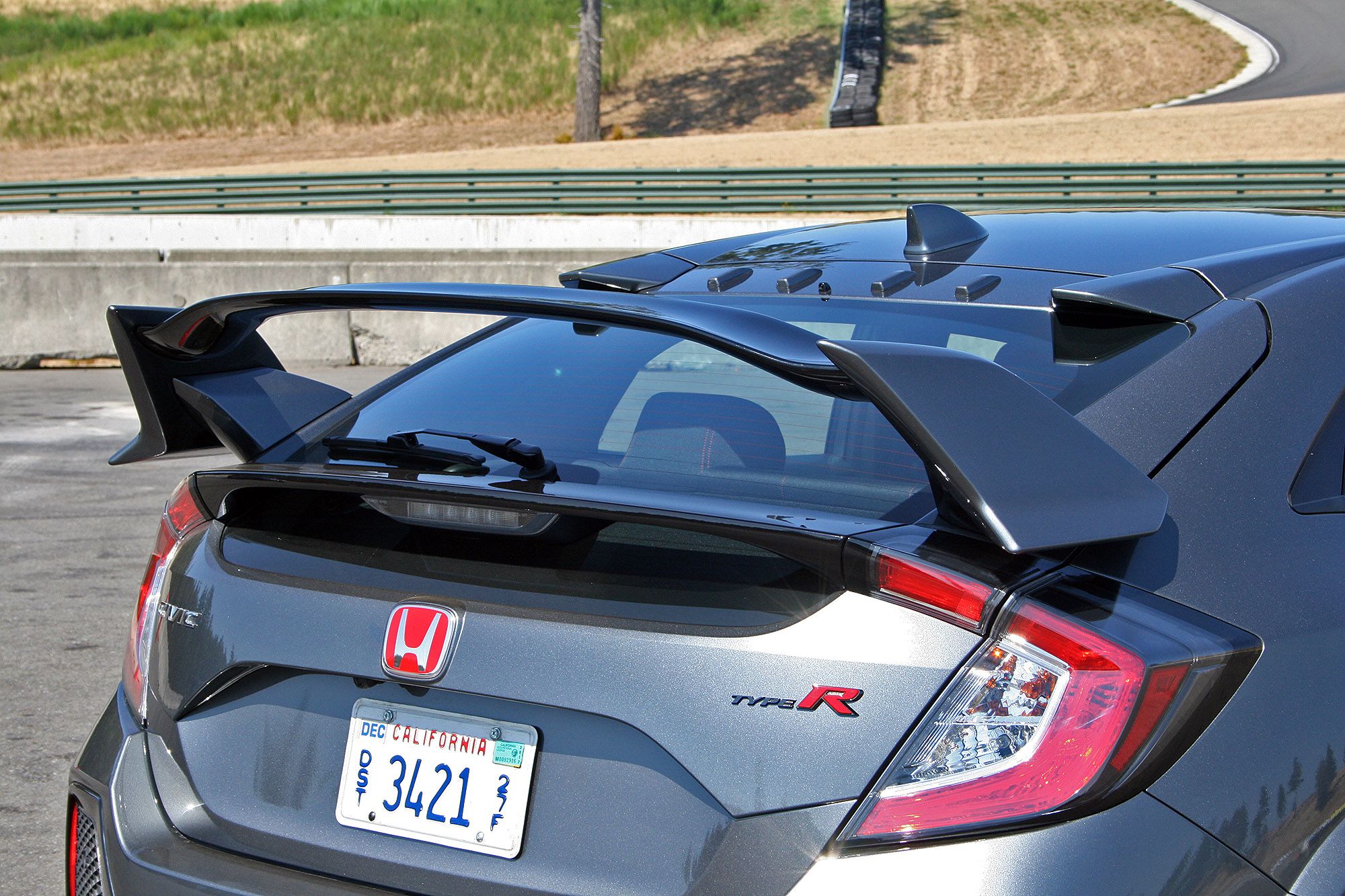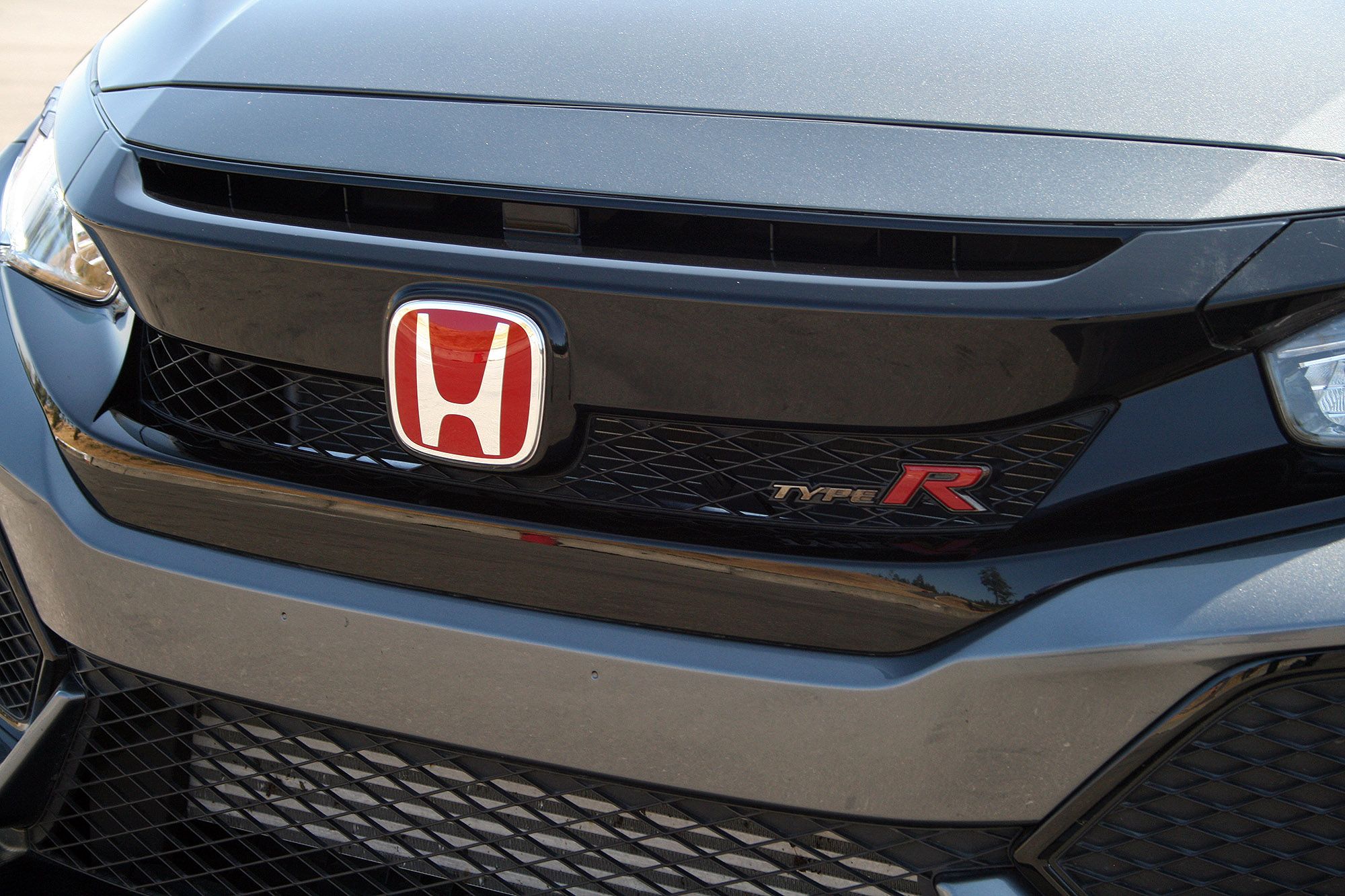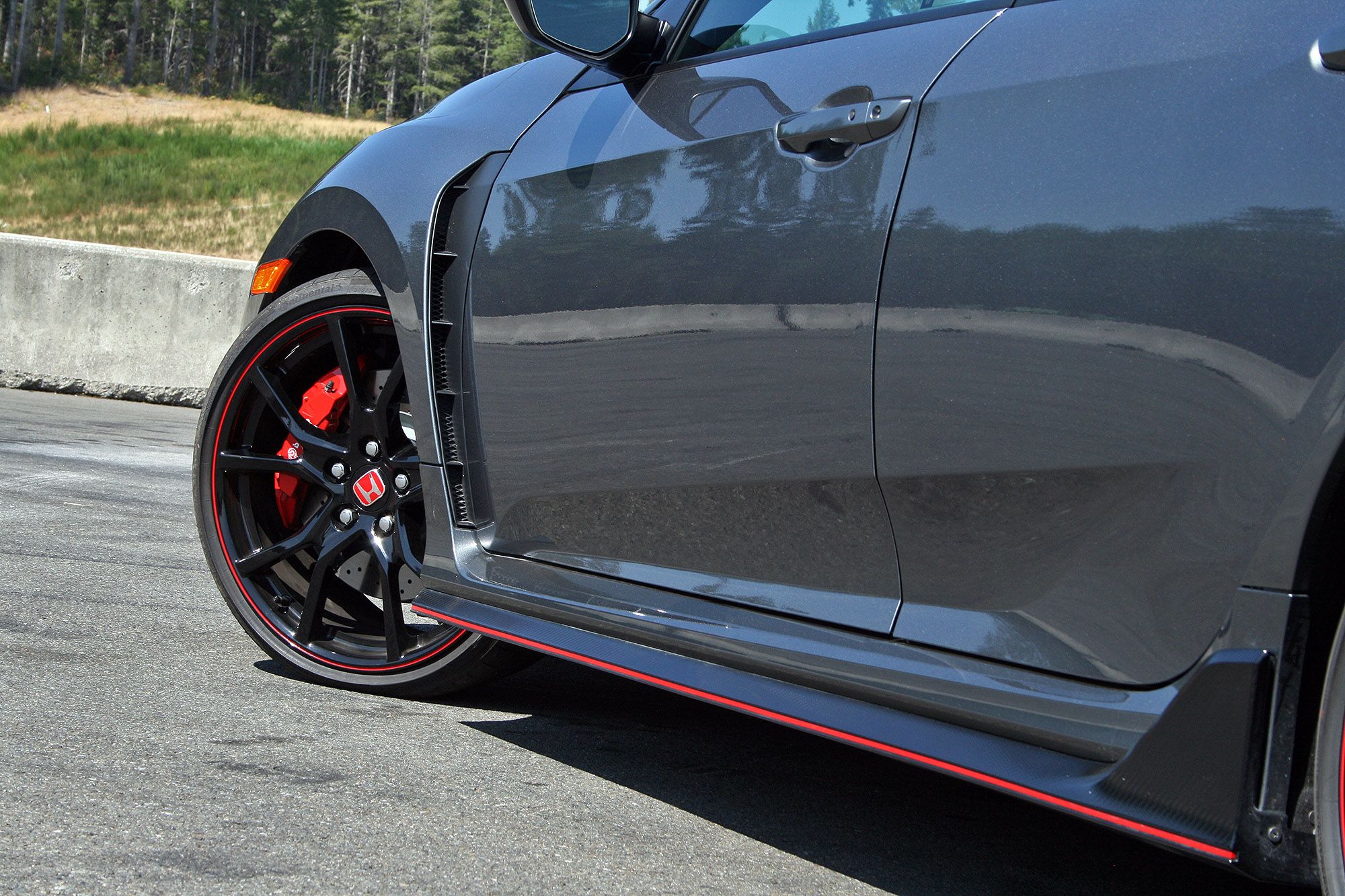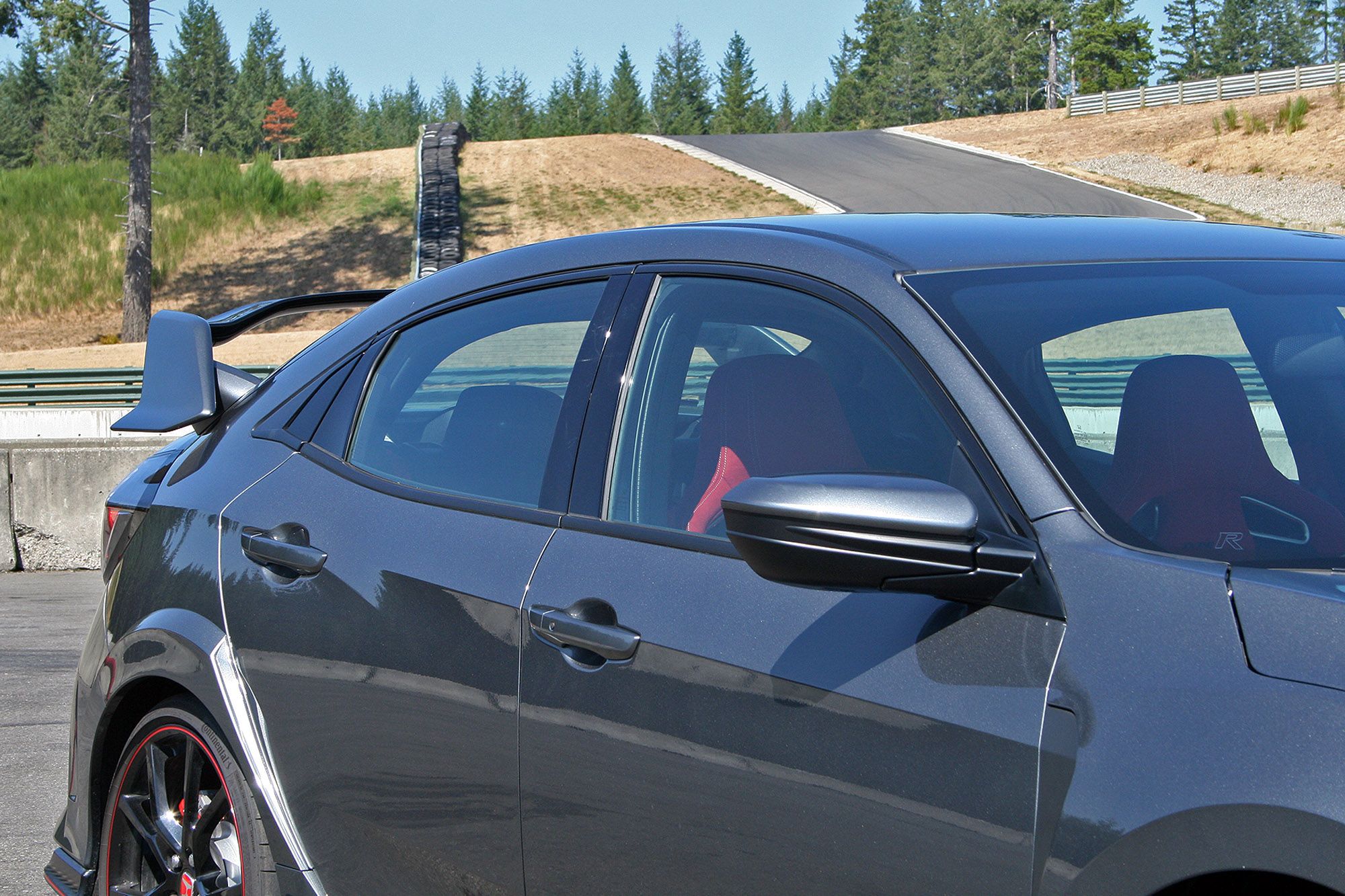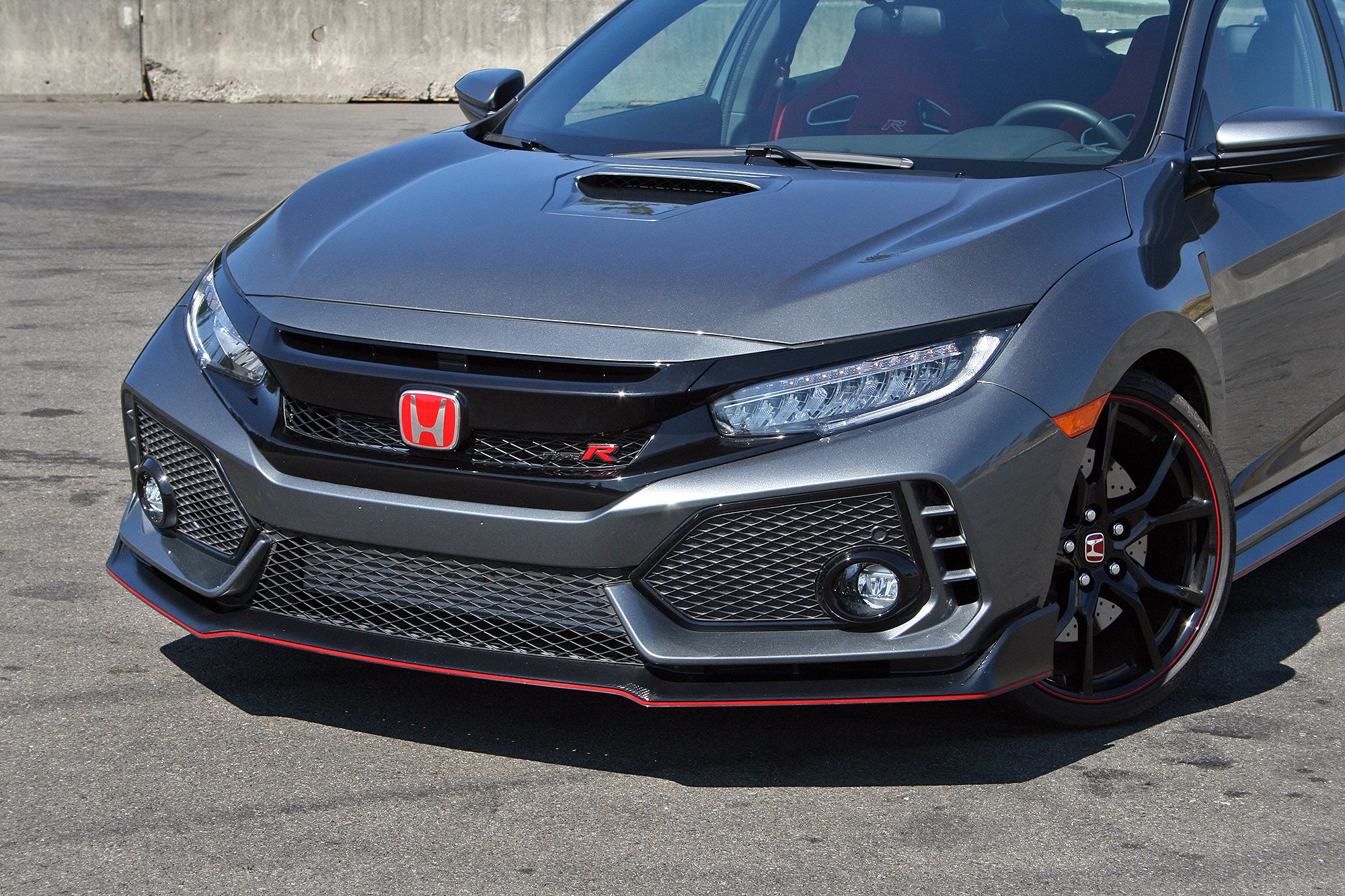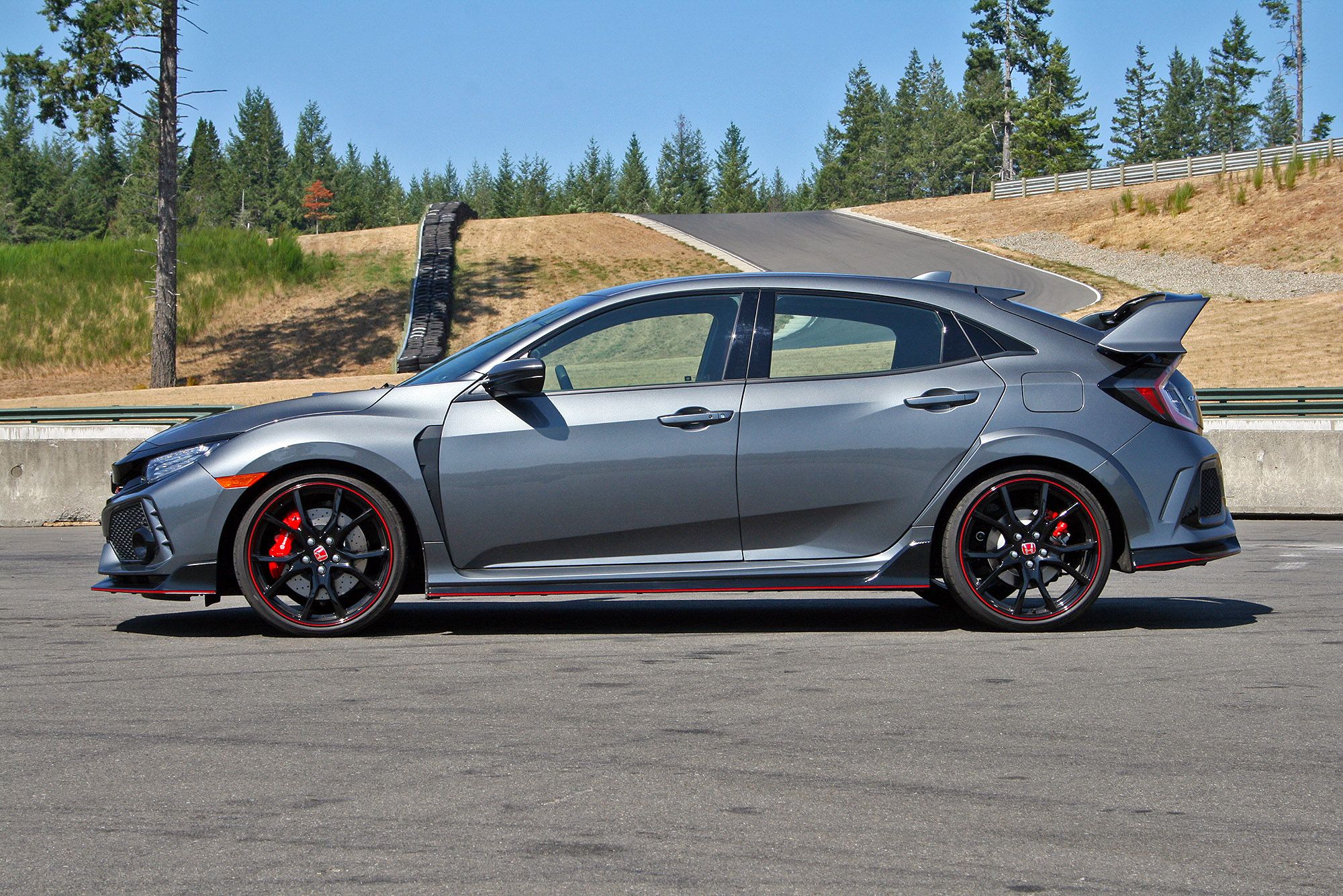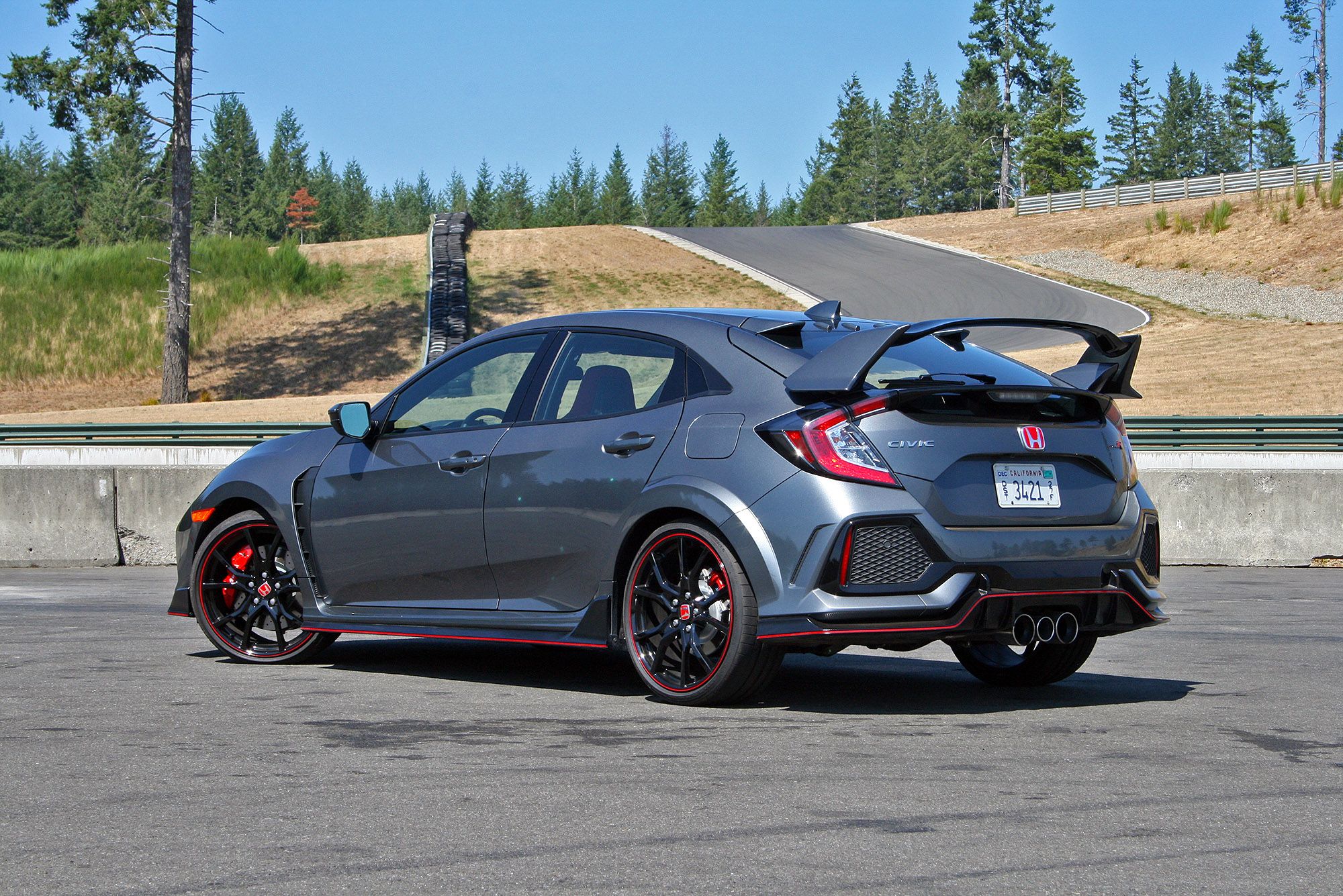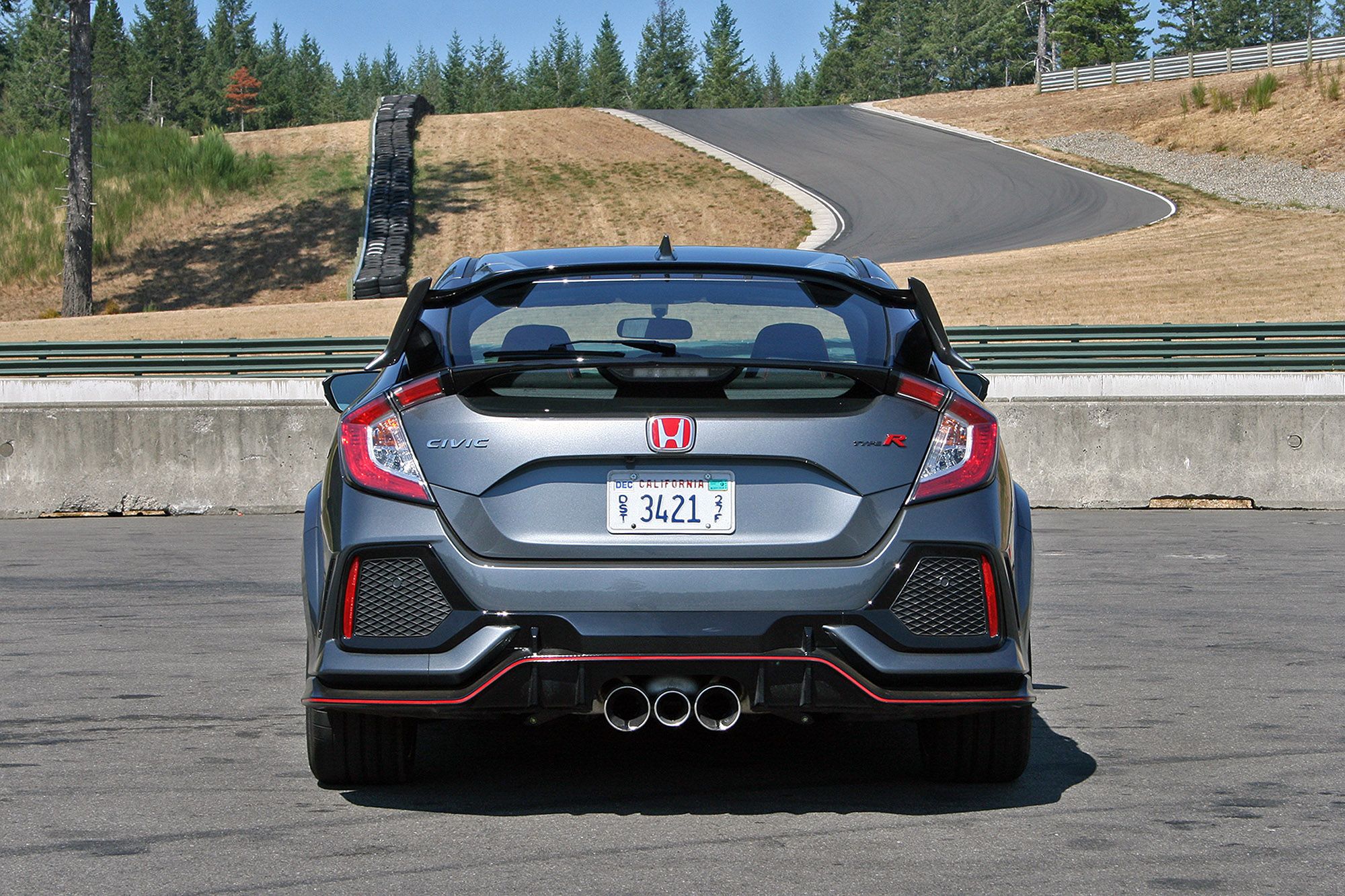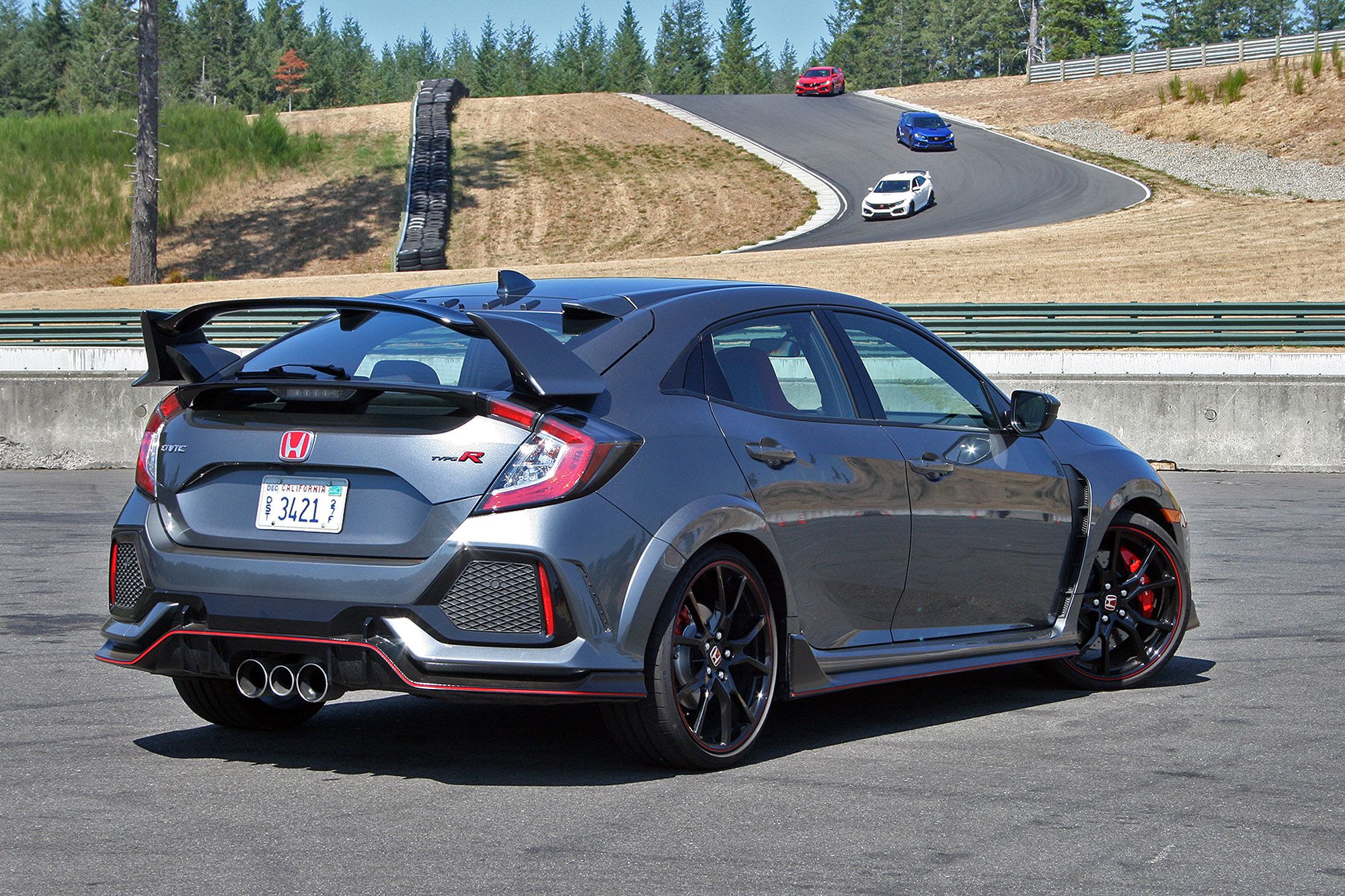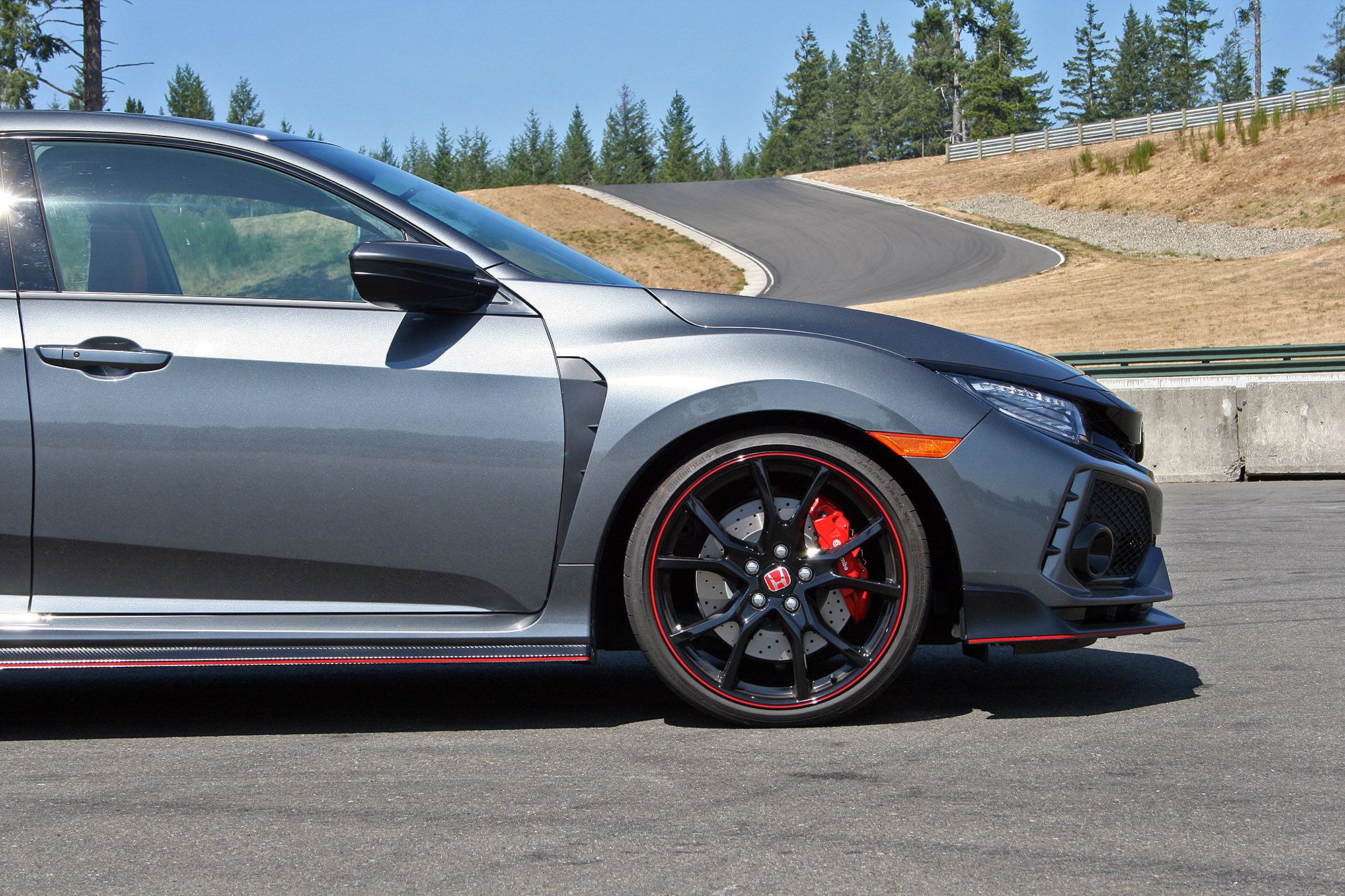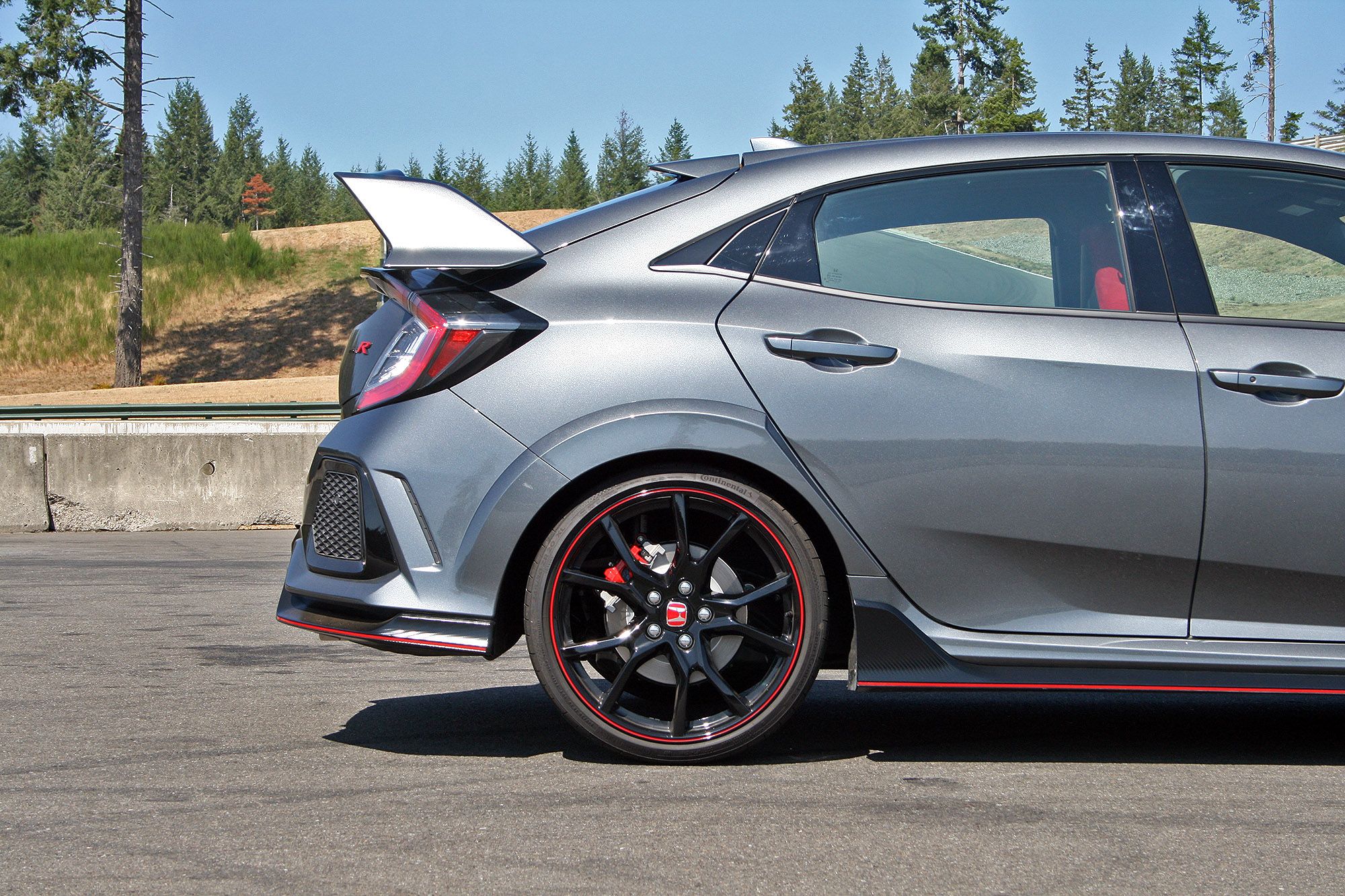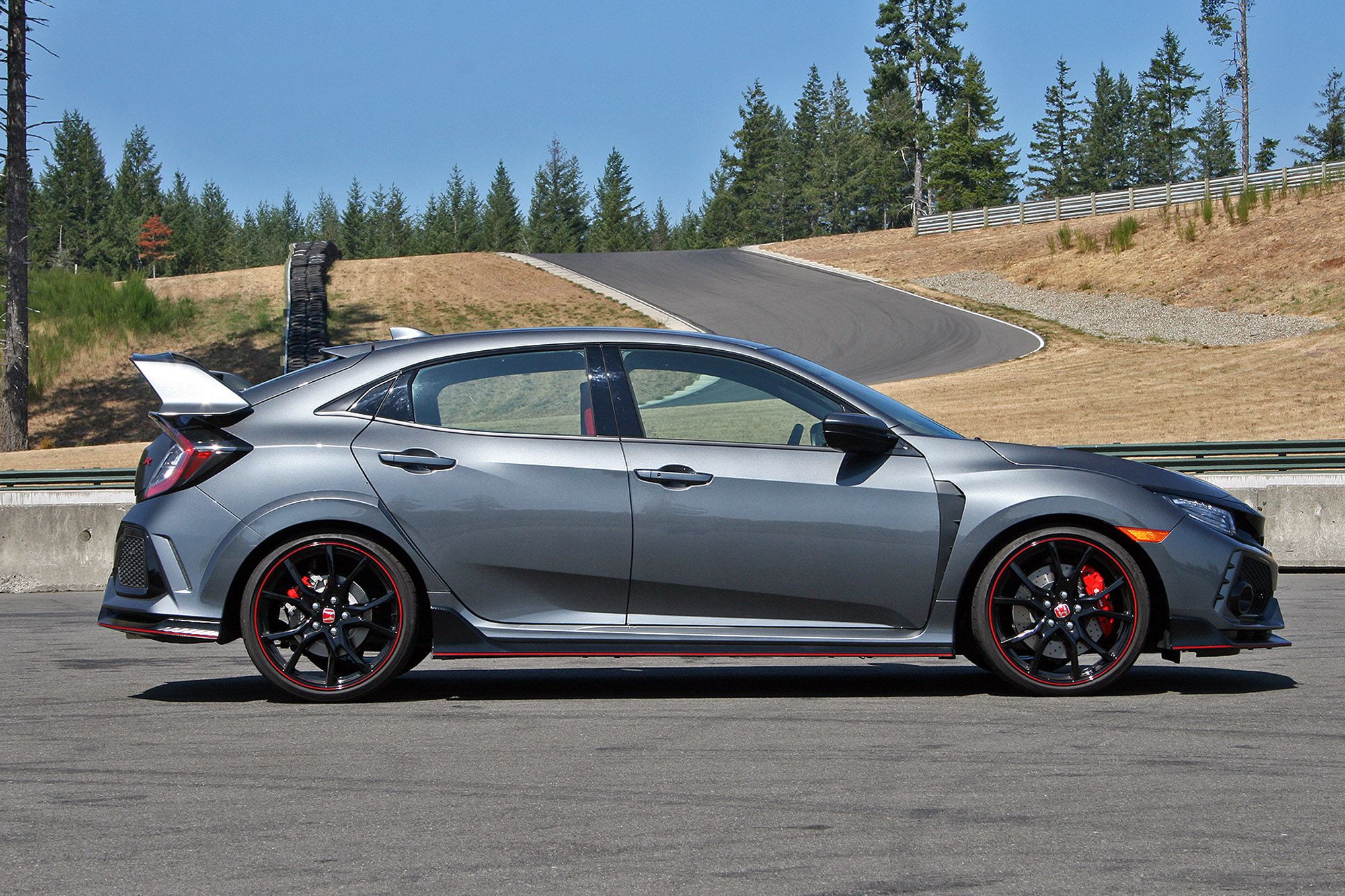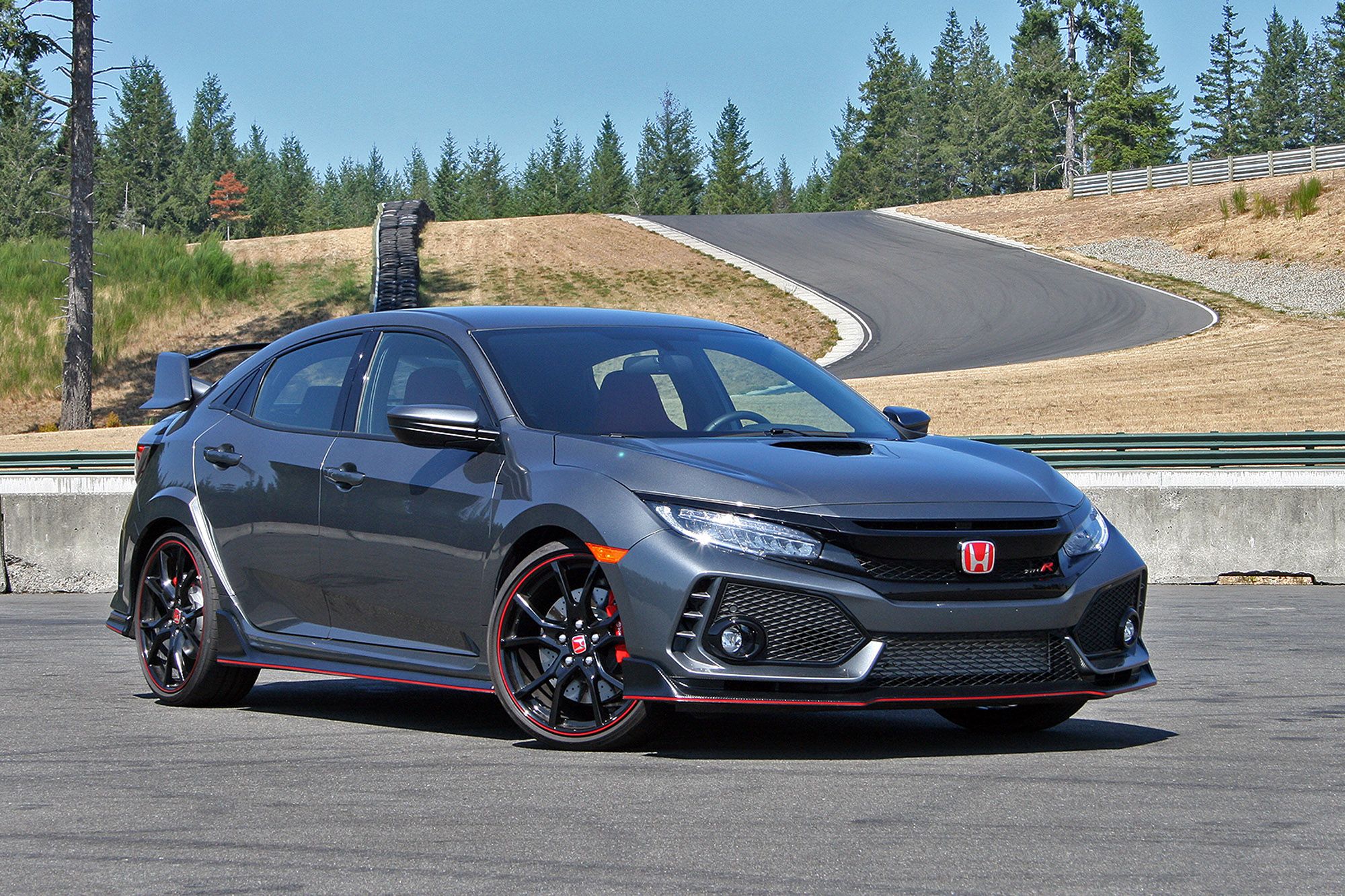Performance vehicles are pushing the envelope beyond the imagination these days. Insane horsepower numbers and bleeding-edge technology contribute to ridiculous lap times and sub-four-second sprints to 60 mph. But more often than not, these all-out performance machines – think Chevrolet Corvette, Jaguar F-Type, and Porsche Cayman – are too compromised for daily living and cost a significant chunk of change. But imagine combining the impressive performance of a two-seater coupe with the functionality of a five-door hatchback and a reasonable price. That’s exactly what that hot hatch segment does. And now for the 2017 model year, Honda has launched its all-new Civic Type R. What’s more, Honda is bringing it to America for the first time.
Based on the new 10th-generation Honda Civic, the new Type R adds power, a sophisticated suspension system, and functional aero to the family-friendly Civic hatchback. It’s like having cake and eating it, too. Now, the Civic Type R has some stiff competition. The 350-horsepower Ford Focus RS is the reigning performance king and the Volkswagen Golf R is the grown-up’s idea of a performance-minded hatchback. And if having a hatchback isn’t a priority but hitting the rally circuit is, there’s always the Subaru WRX STI. The Civic Type R sort of carves its own niche in the segment with an outlandish design, heavily bolstered front buckets, and the lowest starting price of the bunch, but mixes it with only 306 horsepower and the lack of all-wheel drive. To find out how the Civic Type R recipe tastes, Honda flew me to Washington State for time on a private racetrack and scenic drives near the Olympic National Forest. Here’s what I found.
Continue reading for the full driven review.
2017 Honda Civic Type R – Driven
- Make: Array
- Model: 2017 Honda Civic Type R – Driven
- Engine/Motor: inline-4
- Horsepower: 306 @ 6500
- Torque: 295 @ 2500
- Transmission: Six-Speed Manual
- [do not use] Vehicle Model: Array
Video Review
Exterior
There’s no bones about it – visually, the 2017 Honda Civic Type R is a piercing scream in a quiet room. The overemphasized bodywork is impossible to miss, regardless of whether it’s coated in Championship White, Rallye Red, Aegean Blue, Crystal Black, and my personal favorite, Polished Metal. The large air inlets on the front fascia, the hood scoop, the carbon fiber aero bits along the bottom, and of course, that massive rear wing are all yelling for attention. Add to that the tri-pipe exhaust system and its boisterous bellowing. It’s doubtful Honda will see many conquest customers trading their VW Golf R and is reserved styling, but for folks not averse to garnering gawks and stares should find the Type R perfectly aggressive.
As with Type Rs of the past, the 2017 version gets red Honda badges. It’s a signature trait only found on Type R Honda’s range-topping performance variants. Type R badges grace the front grille and rear hatch, too, making sure everyone knows its name. The R rides on ultra low-profile Continental SportContact 6 tires mounted on 20-inch wheels. It’s a square setup, with all four sized at 245/30ZR-20. And despite being thin as rubber bands, the wheels and tires withstood a massive beating I unintentionally dealt out in a construction zone. The six-inch-tall jump in pavement height, even though hit at only 25 mph, should have broken something, yet somehow the Civic survived. Even a Ford F-150 Raptor wouldn’t have been happy to hit that bump.
I see the Civic Type R is a like that millennial kid with the weird hair and hipster outfit in a room full of well-groomed interview candidates dressed in suits. He’s probably better at the job than everyone else, but HR will question whether his demeanor is a good fit for the company.
Exterior Dimensions
|
Wheelbase (Inches) |
106.3 |
|
Length (Inches) |
179.4 |
|
Height (Inches) |
56.5 |
|
Width (Inches) |
73.9 |
|
Track (front/rear) (Inches) |
63.0 / 62.7 |
Interior
The great thing about the Civic Type R is none of its performance upgrades interfere with its practicality and everyday livability. Aside from the front seats, flat-bottom steering wheel, and carbon fiber and red accents, the cabin could be mistaken for any standard Civic – and that’s a good thing. Honda says they’ve based the Type R’s options on the Civic Touring, the most well equipped version of the car. This makes sense as the Type R fulfills the halo roll in the Civic lineup. About the only items missing from the Touring package are power-adjustable front seats and the Honda Sensing safety suite – both of which are absent to save weight.
As for comfort, the front buckets are surprisingly livable. Despite their heavy bolsters, they are easy to get into and out of. The cloth upholstery remains mostly cool, even when you’re working up a sweat flogging the car around a track. The headrests aren’t adjustable, but they are perfectly placed to accommodate a helmet. In fact, I had no issues with my helmet banging around the cabin, giving me full mobility to check blind spots for slower racers. Getting comfortable is also easy thanks to a tilt and telescope steering column with tons of motion.
Honda’s infotainment system takes some learning and is laced with several annoyances. The lack of a physical volume knob is a chief complaint, but a finicky navigation system that doesn’t always know its location is a biggie, too. Perhaps it was the tall hills along the 101 along the Hood Canal, a Fjord connected to the Puget Sound, but the Garmin-based system acted like a schizophrenic as I drove north toward the Fort Worden State Park. Thankfully, Apple CarPlay and my phone-based navigation came to the rescue with a better sense of direction.
As for cargo room, the Civic Type R is fantastic. It offers 25.7 cubic feet of room behind the second row and an impressive 46.2 cubic feet with the 60/40-spit second row folded flat. That beats out the Ford Focus RS in both categories and the Volkswagen Golf R with its seats in place. (The Golf R does offer 52.7 cubic feet with its second row folded.)
Interior Dimensions
|
Headroom (front/rear) (Inches) |
39.3 / 37.4 |
|
Legroom (front/rear) (Inches) |
42.3 / 35.9 |
|
Shoulder Room (front/rear) (Inches) |
56.9 / 55.0 |
|
Hiproom (front/rear) (Inches) |
53.7 / 48.8 |
|
Cargo Volume (rear seat up/down) (cu. ft.) |
25.7 / 46.25 |
|
Passenger Volume (cu. ft.) |
97.0 |
|
Seating Capacity |
4 |
Drivetrain
At the heart of the Civic Type R is its 2.0-liter turbocharged four-cylinder The all-aluminum engine features Honda’s VTEC system operating its 16 overhead valves and the fire is fed with direct fuel injection. Sodium-filled exhaust valves and a lightweight rotating assembly help the engine reach its 7,000-rpm redline with a quick blip of the throttle.
An intercooler keeps intake air temperatures in check and that hood scoop directs air behind the engine for cooling and to help eliminate under-hood lift thanks to a dedicated airflow path under the car. Oil jets squirt at the underside of the pistons, helping both with cooling and lubrication. Even the two-piece exhaust manifold is water-cooled. It’s clear Honda wants this engine to last. The exhaust finished off with a unique dual muffler design and a center resonator – each with their own exit. Honda says the center resonator is mostly used to control mid-rev booming, while the outer pipes bellow air at higher revs.
The Civic Type R isn’t the most powerful in the hot-hatch segment. It generates 306 horsepower at 6,500 rpm and 295 pound-feet of torque between 2,500 and 4,500 rpm. Compare that to the Ford Focus RS’ 350 horsepower and 350 pound-feet of torque. However, the Type R is well equipped to fight the Volkswagen Golf R and Subaru WRX STI. The Golf R only makes 292 horsepower and 280 pound-feet of torque and the Subaru is nearly dead even at 305 horsepower and 290 pound-feet of torque. Then again, by eliminating the Ford as the over-achieving outlier, the Type R becomes the most powerful in its segment.
The Civic Type R comes exclusively with a six-speed manual transmission and front-wheel drive with a limited-slip differential. The gearbox has a fantastic, short-throw shifter that makes quick work of gear changes. The pattern is well defined and easy to hammer through, though the four-to-five upshift does take some extra thought. And despite the Type R only being FWD, it never felt short on traction. I didn’t disable traction control and try a burnout, but between spirited driving on the street and at-the-limit driving on the racetrack, I never felt the front tires have issues. Credit is due to that limited-slip differential and those 245/30-series Continental SportContact 6 tires.
Honda has nearly eliminated torque steer thanks to its dual-axis front MacPherson struts. Basically it boils down to having the steering knuckle mounted further outboard of the MacPherson strut with its upper and lower mounting points creating a parallel line with the strut.
The Type R has three drive modes: Comfort, Sport, and +R. Each are self-explanatory as to their role, but it’s spurring just how much difference each mode makes. Comfort mode settles the car into a lull, making highway cruising more relaxed. Sport mode is perfect for back roads and on-road fun. The racetrack is where +R is best utilized. It stiffens the adaptive dampers, makes the throttle super responsive, and tightens the already tight steering. It also dials up the responsiveness of the active rev matching system.
The lack of AWD doesn’t hurt performance specs, either. In fact, the reduced weight helps this 3,100-pound hatchback hit 60 mph in 4.9 seconds and through the quarter-mile in 13.5 seconds at 108 mph. Compare that 0-to-60 mph time to the 3,459-pound Ford Focus RS’ 4.7-second run and the 3,391-pound Subaru WRX STI’s 4.6-second time. Yeah, AWD isn’t looking so advantageous, is it?
What’s more, when driving normally, the EPA estimates the Civic Type R will get 22 mpg city, 28 mpg highway, and 25 mpg combined.
Drivetrain Specifications
|
Engine Type |
Turbocharged In-Line 4-Cylinder |
|
Turbocharger |
Single-Scroll MHI TD04 with Internal Wastegate |
|
Boost Pressure |
22.8 psi |
|
Displacement (cc) |
1,996 |
|
Horsepower (SAE net) |
306 HP @ 6,500 RPM |
|
Torque (SAE net) |
295 LB-FT @ 2,500-4,500 RPM |
|
Fuel economy (City/Highway/Combined) (mpg) |
22 / 28 / 25 |
|
Curb Weight (lbs.) |
3,117 |
|
0 to 60 mph |
4.9 seconds |
|
Quarter-mile |
13.5 seconds at 108 mph |
|
Top Speed |
169 mph |
Behind the Wheel
At The Track
The 2017 Honda Civic Type R has been highly anticipated here in America and I can confidently proclaim it’s been well worth the wait. The car handles beautifully and quickly grows to be an extension of the driver. Sitting the in heavily bolstered seats and positioned for on-track driving, the Type R feels like a tailored suit. The controls are easy to reach, the pedal are perfectly placed, the shifter lands right where you’d expect, and the steering column is highly adjustable. Outward visibility is great, further creating a sense of oneness with the car.
Toggling the drive mode selector into +R mode, the Type R instantly feels more edgy. The throttle mapping becomes itchier, ready for blips and quick climbs to its 7,000-rpm redline. The adaptive dampers firm up to eliminate any body roll. The clutch has a short travel with a light action allowing for quick shifts with minimal effort. The variable-ratio steering system gets heavier in +R mode, too, and does a great job at translating road feel through the wheel.
Lined up behind Honda’s tame racing driver in the lead car, I spent six laps dancing with the Type R at The Ridge Motorsports Park in Shelton, Washington, just northwest of Olympia. The 2.47-mile track has 16-turn and more than 300 feet in elevation changes, the most dramatic of which is a 50-foot drop along Turn 14 in a section affectionately called The Complex. The Type R warmed up quickly and grip proofed tremendous from the Conti tires. Pushed hard into a turn, understeer does raise its ugly head and only once did I feel the back want to slide around. Honda’s rev-match system works wonderfully at simulating heel-toe action, but is less noticeable than the other rev-match system I’ve sampled. It simply works.
As for power, the Type R’s 306 horsepower feels perfectly matched with the car. Only on the long straightaway did I find its limit, hitting 120 mph in fifth gear at edging toward 6,500 rpm. Most of The Ridge is done is third and fourth gear, making the Type R feel more torquey than its on-paper stats suggest.
The relatively large 13.8-inch front and 12.0-inch rear Brembo brakes do a great job at slowing the car and showed no signs of fade, even after being on track all morning with journalists cycling through. The car brakes hard and straight with no shimmy in the steering or lockup in the wheels. Pedal feel is linear, with input directly correlating to braking force. The initial bite is predictable and nearly instant, but without feeling too grabby.
On The Road
When not tearing around a racetrack in +R mode, the Civic Type R feels somewhat subtle. Slip the drive mode into Comfort mode and the adaptive dampers smooth the ride, the steering becomes lighter, and the throttle isn’t as edgy. The light clutch and short throw shifter kept me happy even when fighting city traffic. Sport mode is well suited for twisty back roads. Honda programmed the setting to provide a good mix of performance and refinement. Throttle response is more fun and the dampers and steering provide more feedback from the road, yet it’s not punishing.
On the highway in Comfort mode, the transmission’s 0.74:1 overdrive ratio isn’t terribly low, so revs stay around 3,000 rpm at 70 mph Still, the engine’s exhaust note doesn’t drone. Unfortunately, road noise does – especially from the rear tires. The Type R also lacks Blind Spot Monitoring and its backup camera has a pretty low resolution and narrow view. As mentioned, the Garmin-based navigation had some issues in the hills of western Washington. The same is true for the SiriusXM radio’s reception.
Despite its few flaws, the Civic Type is much easier to live with than the Ford Focus RS and provides a more refined driving experience than the Subaru WRX STI. Only the Volkswagen Golf R has it beat in terms of everyday livability.
Pricing
The 2017 Honda Civic Type R comes well equipped with the 7.0-inch infotainment system with navigation, Apple CarPlay, and Android Auto, while a 540-Watt sound system with 12 speakers brings the beats. Honda doesn’t offer any option packages or upgrades to the Type R, meaning that aside from dealership add-on accessories, they are all created equal. The starting price is $33,900 plus an $875 destination fee. That brings the price to $34,775.
The Competition
2016 Ford Focus RS
Ford currently has the hottest hot hatch in the segment with its Focus RS. It reigns supreme in the horsepower wars and comes standard with a six-speed manual transmission and AWD. Ford even offers Michelin Pilot Sport Cup 2 tires as optional equipment, making the Focus RS a true track start. Its body is slightly upgraded over the standard Focus with a more aggressive front grille, a low-slung rear fasica, and a big wing hanging off the rear hatch. Inside, Ford gives the RS some Recaro front bucket seats, a flat-bottom steering wheel, an extra gauge pod above the dash, and not much else. In fact, the Focus RS has a rather dull interior with a sea of black, low-buck plastic.
Under the hood is the 2.3-liter EcoBoost four-cylinder making 350 horsepower at 6,000 rpm and 350 pound-feet of torque at 3,200 rpm. This all-aluminum engine mates to a six-speed manual and a torque-vectoring AWD system that can send 70 percent of power to the rear wheels. Four drive modes control the car’s overall attitude. Modes include Normal, Sport, Track, and Drift. Yeah, the AWD Focus RS will actually get sideways in a tail-happy power slide – not that it’s any good for anything besides showing off or competing in a drift competition.
Ford is very proud of the Focus RS – it’s charging $36,120 as the base price. If you want a few comfort features, you’ll have to shell out $2,785 for the RS2 package. Should you need the summer-performance Michelin tires on upgraded 19-inch wheels, that’ll be another $1,990. The 2016 Focus RS I tested carried a sticker price of $41,550.
Read our driven review on the 2016 Ford Focus RS.
2018 Subaru WRX STI
The Subaru WRX STI has been the default champ of rally races and all-weather speed for decades. For 2018, Subaru slightly updated the WRX STI with a new nose, a new electronically controlled center differential, new 19-inch wheels, and larger Brembo brakes. Beyond that, the car remains unchanged. That’s disappointing considering Subaru gave the Impreza sedan (the car on which the WRX and WRX STI are based) an entirely new chassis, exterior design, and interior diggs. Still, the STI is only three years old for 2018, so we’re expecting larger update in the coming years.
Power comes from Subaru’s tried-and-true 2.5-liter Boxer turbocharged four-cylinder. It generates 305 horsepower at 6,000 rpm and 290 pound-feet of torque at 4,000 rpm. A six-speed manual transmission does the shifting while a full-time AWD system routes power to each wheel. Subaru’s new electronically controlled center differential is said to be quicker to respond than the electro-mechanical diff from before, yet still allows the driver to dial in the amount lock-up between the front and rear axles. Behind the wheel, the Subi is a hoot to drive and makes dirt roads immensely fun.
Pricing starts at $36,095 for the 2018 model. Opt for the Limited trim level and the price jumps to $40,895. Stand-alone options are limited, so prices won’t crest too far beyond that.
Read our driven review on the 2018 Subaru WRX STI.
2016 Volkswagen Golf R
The Volkswagen Golf R is the most mature of the hot hatches, foregoing the crazy bodywork and outlandish interior trim. Rather, this understated hatch simply delivers performance without bragging about it first. Its aesthetics are bolder than a standard Golf, but parked beside the Ford, Subaru, or Honda, the Volkswagen looks the most conservative. The interior does get nicely bolstered front seats and chrome and piano-black accents. Sadly, the Golf R is getting a bit long in the tooth, now bringing up the rear in terms of power and performance.
That power comes from a 2.0-liter turbocharged TSI four-cylinder making 292 horsepower at 5,400 rpm and 280 pound-feet of torque between 1,800 and 5,500 rpm. The engine relies on a heavy iron block, but does get aluminum cylinder heads with direct fuel injection. Volkswagen does offer two transmission choices – a sweet six-speed manual and a quick-shifting six-speed DSG automatic. Both are paired with VW’s 4Motion AWD system from Haldex. The Golf R also comes with DCC, or Dynamic Chassis Control, with three drive modes – Comfort, Normal, and Race.
Pricing for the Volkswagen starts at $35,650 for the 2017 model year. Checking every option box will inflate the price past $40,000.
Read our driven review on the 2016 Volkswagen Golf R.
Conclusion
it’s clear Honda has done its homework. It designed the 10th Civic’s chassis with the Type R’s sporty intentions in mind. It didn’t fiddle with a heavy AWD system. It didn’t have to overstress the engine to compensate for added weight. It didn’t need to call Recaro or Sparco for good seats. And yet Honda managed to post a Nürburgring lap time of 7:43.80 – a world record for the fastest FWD vehicle on the planet.
The 2017 Honda Civic Type R is a legitimate contender in the hot hatch market – that much is irrefutable. Its 306 horsepower makes it the most powerful in the segment outside the Ford Focus RS and its 3,100-pound curb weight translates into a nibble, tossable package that’s willing to play. Its sticky tires provide nearly endless grip and its adaptable dampers offer real-world benefits in ride and handling. Of course, the Civic Type R isn’t perfect. Those 245/30-series sidewalls are awful thin for anything past fresh pavement, the seats don’t have lumbar adjustments, the infotainment system can be finicky, and some folks will consider the Type R’s styling a bit too juvenile.
Nevertheless, the Civic Type R is currently the newest and most well-positioned hot hatch in the segment. That alone makes it a top competitor since Honda knew where to aim. As for which one to buy, it’s hard to argue against the Civic Type R’s impressive performance and everyday livability matched with the lowest price in the segment. You’ll just have to be fine with its aggressive curb appeal.
References
2017 Honda Civic Type R
Read our full review on the 2017 Honda Civic Type R.

